



Two years after his death, Harun Farocki continues to maintain an archetypal role in the world of the visual arts. Many mourned for the loss of a gifted artist who was as not just a filmmaker but a critic, activist and philosopher en masse. Farocki succeeded his German New Wave filmic predecessors as his work would seamlessly and at once command hilarity, disparagement and intellect. A project-retrospective collaboration of his work was undertaken, just two years after his death, with its first part at The Institut Valencià d’Art Modern (IVAM) named ‘What is at Stake’, and more recently the second-part titled ‘Empathy’at the Fundació Antoni Tàpies compiled of at least 8 works focusing on an analysis of labour within the framework of capitalist demands.
The title of the exhibition, ‘Empathy’ originates from Ancient Greek; ‘εμπάθεια’ is a compound of ‘έν’ and ‘πάθος’ meaning ‘moved by passion’. In German, empathy translates to ‘Einfühlung’ and was ironically exploited by Farocki in 2008 as the title for his text and reads:
‘A compound of Eindringen (to penetrate) and Mitfühlen (to sympathize). Somewhat forceful sympathy. It should be possible to empathize in such a way that is produces the effect of alienation.’
Taking into account Farocki’s liking of Brechtian ‘distanciation’, he formulated rather quickly that to ‘empathise’ means to project one’s own feelings, therefore infiltrating objective opinion. The notion of ‘empathy’ for Farocki was carefully tailored to a synthesis that gave him the patience to be simultaneaously attentive and austere towards his subjects’ predicaments. As paradoxical as it may seem, empathy and distance are nurtured companions. With Farocki’s interpretation of empathy in mind, I entered the dark bunker where the retrospective took place. A space usually leaking brightness from the glass roof was now transformed into an industrious zone of projections, obsolete TV sets and the mellifluous humming of those operative machines. Farocki’s filmic oeuvre overflowed from devices onto white surfaces, accentuating the techno-capitalistic condition of labour operating eradically for our Western communities.
As you enter, the video-installation of Workers Leaving the Factory in Eleven Decades (2006) dominates the center. Twelve TV monitors are laid out in a horizontal line, juxtaposing chronologically the moment where the worker leaves the factory in Farocki’s twelve chosen films – among them, Workers Leaving the Lumiére Factory in Lyon (1895), Deserto Rosso (1964) and Dancer in the Dark (2000). Here, the excerpts are used as a mnemonic tool as Farocki’s montage gravitates around the entrance of each factory. Each scene extrapolates the repetition of entering as a rhetorical techne, an emphatic mimesis of organising and preserving power through the image of the factory and its systems of subjugation. Yet, distance and empathy are circular and procedural.
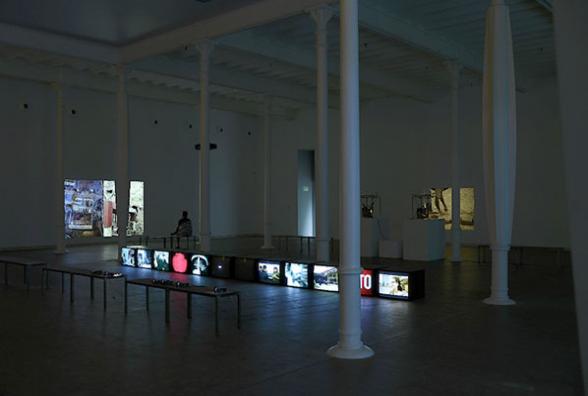
Curated to encourage a clockwise movement following the introductory piece, A New Product (2012) is being televised to the left. It commences during a mundane corporate board meeting for a consulting company violently regurgitating neoliberal logic. The goal of the meeting is to amplify competition and ascertain efficiency of their employees in the workplace by creation of a new product. Through the repetitive flipping of charts and reports, Farocki succeeds in capturing the vocabulary of rationalisation regarding their employees’ assets while unfolding the dynamics of the team and its public presentation. The narrative’s structure being static and unobtrusive, in conjunction with the ascetic use of the camera implies a degree of distancing from the subject. Still, the absence of Farocki’s own evaluation additionally contains the capability to bolster the viewer’s assessment of the situation thus achieving the artist’s desired equilibrium between empathy and distancing.
There existed a sense of rituality by which the projections were transmuted from a seemingly simple and observational nature, to one which was filled with the allegory of transparency and distance. Re-pouring (2010) was an ode to Tomas Scmidt’s Cycle for Water Buckets (or Bottles) from 1959. The original piece was a carefully choreographed mise-en-scene by which Scmidt poured one glass, a bottle of bucket of water into another. The act of pouring for Schmidt was one which indicated a simple and natural process of vaporisation with each pouring. Farocki had programmed machines to perform the artistic gesture for him, a re-pouring of the performative fluxus notion. A paradoxical act, since as human beings our navigational processes depend heavily on our cognitive ability, the mechanical hands were able to seamlessly perform the act of re-pouring. Farocki’s hyperrealism allows him to jump to a certain scale of futurity whilst also being rigorous of scrutinizing reality. The act of programming robots to perform a ritualistic and performative task goes undoubtebly implies distancing from the artistic practice of Fluxus. The Fluxus movement was predominantly a practice governed by experimental notions of performativity which were heavily conceptual. It therefore comes into stark contrast to the idea that such act could be thought by algorithm machines as notions of ‘thinking/feeling machines’ in contemporary society are rudimental and dreams of a future imagination. Farocki, able to perform the task himself such as with Indistinguishable Fire, does not. He steps out, physically distances himself from undertaking the task himself but maintains his empathy to former Fluxus activities but also expressing a empathy towards machines who today perform most human labour.
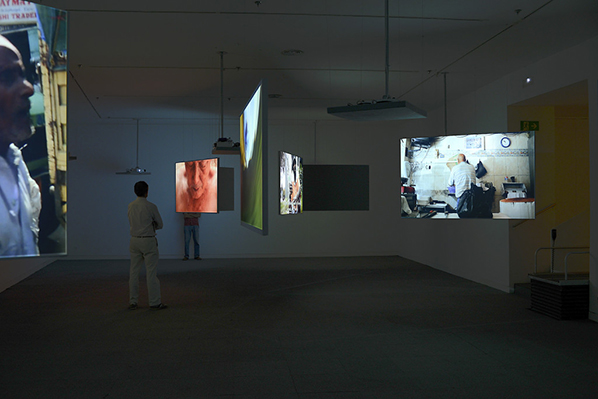
Amidst one of the spectacular accummulations of Farocki’s body of work, the apogee of the retrospective would be Labour in a Single Shot, shown for the first time in Spain. The project was initiated in 2011 by Harun Farocki and Antje Ehmann, co-curator of the retrospective. Located in an entirely different bunker, the work was compiled from a series of workshops whereby a fixed camera filmed paid, unpaid, material and immaterial labour from fifteen workshop locations. Projection screens are hanged in a room, most facing eachother whilst the noise of all labour taking place floods the space. Harmonious parallels are created as sequences from butcher shops and surgeries face eachother. The repetitive looping and sequencing of labour is used as a means of distancing and signifies non-judgmental watching as an active practice of iconic power. Our lasting impression is a call-girl sucking on a lollipop explaining how her artifice encourages clients into believing the gratification she provides is sincere. Here, we understand that just as she, through sex, retains empathy and distance in unison, Farocki’s empathy can thrive.
In a mysterious pine forest, inhabited by half-human, half-animal creatures, the dismembered white body of a furry god is slowly reassembled. A creature with the head of a black bear pulls down the decapitated body from a tall rock. A red-robed character with a crimson wolf’s face, decorated with sharp white teeth, fetches the severed head. Another brings the eyeballs; another, the skull. Finally, in an illuminated multi-coloured tent glowing in the darkness of the woods, a character with the head of a triceratops and a cloak of many-coloured feathers performs a ritual involving magic crystals and a dead bird doused in blood. The film ends with a single glimpse of the white god’s foot, planted in a field of snow, sufficient to suggest that he, she or it has been brought back to life.
I first came across Magic Blood Machine as one of the staff picks on the Vimeo site in October 2014. It was on a list of spooky videos for Hallowe’en. The rest of them looked fairly conventional, but the still for Magic Blood Machine stood out: the red-robed character from the film standing amongst dark pine trees, looking a bit like a Roman Catholic Cardinal, a bit like Anubis – the jackal-headed god of Egyptian mythology – and a bit like Reynard the Fox. When I watched the video, I was struck by the same mixture of associations: it seemed to combine elements of the crucifiction and resurrection of Jesus, the dismemberment and restoration of Osiris, and the Green Man myth. Folk-stories, mythology, the occult, the macabre, and even a touch of science fiction were all in the mix. But its visual design, filmic and narrative qualities were just as striking. There are no words spoken, and the pace is slow, but nevertheless the film exerts a powerful compulsion, partly because of the expertise with which each sequence unfolds and leads us to the next, and partly because it’s so full of unanswered questions. The actions of the strange characters in the pine forest seem charged with hidden meaning, as do the characters themselves, sharply-differentiated from one another as they are by virtue of the brilliant costume-design. There is a strong sense of place in the outdoor filming, and a strong sense of the tactile as well: the way the characters stroke the dead god’s fur, fondle the magic crystals or pour blood over the breast of the dead bird, for example. And despite the use of expressionless masks, there are moments of powerful emotion. When the red creature, having retrieved the white god’s severed head, lays it next to the rest of the body and then sits beside the corpse, holding its hand, it eloquently conveys a sense of love and grief.
Magic Blood Machine was made by a Norwegian artist and film-maker called Ingrid Torvund, in close collaboration with her partner Jonas Mailand, and with music by Jan Erik Mikalsen. It took three years to make (2009-12), and a sequel called When I Go Out I Bleed Magic – which Ingrid describes as the second part of a trilogy – was released earlier in 2015. For me, When I Go Out I Bleed Magic is less compelling than its predecessor, but if anything the design of the film, in terms of costumes and settings, is even more impressive. Ingrid makes almost all the costumes and props herself, and they are works of art in their own right, some of which she has exhibited separately. She has also exhibited her drawings and published many of them in a book, again with the title When I Go Out I Bleed Magic.

Ingrid’s work strikes me as an example of the enabling power of the Web, which can sometimes allow genuinely original artists to reach international audiences they would have found it very difficult to access at any time before the 1990s. It also allows the likes of me to get in touch and start up a conversation out of the blue. Accordingly, I contacted Ingrid via email to ask about her work, and the results are reproduced below.
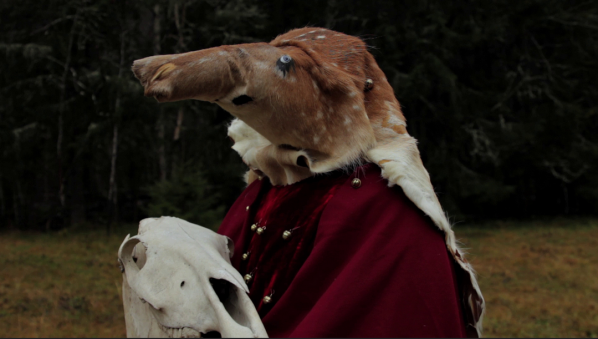
Edward Picot: Can I ask you about the making of the costumes and props for your films?
Ingrid Torvund: I make the costumes and props myself mostly, sometimes I get some help from my friends and family, if it´s large set pieces and so on. I like to take my time making these things, it`s a slow process but it´s one of these things that makes life worth living.
EP: Were you at art school, and if so did you study art, textiles, film or all three?
IT: I went to Oslo National Academy of the Arts,where I took a bachelor degree in fine art. While I was there I made my first short, “Magic Blood Machine“, and I worked on it for three years. I took courses in film, philosophy and many other subjects.
EP: Can you describe your creative process a little bit? Do you start off with an idea for a story, or with sketches in your sketchbook?
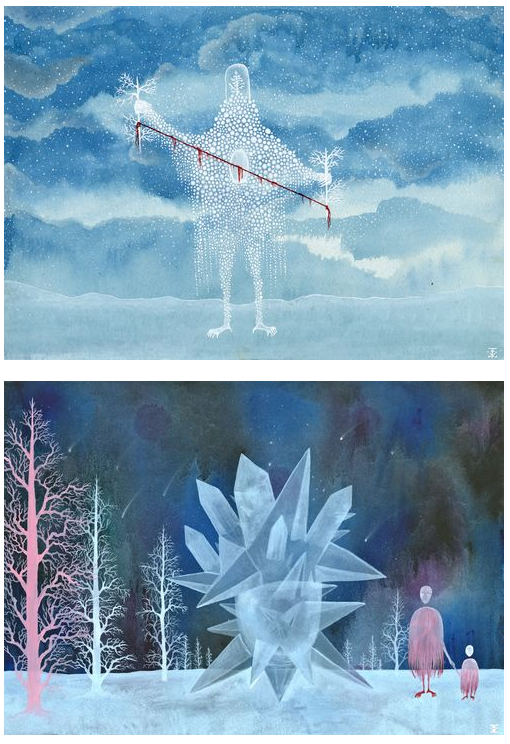
IT: it’s really random how I find inspiration, but sometimes I find a nice tactile material that I want to work with and I start by just trying out how and then I can make something that gives the audience the same feeling I got when I first saw it. And sometimes I get a picture in my head of a scene I want to make and then I try to figure out how to make it, then I draw it (but not very detailed and not very good 🙂
I wish I could say I plan out projects better, but I usually just make what I want to make. Over the years the planning of the filmprojects has become more detailed, but this is because I have to [plan things out] when I apply for funding and it’s a real creative killer.
For the last film “When I Go Out I Bleed Magic” we (me and Jonas) made a long storyboard with many scenes, but in the end we didn’t get to make them all due to lack of funding, lack of time and plain exhaustion.
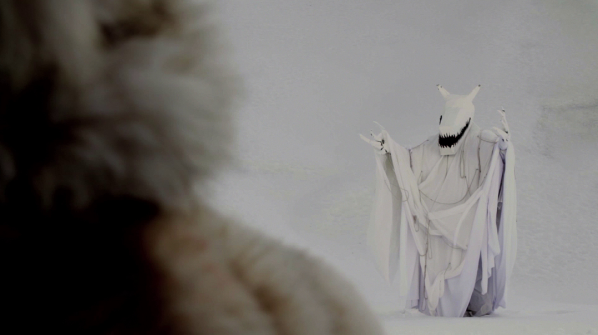
EP: You say you like to take your time making the costumes, props and so forth. Does this mean that your ideas about the film you’re going to make grow quite slowly and organically as you’re in the process of making things?
IT: Yes it does, it’s a long process and I usually try to finish one little part at a time: a costume, a set piece and so forth. But when the time comes to shoot the scene, I have to but all the pieces together, and then I have a time limit. In the two films I’ve made so far I’ve been borrowing my dad’s place, because there I have the space to actually build a little studio in the summer. But since this is his workplace normally, I have to clean it out before they come back from their holiday 🙂 So the summer is a really intense period in the year for me and I have to plan it out more, due to the fact that when I go to work there, I can’t get away, so I must buy all the materials I need before I go. I don’t have a car or a licence and it’s in the countryside. We do have a little boat that I can take to the grocery store 🙂
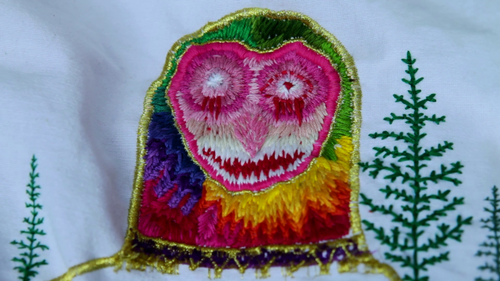
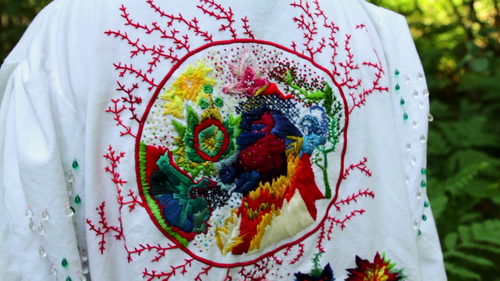

EP: You mention you’ve got a boat – and lo and behold, there’s the red character rowing a boat in Magic Blood Machine. I’m guessing from this that the boat in the film is your own boat, and the lake which appears in both films is the lake where you live.
IT: Yes, most of the places in the movies are from around where I grew up. I also think that it’s important to find inspiration from real and often personal things in life. it feels important to me to know that the project has some kind of root in something real. At my last exhibition my mother gave me some very old school books that I had made some drawings in, and it was almost disturbing how much some of them resembled some of my more current drawings!

EP: Let me ask you about Jonas. How do you work with him? How did you get to know each other and work together, and do you write together, or does he do the camerawork while you put on the costumes and do the acting?
IT: I met Jonas while we were going to an art school in Oslo seven years ago, at the time I was already making characters and installations and we started to date while I was building a forest installation inside a room. He has always had great interest for films and making them, and at that point I was thinking of trying to bring my characters to life by making them into costumes I could wear. After a year we started working on Magic Blood Machine. From that point he has done all the camerawork, while I do all the costumes, set pieces and “acting”. We usually edit the films together and sometimes we make an edit each and then compare them, and choose what we think works the best. I’ve been asked before how we collaborate on these projects and sometimes I find it a little difficult to answer, because we live and work together and we have no rules on who does what in these films. But I do know I spend most of my time thinking or working on these films and Jonas takes part in that if I ask him to. Without him I would not be able to make films like these and my life would suck.
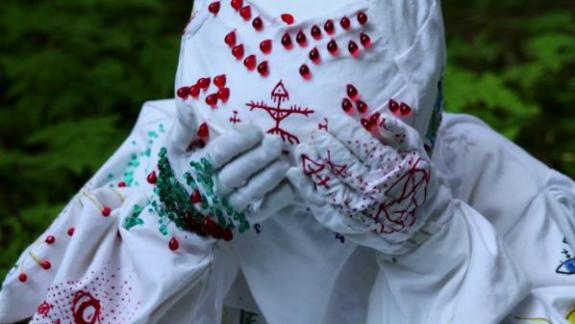
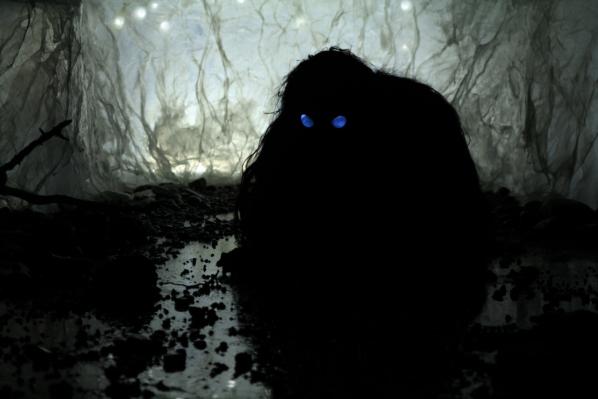
EP: Lastly, would you like to say a bit about the mixture of mythological references in your films?
IT: I have always been fascinated with the mixture of pagan and Christian culture. When I was young I found a book called “Norske Hexeformularer og magiske opskrifter”: it’s a collection of spells and magical recepies from 1600-1900. The spells are collected from small black books found throughout the country, often hidden away. Some would put them under the church steps in an attempt to get rid of them. My films are inspired by these rituals and the conflict between nature and religion. I grew up going to church a lot and I think the mix of church and folklore is something I use as inspiration when I make films.
I think I find the history of how people lived and their traditions even more fascinating then fairy tales, for example people used to think that their newborn babies sometimes got exchanged with a person from under the earth.The child then got some kind of physical change,like a weird growth or huge eyes or it suddenly looks very old. The only way to fix it was to lure the under earth person to tell you their real age. You did this by doing weird and absurd stuff, like making porridge in an eggshell or making blood sausage in an catskin. Then it would suddenly tell you how old it was and then it would die. Leaving a little lump of ash and bones…
More information about Ingrid Torvund can be found on her website, http://torvund.tumblr.com/. Magic Blood Machine is on Vimeo at https://vimeo.com/44936472, and When I Go Out I Bleed Magic is also on Vimeo, at https://vimeo.com/44936472.
Featured image: Stern, Body Language
Interactive Art and Embodiment: The Implicit Body As Performance by Nathaniel Stern. ISBN 978-1-78024-009-1 (printed publication), Gylphi Limited, Canterbury, UK, 2013. 291 pp., 41 Colour Stills.

Earlier this year, I had the good fortune to sit in on a talk given by Simon Penny on May 6th 2014 at the University of Exeter. Penny, not unlike Nathaniel Stern, is best known for his praxis, writing and teaching on interactive (and robotic) installations focusing on issues of embodiment, relationality and materiality. So as unorthodox as its inclusion is to start off a review, Penny’s reflections are pertinent here (in this case, Penny’s famous installations Fugitive (1997) and Traces (1999) [1].
The purpose of Fugitive and Traces (if you can say they had one) sought to ‘embody’ virtual reality through multi-camera infra-red sensors, visual models and real-time movements. At that time, Penny’s unique theoretical take was to distance human-computer interaction away from “a system of abstracted and conventionalised signals” to where the user would “communicate kinesthetically”: instead of investigating the non-human or “inhuman” formal qualities of its medium, or some vague VR future that leaves the body behind, the system itself would “come closer to the native sensibilities of the human.” (Penny) [2]
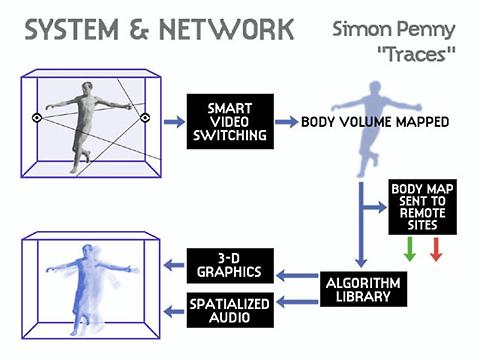

In his Exeter talk, Penny momentarily reflected on a weird and altogether disturbing seventeen year feedback loop. The loop in question relates to how, in 2014, Penny’s early avant-garde ideas and theoretical ambitions have largely been desecrated by their replication in big business. With regard to Traces, Penny cited Microsoft’s Kinect as being the most salient example of this desecration: Kinect’s technology – marketed for the Xbox console brand – carries within its insidious techniques the ability to also “communicate kine[c]thetically”, but do so within pre-packaged, patented, IP-driven, focus-grouped-out-of-existence, commercial vacuities of gamer experience.

As an early practitioner and developer of these technologies, Penny was somewhat visibly infuriated with this, and understandably so. For him, it unintentionally reduced his aesthetic experimentation, philosophical insight, technological futurity and theoretical complexity into consumer speculation for the technology market, commandeering the tech but without the value. It transposed the artistic technological avant-garde necessity of Traces into a flaccid ‘tech-demo’ demonstration of novelty limb flailing and high-end visuals devoid of anything. It was, Penny lamented, “a very weird situation” to be in. Part of that weirdness has to do with the fact that Penny hadn’t done anything especially wrong, because there wasn’t any tangible aesthetic qualities that separated his pioneering work from Microsoft’s effort. Neither had Penny’s work brought financial success with its value intact (because its value wasn’t patentable). Instead technological development had overwritten the aesthetic value of Traces, trading technological obsolescence with aesthetic obsolescence.

Penny’s retroactive predicament is not unique in the history of digital art: for all the visionary seeds of potential in Roy Ascott’s legendary networking project, Terminal Art (1980) we now recognise how those salient characteristics have somehow ended up as Skype or Google Hangouts. Still in the 80s, one might evoke Eduardo Kac’s early videotext works (1985-1986) where visual animated poems were broadcast on the online service exchange platform Minitel (“Médium interactif par numérisation d’information téléphonique” or “Interactive medium by digitalizing telephone information” in its French iteration): a proprietary precursor to the World Wide Web [3]. The retroactive weirdness accompanying these developments is something I’ll come back to: suffice to say that what counts is the direction (and sometimes hostile return) of infrastructure, not just as the background collection of assemblages artists rely on to experiment with at any historical moment, but the shifting ecological foundations to which technology emerges, affords, and now overwrites such practices. No-one likes to play devil’s advocate and yet one must ask the question specific to Stern’s text: what, or maybe where, is the tangible point at which ‘art’ becomes historically valued in these works, if that latent aesthetic potential becomes just another market for a series of Silicon Valley, or startup conglomerates?
——–
Nathaniel Stern’s Interactive Art and Embodiment establishes two first events: not only Stern’s debut publication but also the first of a new series from Gylphi entitled “Arts Future Book” edited by Charlotte Frost, which began in 2013. All quotations are from this text unless otherwise stated.
Stern’s vision in brief: in order to rescue what is philosophically significant about interactive art, he justifies its worth through the primary acknowledgement of embodiment, relational situation, performance and sensation. In return, the usual dominant definitions of interactive art which focus on technological objects, or immaterial cultural representations thereof are secondary to the materiality of bodily movement. Comprehending digital interactive art purely as ‘art + technology’ is a secondary move and a “flawed priority” (6), which is instead underscored by a much deeper engagement, or framing, for how one becomes embodied in the work, as work. “I pose that we forget technology and remember the body” (6) Stern retorts, which is a “situational framework for the experience and practice of being and becoming.” (7). The concepts that are needed to disclose these insights are also identified as emergent.
“Sensible concepts are not only emerging, but emerging emergences: continuously constructed and constituted, re-constructed and re-constituted, through relationships with each other, the body, materiality, and more.” (205)
Interactive Art and Embodiment then, is the critical framework that engages, enriches and captivates the viewer with Stern’s vision, delineating the importance of digital interactive art together with its constitutive philosophy.
One might summarise Stern’s effort with his repeated demand to reclaim the definition of “interactive”. The term itself was a blatantly over-used badge designed to vaguely discern what made ‘new media’ that much newer, or freer than previous modes of consumption. This was quickly hunted out of discursive chatter when everyone realised the novel qualities it offered meant very little and were politically moribund. For Stern however, interactivity is central to the entire position put forward, but only insofar as it engages how a body acts within such a work. This reinvigorated definition of “interactive” reinforces deeper, differing qualities of sensual embodiment that take place in one’s relational engagement. This is to say, how one literally “inter-acts” through moving-feeling-thinking as a material bodily process, and not a technological informational entity which defines, determines or formalises its actions. A digital work might only be insipidly interactive, offering narrow computational potentials, but this importance is found wanting so long as the technology is foregrounded over ones experience of it. Instead ones relationship with technological construction should melt away through the implicit duration of a body that literally “inter-acts” with it. In Stern’s words:
“…most visually-, technically-, and linguistically-based writing on interactive art explains that a given piece is interactive, and how it is interactive, but not how we inter-act” (91)
Chapter 1 details how aesthetic ‘vision’ is understood through this framework, heavily criticising the pervasive disembodiment Stern laments in technical discussions of digital art and the VR playgrounds from the yesteryear of the 90s. Digital Interactive Art has continually suppressed a latent embodied performance that widens the disembodied aesthetic experience towards – following Ridgway and Thrift – a “non-representational experience.” Such experiences take the body as an open corporal process within a situation, which includes, whilst also encompassing, the corporal materiality of non-human computational processes. This is, clearly, designed to oppose any discourse that treats computation and digital culture as some sort of liberating, inane, immaterial phenomenon: to which Stern is absolutely right. Moreover, all of these material processes move in motion with embodied possibilities, to “create spaces in which we experience and practice this body, its agency, and how they might become.” (40) To add some political heft, Stern contrasts how the abuse of interactivity is often peddled towards consumerist choice, determining possibilities, put against artistic navigation that relinquishes control, allowing limitless possibilities. Quoting Erin Manning, Stern values interactive art’s success when it doesn’t just move in relation to human experience, but when humans move *the* relation in experience (Manning, 2009: 64; Stern, 46).
Stern’s second chapter moves straight into a philosophical discussion denoting what he means by an anti-Cartesian, non-representational, or implicit body. Heavily contexualised by a host of process, emergent materialist thinkers (Massumi, Hayles, Barad), Stern concentrates on the trait of performance as the site of body which encapsulates its relationally, emergence and potential. The body is not merely formed in stasis, (what Stern dubs “pre-formed” (62) but is regularly and always gushingly “per-formed” (61) in its movement. Following Kelli Fuery, the kind of interactivity Stern wants to foreground is always there, not a stop-start prop literate to computer interaction, but an effervescent ensemble of “becoming interactive” (Fuery, 2009: 44; Stern, 65). Interactive art is not born from an effect bestowed by a particular medium of art making, but of “making literal the kinds of assemblages we are always a part of.” (65)

Chapter three sets out Stern’s account for the implicit body framework: detailing out four areas: “artistic inquiry and process; artwork description; inter-activity and relationally.” (91) Chapters four, five and six flesh out this framework with actual practices. Four considers close readings of the aforementioned work of Penny together with Camille Utterback merging the insights gained from the previous chapters. What both artists encapsulate for Stern is that their interventions focus on the embodied activities of material signification: or “the activities of writing with the body” (114) Utterback’s 1999 installation “Textrain” is exemplary to Stern’s argument: notably the act of collecting falling text characters on a screen merges dynamic body movements with poetic disclosure. The productions of these images are always emergent and inscribed within our embodied practices and becomings: that we think with our environment. Five re-contextualises this with insights into works by Scott Scribbes and Mathieu Briand’s interventions in societal norms and environments. Six takes on the role of the body as a dynamic, topological space: most notably as practiced in Rafael Lozano-Hemmer. Chapter seven I’ll discuss near the conclusion: the last chapter shortly.
Firstly, the good stuff. Interactive Art and Embodiment is probably one of the most sincerest reads I’ve encountered in the field for some time. Partly this is because the book cultivates Stern’s sincerity for his own artistic practice, together with his own philosophical accounts that supplement that vision. His deep understanding of process philosophy is clearly matched by his enthusiastic reassessment of what interactive art purports to achieve and how other artists might have achieved it too. And it’s hard to disagree with Stern’s own position when he cites examples (of his work and others) that clearly delegate the philosophical insights to which he is committed. One highlight is Stern’s take on Scribbes’ Boundary Foundations (1998) and the Screen Series (2002-03) which intervenes and questions the physical and metaphorical boundaries surrounding ourselves and others, by performing its questioning as work. This is a refreshingly earnest text, proving that theory works best not when praxis matches the esoteric fashions of philosophical thinking, but when art provides its own stakes and its own types of thinking-experience which theory sets out to faithfully account and describe. Stern’s theoretical legitimacy is never earned from just digesting, synthesising and applying copious amounts of philosophy, but from the centrality of describing in detail what he thinks the bodily outcomes of interactive art are and what such accounts have to say: even if they significantly question existing philosophical accounts.
Stern leaves the most earnest part of his book towards the end in his final semi-auto-biographical companion chapter called “In Production (A Narrative Inquiry on Interactive Art)”. This is a snippet of a much larger story, available online and subject to collaboration [4]. Here, Stern recounts or modifies the anxiety inducing experience of being a PhD student and artist, rubbing up alongside the trials of academic rigour, dissertation writing and expected standards. Quite simply, Stern is applying his insights of performative processual experience into the everyday, ordinary experiences faced by most PhD students in this field, and using it to justify a certain writing style and a sense of practice. It’s an enjoyable affair – in large part because it outclasses the dry scholarly tone usually associated with writing ‘academically’, elevating imaginative, illuminating redescriptions for how the experiences of interactive art broadly hang together rather than relying on relentless cynical critique. And most of that is down to Stern’s strong literary metaphorical technique for grounding his vision, perhaps even more effectively than the previous chapters.
Yet earnest experiences aside, there are two problems with Stern’s vision which, in my eyes, leave it flawed. That isn’t a bad thing: all visions are flawed of course. That’s why the similarities between art and philosophy feed our heuristic, academic compulsion to come up with them and debate: well, that and sometimes the most flawed can end up being the most influential. Such flaws only arise in relation to what Stern thinks is valuable in interactive art, and to the extent that the intervention posed may require readdressing. The flaws in question are composed from two different angles, but stem from one objection. The first is philosophical, or at least a problem pre-packaged with relying almost entirely on relational ideas of embodied emergence. The second is more tied to infrastructure and technical expropriation as outlined in Penny’s predicament given from the outset.
In his introduction, Stern makes clear that this is an “art philosophical book” (4), not a philosophy of art as such: only one that “understands art and philosophy as potential practices of one another” (4). Following Brian Massumi, philosophy “tells us the stakes”, whilst “art brings those states to the table” (5), such that the type of art he values and constructs, (digital interactive art) is precisely that which melts away in its interactive encounter when constructed as work. Later on we discover that interactive art “interrupts relationality” (66), making present an “intervention that brings a situated moving-thinking-feeling to a higher power.” (66) Further on, interactive art does something else, when it “intensifies features of […] the ongoing transformation of the ‘living’ body”, and “gifts us with a state to practice being and becoming.” (73) Reflecting on the infamous Bourriaud/Bishop relational aesthetic ruckus a decade ago, Stern outlines how they focus on the explicit body (82) (how we understand ourselves or challenge explicit social/economic positions in the world), whereas artworks which privilege the implicit body have us “encounter how we move, transform, and are (continuous)” (82) in the world. The former takes on the materiality of social relations, the latter (endorsed by Stern) takes on the whole materiality of “embodied relations” (83). And again to reiterate, art operates as “the practice of contemporary philosophies, where we investigate, and further research on, embodiment and relationally together.” (83).
Now, one should admire how Stern blends philosophy and art praxis together precisely by not shoehorning authoritative philosophical accounts into art praxis where they aren’t needed. This works, precisely as the ontology expressed here actively resists such authoritative accounts as well as being cemented with the sort of sincerity with which Stern has such a keen literary grasp. More importantly, Stern cites works which seem to fit the stakes of his ontological conviction perfectly.
However the reliance of process-based philosophy dampens exactly how these works intervene to bring about the values he so desires. The simplest objection comes from asking how Stern might value anything at all, if our entire relational embodiment with the world is constantly in process – or that “[b]odies and matter are change” (220) – and must be always affirmed as such: why should every process and every bodily interaction be affirmed? Moreover why is it art’s place to give primacy to the ontological events of bodily material change?
This is one of the key infrastructural problems that surface, once a theory of art totally subscribes to a process-based ontology, let alone one focusing on embodiment: why should an artist like Stern feel compelled to present an intervention in the first place? If the dominant ontological movement of interactions is a becoming-event, by what standard or eruption should interactive art be said to work on? If, as Stern believes, “the interactive process in interactive work is the ‘work’” (159), it becomes unclear what value interactive artworks are purported to convey, if that process is all there is. To say that embodied processual events make the work “work”, because they underscore our situational intelligibility (or make it effective – so to speak) speaks nothing of what differential criteria should apply to make that aesthetic intervention intelligible. To hazard a guess, the problem is one of articulating how convention exists in a process ontology: because if everything is always emerging as an interactive event of change, the act of rupturing or intervening in convention becomes a real problem. The criteria for valuing these important works is only affirmed it seems, because every process is already affirmed: and if that’s the case you don’t need artists to make an intervention – there is no intervention required, other than the events that already exist, as change in themselves. To put it another way: why should (and how can) a work effectively gift us heightened states of being and becoming, if our entire situational relationship with the world is already situationally related in being and becoming?
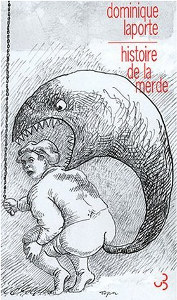
I am reminded of Adrian Johnston’s 2001 review of the newly republished English translation of Dominique Laporte’s History of Shit (first published in 1978). Whereas most Foucaultians and Althusserians were disconcertingly vague in pointing out the concrete material conditions for subjectivity and economical production, Laporte boldly contended that the genealogical hypothesis to all modern civilisations was tied to one concrete material condition: the infrastructure of bodily waste management, or, the desire to control and sublimate our need to defecate. In his usual Žižekian repartee, Johnston suggested that Laporte’s bizarre history of modernity implicitly accepted the anti-Cartesian embodiment thesis (that cognition cannot be separated from the actions of the body), but pushed its logic to the end. That for all the affirmative, encompassing, sensual, emergent, potential images embodiment philosophy prefers to agree and discuss, it completely ignores one of our central and basic bodily requirements: to excrete our bodily waste or fecal matter, and remove it from sight and smell (and we don’t need to remind the reader of art’s fascination with this area).
Whilst Johnston’s tongue was firmly planted in his cheek, he did happen to put a psychoanalytical finger on the central problem with process based embodiment. That often enough, sincere accounts of embodiment designed to affirmatively depict and encompass implicit environment material engagements leave behind an unacknowledged stain: one which says more about these accounts than their proponents actually do. And it is precisely because Stern focuses on the most aesthetically agreeable areas of bodily engagement in interactive art, that something as habitual and ritualistic as the excretion of digested matter, or the infrastructure of sewage networks exposes that image.
In terms of materiality this is doubly important. Laporte’s intervention brings into conflict two competing performative materialisms which disclose our own bodily relationships with non-human processes (in this case, computational and networked material): the first is Stern’s own account of the material body as some sort of ‘nebulous material’ which is always emergent, lived, relational and thinking with its own engagement in the world of humans and non-humans. The second is Laporte’s material body seen as ‘brutal material’ – an explicit input-output, complex, evolutionary processing machine, strictly determinate and bounded in its biological function. Despite Stern arguing earnestly for the nebulous form, it doesn’t appear to me that he can hold off the brutal form, or at least prevent the latter from antagonising the former. And often enough, this happens because Stern’s accounts of embodiment, and the philosopher’s accounts he relies on, are already meant to be nebulous in themselves.
This logic unravels by chapter seven, when Stern expands the implicit body framework to analyse other examples of new media art which aren’t preoccupied with bodily participation to work, as work. He terms this “potentialized art” (206) where “audience members do not *make* the work directly through their interactions (207) but are subject to visual performances of potential movement and relation mediated by generative computation and networks. In citing Gordan Savičić and Jessica Meuninck-Ganger – amongst others – Stern argues that these ongoing performances harness generative information participating in embodiment relations, and invite metaphorical sensory change and bodily movement (in the case of Savičić’s performances, quite literally inflicting pain and suffering onto his own body using network data and social media).
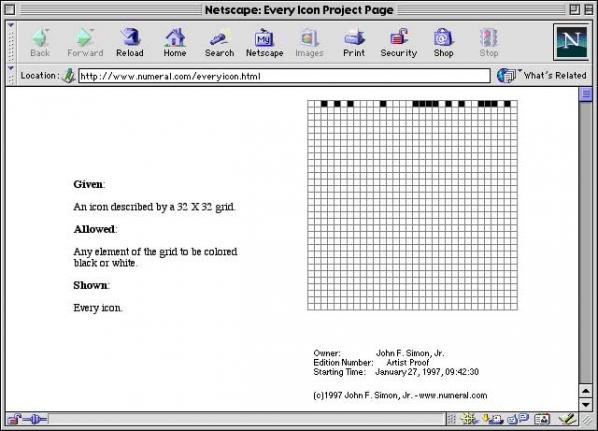
However when Stern cites John F. Simon. Jr’s infamous work Every Icon (1997), (227 – 230) (a cellular automation piece which takes approximately several hundred trillion years to complete) it becomes clear to me that the aesthetically agreeable areas of embodiment start to break down. It might be that my own reading of the piece is fairly unorthodox [5] (I don’t consider the work to be primarily conceptual for a start), but Every Icon eschews what Stern writes as giving “both the corporeal and incorporeal a present and future presence as time and sign” (230) or something that generates attention to our “sensual and conceptual experience of temporality” (230).
Yet, isn’t it the case that Every Icon is probably one of the least potentialised artworks ever made? It doesn’t actually generate anything, (in the strict sense of unpredictable outcomes from simple rules) it simply enumerates configurations of pixels one by one. Neither can we be said to “feel the potency of several hundred trillion years” (230) than we feel the cold, indifferent execution of a real java applet function to which we are forever limited in experiencing directly. If anything, Every Icon is deliberately constructed to forgo a relation with us.

To conclude: this is perhaps why Penny’s predicament with the Kinect is so stark. To demand, as Stern does, that we treat digital interactive art as setting a stage for examining how we “per-form” with our bodies within media, material, conceptual frames and selves, is no longer enough of a stage to give voice to the technological ecologies we find ourselves in: nor of the art that satisfies intervening in it. Credit must be given to Stern for writing over interactive art’s emancipatory myth of disembodied immateriality, but his endorsement of embodiment only serves to realise that the problem isn’t forgetting to focus on material engagement, but forgetting the cold, hard and brutal materiality of procedural performance of infrastructure, that often moves faster than we do. When Microsoft’s Kinect co-opts all the same values of Traces, it does so not because embodiment is totally flawed, but that bodily movement has now become ecologically implicated in deceptive infrastructure.

Just as Penny’s Traces may once have evoked a renewed attention to moving-thinking-feeling, such engagements are now suitably tracked and are in service of non-transparent infrastructures of geo-social activity, which propagate themselves beyond our sensory engagement, yet paradoxically they also indirectly sustain that ordinary engagement. For example, this is now a world where Google funds a 60tbps undersea cable connecting the West Coast to Japan, in order to propagate the reach of their services. The technological engagement of our bodies cannot be restricted to how we move-think-feel, but now weaves itself within layers upon layers of platforms and pervasive surveillance structures. And I don’t disagree with Stern that the implicit body is, perhaps, deeper than the account I give here. But maybe that’s because the body is also another type of performative infrastructure, tightly bound into other formations that are just as deep, complex and engaged. We now live in a time where digital interactive art has to intervene in the performances of geo-social infrastructure: where our bodies have curiously taken on their self-directing performances, rather than our own.
Featured image: Screenshot of Apodemy by Katerina Athanasopoulou
Eva Kekou interviews Katerina Athanasopoulou about her film Apodemy commissioned by The Onassis Cultural Center on the theme of Emigration for Visual Dialogues 2012, and her hybrid art practice of live action, animation and film. In 2013 Athanasoppulou won the Lumen Prize, described by the Guardian as “The World’s Pre-eminent Digital Art Prize”. She works as an Animation Director, collaborates with other artists and companies, and is an Animation Lecturer at the London College of Communication.
What is your background and what brought you to London?
I studied Painting at the School of Fine Arts of Aristotle University in Thessaloniki. My work involved large canvases painted in a serendipitous way, building layers, erasing and restarting, seeing where my lines were going to take me. I was frustrated by the stillness of the final piece, longing to recreate the gesture in time that had created it. At the same time, I was passionate for cinema and animation so I tried it out in my own computer at home. In a way, I discovered animation for myself, as there was no film nor digital element in my course. That meant that there was no right and wrong way to go and it was such a joy to be producing moving images, to be able to finally paint in time! My first films were digital cutouts and manipulated live action. The big change came when I arrived in London in 2000 to do an Animation MA at the RCA, where suddenly completely new creative possibilities appeared. Short film festivals were also a source of great inspiration, places to meet like-minded filmmakers and watch films all day long.
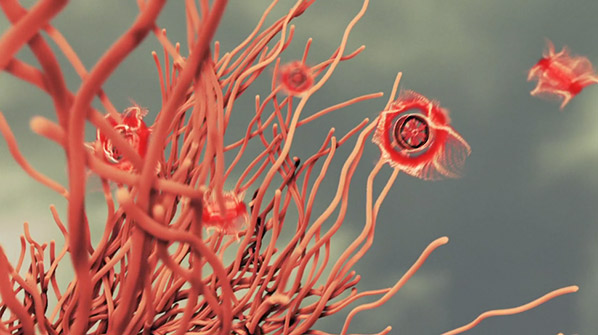
What’s the effect of English education in your work and in the way you appreciate art?
When I became a student in the UK, I was at the same time delighted and terrified by the informality of the teacher-student relationship, like addressing your tutor by their first name. I was really impressed by the enthusiasm for research and for the creative journey itself. Process becomes a major part of the work and that frees you from concentrating only on the outcome. I saw how Animation can be enlisted in very different ways, from a more commercial manner to very left-field experimental practices so that was an exciting new point of view for me. At the same time, the early 2000s were a time of conflict between analogue and digital practices – which of course has not quite gone. As an educator myself, I love the intensity of the way that students debate their work, so the English system of education still very much inspires me.
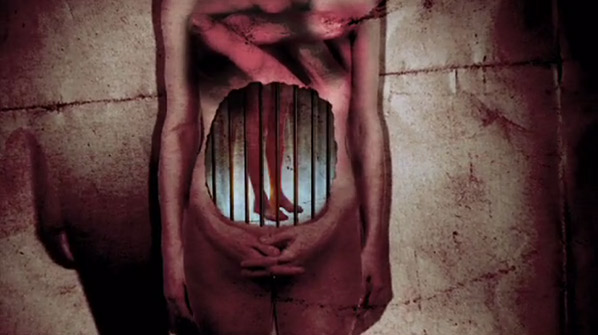
What was your creative practice up to the Lumen Prize.
Since 2002 I have been making short experimental films that have been screened in film festivals and galleries, my process being one of playfulness and embracing chance. I like to try out different ways of creating moving images, and I try to make each film follow a different road, even though it’s very tempting – and at times fruitful – to revisit old concepts. In the last three years I have developed a big interest in Architecture and how that can be depicted in time, through 3D, 2D and live action. Animation for me is Alchemy, I combine elements together, in textured space and time and see what happens. These experiments some times involve diving into live action that I have captured on location, and other times are about creating that space digitally.
Animation Installation is a field I’m fascinated by at the moment, devising ways of materialising the digital element, of making it even more about light and shadow. My latest film, Triptych 1, was made especially for the facade of the Museum of Contemporary Art in Zagreb and reimagines it as built of interconnecting corridors.
Talk to us about the theoretical and philosophical background of Apodemy.
Apodemy was commissioned by the Onassis Foundation (Stegi) on the theme of Emigration and the Economic Crisis. It was to be part of an Art Show in an old archaeological park in Athens, called Plato’s Academy Park, where the philosopher is believed to have taught. The title of the Installation was Visual Dialogues so I was drawn to Plato’s Dialogues where I discovered the metaphor of the human soul as a birdcage. I was very keen to instil in the work philosophical elements related to the space itself. With migratory birds being one of my initial ideas about the piece, the solution of a travelling birdcage in an abandoned half-finished city became apparent. The marble arms were part of Plato’s birdcage metaphor, where he describes how, as we grow up we fill our mind/birdcage with ideas/birds. When we need to recall something, we put our hand in the cage and grab a bird. I imagined those hands to be aggressive, so they became statue fragments carried by cranes that eventually mar the trolley cage’s journey. Theo Aggelopoulos inspired me with his images of a Lenin statue traversing the river and of a single arm, floating accusingly yet innocently. In times of political upheaval we like to break down our past heroes, in an attempt to cleanse ourselves of mistakes. Only that sometimes those past leaders still come back to haunt us.
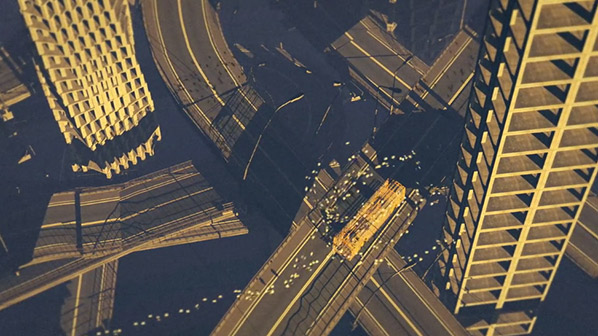
What techniques did you use?
I designed the city on the computer in 3D and then started to drive cameras inside it, discovering it on the road, like I was exploring a real landscape. The film was built like a documentary, following the migration journey of a cage that is also a trolleybus, the yellow kind that I was riding in Athens when – in the late nineties – everything was promising.The construction industry ground to a halt when the crisis took hold so, today, many buildings remain unfinished and look like birdcages themselves. After the City was built, I started making the birds and the bus. Then I moved it inside the city, following a broken road which eventually leads to the fall. The entire film developed through trial and error, it was my first 3D film and I had limited time and resources. But restriction breeds creativity and, in the two months that I had to complete it, I tried to make a film designed in a minimal but impactful way.
What does the Lumen Prize mean to you and how can such a recognition make a difference in your work and life?
Winning the Lumen Prize was a great honour, especially amongst so many great works from entirely different platforms. The prize revolves around fine digital art and encompasses film, installations, interactive work, print, sculpture, collage. Amongst such a plethora of forms, it meant a lot that Apodemy was awarded, both in terms of my digital animation practice, but also as it’s a film that’s about the collapse of my country of origin. The Lumen Prize show has already been to New York and will also be part of the Digital Symposium at Chelsea College of Art and Design in March, as well as in Hong Kong in June. It’s wonderful that Lumen is propelling the film further forwards, and it’s been great to meet some of the other artists involved. Seeing the works by Nicolas Feldmyer, Kalos&Klio, Margarita Koulikourdi, Vasileios Chlorokostas and others has been very inspiring.
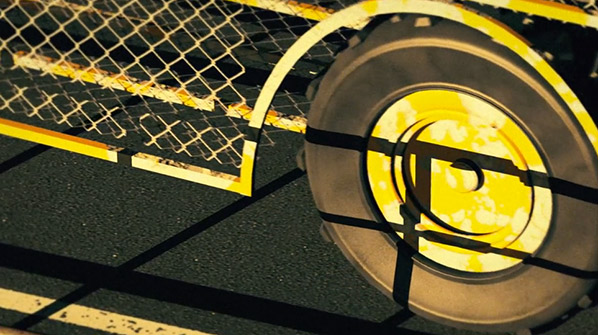
What draws you to animation?
Through cinema, we immerse ourselves in different waters, achieving a kind of immortality. One could argue that also happens whilst reading, or listening to music – yet somehow film combines literature and poetry and music too and almost all the senses get involved. What’s more interesting for me is the connection between moving image and the imagined: it’s almost like we dream other people’s visions and we physically try to make that disconnection from reality by favouring watching films in dark rooms. The cinema I’m interested in is one of spectacle, that transforms reality into a surreal play, that explores light and shadow and looks for monsters under the bed. At the same time, I’m currently very curious about taking animation off the screen and applying it in space, by projecting rooms, objects, corners. For me, there’s no greater magic than instilling life in the inanimate and create moving worlds that don’t depend on cameras and actors – what’s in your head can be made real, a real that’s still beautifully elusive and chimeric, that doesn’t contain all the answers but asks exciting questions.
What are your future plans?
I have been working on an experimental narrative of an obsessive mother that cocoons her children, which may work as a single screen work or perhaps as an installation that includes a film. I’m also researching the Architecture of Melancholy, which lies somewhere between cabinets of curiosities and abandoned homes. I always have several experiments on the go, it’s really about finding the right time and opportunity to commit to a project. As delightful as animation is, it takes time to complete, but it also means that ideas may have time to mature and not be rushed. As long as my ideas keep me entangled, I’m happy.
See Katerina Athanasopoulou’s work online at kineticat.co.uk
Glitch as an aesthetic signifier of technological presence dates back at least to the 1980s. Look at The Vaught-Kampf machine in Blade Runner (1982) or the titular character in Max Headroom (1985). The use of Glitch as an artistic aesthetic in itself has accelerated with the democratization of newer technologies that make older glitch-prone technology obsolete. When a technology becomes redundant, its previous technical inefficiencies become available for aesthetic recuperation and appreciation.
The hiss and crackle of vinyl records, to be ignored or reduced as far as possible by the mid-20th century audiophile, became signifiers of historical authenticity in 1990s Trip Hop. The lens flare, light seepage and colour shift of cheap mass-produced chemical film-based cameras have been turned from annoyances to fetishes with Lomography (experimental analogue film photography) and Instagram. And the glitches of poor video connections or corrupted floppy disks have followed a similar path in Glitch art.
This is a process of ironisation. Irony changes or inverts content without altering form. Meaning is introduced into systems by ironising non-signifying forms. It is modified and modulated by further ironising those forms. The glitches that once frustrated media professionals and home users of electronic media are ironised into aesthetic form in Glitch Art.
Glitch Art sits in the historical tradition of process art and chance art. Automatism and chance acts in Dada, Surrealism, Situationism and the Oulipo, and Scatter art. Generative and algorithmic art. Action painting provides the useful concept of “all-over composition” as a way of avoiding a requirement of specific, localisable intent in aesthetically, evaluating an image.
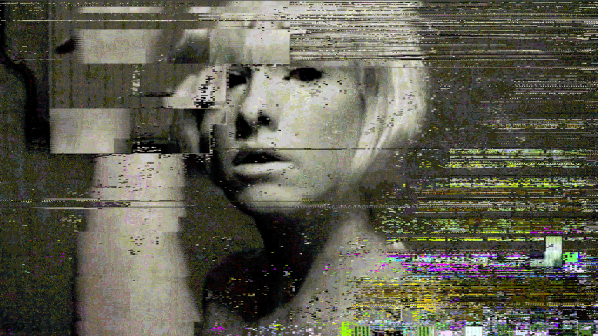
Glitch art also sits in the historical traditions of remix art, detournement and décollage. The knowledge that the image has been altered is key to its aesthetic reception. It’s tempting to talk about the creative destruction of capitalism and to damn Glitch as neoliberal apologia, but that’s too easy and would leave the speaker too comfortable. It is also very tempting to try and place Glitch Art within the traditions of anti-aesthetics or of nominalistic/found art, or to compare the use of image corruption to artistic outsourcing or crowdsourcing in terms of artistic abrogation of authorship. But Glitch is at least curated by the artist, and its generation requires an engagement with the specificities of digital media that they are not supposed to have. The Glitch artist is artisan, not manager, and Glitch Art is sublime, not ordeal.
Panofsky’s extension of the idea of symbolic form to perspective can be applied to Glitch as form. Glitch is effect (a body of effects) that generates *critical* form. The patterns of noise or confounding signals that result from analog or digital image corruption and the effects on displaced sections of the corrupted image are form, presented for positive aesthetic evaluation rather than removed to avoid negative technical evaluation. This complicates Shannon’s diagram of information transmission. Noise is ironised into signal.

The smooth running of inhuman systems is disquieting. Glitch reasserts their materiality. To the extent that it did so to generalise specific failings to a general system in order to make them appear fallible and human this would be kitsch. To the extent that it did so to remind us of older technology, it would be Cory Arcangel-style leveraged nostalgia. And to the extent that it generationally positioned itself against the previous generation’s perception of value in its own culture would be adolescent, social positioning.
Glitch art avoids these failings by producing tension and contradiction rather than jouissance and confirmation. It is disquieting in a way that disturbs the new without allowing a return to an idealized earlier social and aesthetic order, and it is aesthetically creative in a way that does not hide the destruction involved.
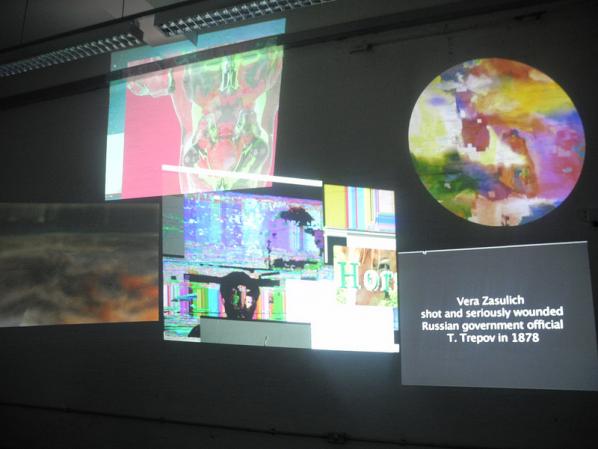
The 8 and 16-bit console software beloved by some Glitch artists is comprehensible to them and to their audiences in a way that 64-bit cloud-based network software is not. The former is therefore a useful artistic proxy for the latter. Defamiliarising the one familiarises the other, and provides a way in to critique its unseen operation through visible means.
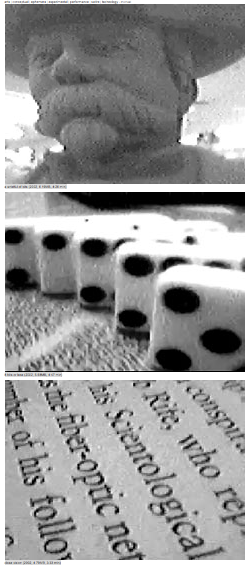
Art makes invisible order tractable by making it visible. Glitch aesthetics are all-over irruptions of the hidden technological order that reveal its operation through its failure. They assert not a reactionary nostalgia but a potential challenge to closure. Engaging with Glitch aesthetics allows us to exercise and develop our regard in a way that increases our fit to the smooth operation and to the catastrophes and contradictions of our post-digital environment.
The text of this review is licenced under the Creative Commons BY-SA 3.0 Licence.
Don’t forget the Glitch Moment/ums exhibition at Furtherfield
Curated by Rosa Menkman & Furtherfield.
Opening Event: Saturday 8 June 2013, 2-5pm
with Glitch Performance by Antonio Roberts at 3pm
http://www.furtherfield.org/programmes/exhibition/glitch-momentums
Roger Malina is a physicist and astronomer, Executive Editor of Leonardo Publications (The M.I.T. Press), and Distinguished Chair of Arts and Technology at the University of Texas at Dallas. Dr. Malina helped found IMéRA (Institut méditerranéen de recherches avancées), a Marseille-based institution nurturing collaboration between the arts and sciences.
Mariateresa Sartori and Bryan Connell are two artists recently based at IMéRA. Their work connects with human movement through the city, and addresses the intersection between technology and perception. Recent work by Venice-based Mariateresa Sartori has encompassed drawing and video. Bryan Connell, Exhibit/Project Developer at San Francisco’s Exploratorium, works especially with landscape observation devices and mapping.
Lawrence Bird interviewed Roger Malina, Mariateresa Sartori, and Bryan Connell about the intersection of their work with the city. Images above courtesy: Roger Malina, Rita Gambardella, Bryan Connell.
Lawrence Bird: Roger Malina, in your recent writing you make the case that science is no longer just a field of positive knowledge. Scientists are increasingly open to engagement with the arts — for example artists’ residencies at CERN. You’ve even argued that we’re in a crisis of representation as profound as that of the Renaissance or the 19th century, and this is “driving a new theatricalisation of science.”
Urban life has often been understood as performative – display, performance of social roles, presentation of oneself before others are all part of the public life in cities. How would you say that crisis of representation plays out with regards to this performative dimension of urban life? How is science implicated alongside art in the city, in these conditions?
Roger Malina: One of my arguments for the ‘crisis of representation’ really looks at Renaissance systems of representation — first driven by what the eye could see, and then the eye extended by microscopes and telescopes. These systems of representation were developed that led to a deep contextualising of the viewer in the world.
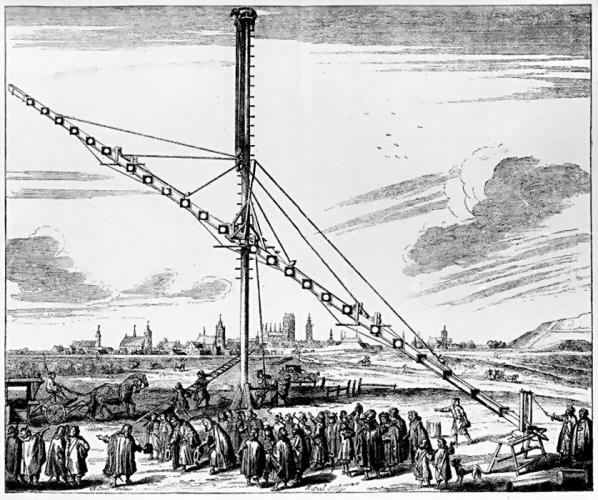
Today we are in a new situation because so much of our perception of the world comes not through extended senses but, in a real way, through new senses. This has been happening over a number of decades; the first wave of this was at the end of the 19th century when there was a cultural shock with the introduction of x-ray images, infra-red and later radio — which didn’t extend existing senses but augmented them.The most recent series of triggers maybe comes from the nano-sciences and synthetic biology — we now perceive phenomena of which we have no daily experience of (eg quantum phenomena). Field emission microsopy or MRI or some of the other new forms of imaging really don’t build on our existing experience — there are discontinuities and dislocations. Another element is of course the hand held device that leads to techniques for ‘augmented reality’ — I have a phone app that I can point at an aeroplane overhead and it tells me what the plane is, where it came from, and where it is going.
Coming to your question about the city — there is clearly a shift in map construction and reading — from the Cartesian map that we have been acculturated to. The ability to toggle between the bird’s eye view and the “street view”, and the ability to view maps that have multiple layers simultaneously are driving artists and others to develop new forms of representation.

Someone whose work is interesting in this regard is Bryan Connell in San Francisco, he just finished an art science residency at IMéRA in Marseille. He was working on a large urban trail project called GR13 — 300 miles through industrial, urban, sub urban, and wild landscapes (the city had a hell of a time getting right of way through these areas). Bryan is currently working on a web site for the Marseille European City of Culture events, where he’s working on some of these questions of representation. The project involves a collective of ‘artist-walkers’ that I think fits right into this question of performativity.

LB: There’s currently a great deal of interest in the connections between representation, digital technology, and politics, for example the current Hybrid City II conference in Athens. As you’ve pointed out, these often underline the connections between what digital media mean for artists and what they can contribute to citizens — what’s emancipatory about them. What can art offer civil life in this context? Are there any conflicts or contradictions in that relationship?
RM: One pertinent example is the work of Bruno Giorgini, a physicist, and Mariateresa Sartori (visual artist) who work on the “physics of the city.” They were recently in residence in the IMéRA Mediterranean Institute of Advanced Study which hosts artists and scientists in residence who want to work with each other. We now have access to incredible amounts of data on human mobility (pedestrian and various forms of transportation) so it is now possible to study human behaviour quantitatively. Sartori discovered that she could tell many things about a person just through the morphology or topology of their movements through the city. Girogini discovered that people’s movements could be predicted at the 80% level, but 20% of the time he had to introduce what he called ‘social temperature’; in discussions he also referred to this as a ‘free will’ parameter. Barabasi has found similar results analysing cell phone GPS data of individuals. So its interesting to think of the development of cities as 80% predictable and 20% serendipitous. This of course then highlights the role of the arts and culture in making cities part of the cultural imaginary that drives people to make choices. Recently Max Schich here at the University of Texas has analysed very large data bases looking at where prominent people are born and where they die over the last 500 years. Immediately you can see how suddenly certain cities become cultural ‘attractors,’ say the way Berlin or Hong Kong are now. And of course cities are now trying to ‘design’ this into the development of cities. Here in Dallas there has been a huge investment in the ‘arts district’ and in institutions of higher learning in the belief that healthy cities require such investments. See for instance the US National Endowment for the Arts Program; there are many similar programs in Europe.
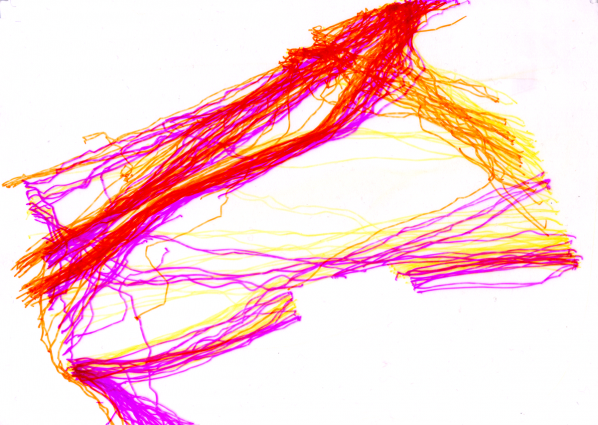
This doesn’t yet address your ’emancipation’ question. One of the things that is happening is that we are becoming a data taking culture (see the recent literature on ‘big data”). The cell phone has transformed every citizen (that has one) into a data taker. Of course much of this data is used by companies for marketing objectives. But many citizen groups are now able to take data for their social objectives. Some of this is captured by the ‘citizen science’ movement ( one example is here). There have been good examples of citizen’s taking data (on pollution, on illegal activities etc.) and then being in a position to challenge ‘authorities’ of various kinds whether scientific, political or economic (see for instance the way citizen groups have mobilised to collect data after man-made disasters such as oil spills, or illegal logging in forests).
A few years ago I wrote an open data manifesto which argued that I would like to advance a new human right and a human obligation:
1. Each of us has the right to the data that has been collected about ourselves and our own environment.
2. Each of must contribute to the knowledge construction by collecting and interpreting data about our own world.
Most scientific data collection is funded by public tax payer funding. The public has a fundamental right to all data collected and funded by public tax money.
LB: How do you imagine an artist’s training will change as these conditions evolve? And a scientist’s — could we foresee any kind of convergence?
RM: One interesting development is a cohort of hybrids, who have one degree in science or engineering and one in art and design ( for example J.F. Lapointe, a researcher at the National Research Council of Canada with degrees in molecular biology and dance) or degrees in Science or engineering and employment in art or design (like myself or Paul Fishwick, a key figure in the field of aesthetic computing). There’s been an emergence of art/science Ph. D. programs that take students from art or design or science or engineering. I suspect this cohort will grow over the coming years.
LB: Mariateresa Sartori, your IMéRA research project with Bruno Giorgini focused on mobility in the city. Can you tell us a little bit about how your work and Dr. Giorgini’s work complemented each other? What kind of evidence did you bring to the table as an artist?
MS: The project I worked on with Bruno Giorgini developed an exploration that began with earlier work in Venice. There I created a series of drawings using a rudimentary, even crude procedure: I traced out the movements of each pedestrian in the Piazza San Marco, drawing their paths with a felt-tipped pen on a transparent sheet placed over the computer monitor. I then faithfully transferred the results onto ordinary large sheets of white paper. The lines thus drawn in different directions created a space, drawing a St. Mark’s Square that is actually not there. As well as the actual physical space, it is also a drawing of our individual and collective manner of relating to space. Each single path determines the route of others, in a continuous and reciprocal game of influences that makes our collective progress.
At IMERA we developed this method for a new environment, a city more ethnically and culturally plural than Venice. Together we set up procedures and tools for collecting data about mobility networks there: nodes, links, chronotopi. These drew on the work of Bruno Giogini’s Laboratorio di Fisica della Città of the University of Bologna. We shot videos focusing on specific behavioural patterns where strategies of shifting, approaching and distancing play a decisive role; and we were also attracted by the places and situations of pedestrian congestion. Using the same technique as in Venice, I translated these into drawings of movement. These again created a space that marks out squares and places which are actually not there, each synthesizing space, time and humanity in a single image.

LB: Is there an emancipatory or governance-related dimension to this work? Degrees of mobility have human rights implications. How does your work as an artist connect with these rights, especially the notion of the right to the city?
MS: The first goal when I work as an artist observing reality is observation, i.e. a way of observing that implies a new attention. The result is always instructive because I do not have particular expectations. After lines have been traced following my process, something always emerges and what emerges can be a useful and indicative element for the emancipatory dimension of the urban condition. I would say that Bruno Giorgini is more involved in that dimension than me, especially in the notion of the right to the city.
LB: There’s a current preoccupation among researchers in a number of fields with the relationship between representation, often engaged with/through technology, and urban life. How has your latest work connected with this relationship?
MS: My way of working with technological instruments such as computers is very particular and limited. I use the computer as a technical tool strongly mediated by the senses, i.e. by human perception. I am very interested in modalities of perception: they are so imperfect, yet sufficiently perfect to make our existence possible.
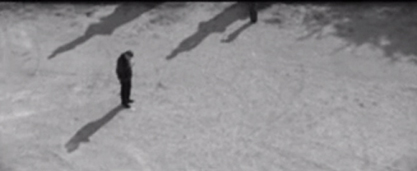
LB: You described the way you work with technological instruments as “particular and limited.” Another way to look at this is that you make the technological system slow down by inserting yourself into the process… and the result is your drawings, which still movement. Might this be one role for art — to insert the human into the machine? Much net art focuses on flows of information, virtual movement, and representing that. While not quite glitch art, do your representations of movement in some sense intentionally put a brake on the machinery?
MS: I find your words enlightening, you describe my way of working better than me….. Actually I insert myself into the technological process…..but this is not a statement of a position against technology.
I can say that what interests me the most (and art’s relation to science is just one instance of this) is the thread of connection between specific cases and general theory, between subjective and objective. Between, on the one hand, the singularity of events and, on the other, general theory. The individual’s experience is singular, unique; but there is always a thread, even if fine, that leads each individual case to a wider generalisation. What interests me is this incessant – indispensable as much as concealed – mental activity that every day leads us to search for generalisations and regulating principles. What interests me is the human tendency to comprehend phenomena, even the most complex, via schematic representation, via a generalisation that leads to the identification of organising principles. I mean “Comprehension” in very wide sense, where emotions and feelings participate too in embracing reality, including reality. Maybe in this sense I put the human in the machine…
There is a discrepancy between how we perceive reality, mediated by our senses, and the truth decreed by science. On a rational level we recognize the truth, but we cannot internalize in a deep way this knowledge; this is beyond our human capabilities. I think that in my artistic research I find myself in this deep discrepancy.
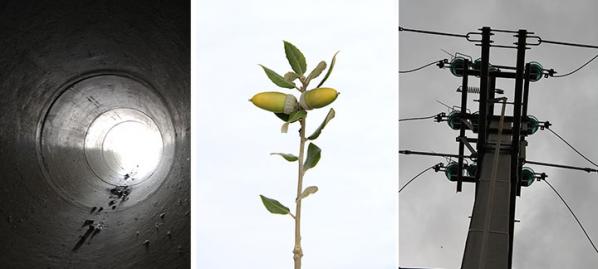
LB: Bryan Connell, your work in Marseille addresses, among other concerns, technology and its relationship to nature. Do you see the urban environment as playing any particular role in that relationship — of having a particular status in our negotiation of it?
Bryan Connell: One of the things that intrigued me about the metropolitan hiking trail in Marseille is the way it plays with our sense of meaning and value in the exploration of contemporary landscapes. Most long distance hiking trails are designed to lead out of urban environments, not into them. We don’t usually think of carrying a field guide that illustrates the taxonomy of fire hydrants, electrical pylons, or urban weeds on an extended city or suburban walk. That kind of engaged, systematic attention is usually reserved for wild natural terrains. From a traditional environmental perspective, the less altered a place is by human technology, the more scientifically interesting, ecologically exemplary, and aesthetically rich it’s going to be. Without undermining the validity of ever-present environmental concerns, the trail functions as an invitation into a more challenging and complex relationship to the emerging para-wilds and novel ecosystems that are arising at the intersection of the natural world and the technological infrastructure of the built environment.
Similarly, the Marseille trail doesn’t really focus on the kinds of urban sites that are traditionally thought of as having significant historic, architectural, or cultural interest. Instead, the trail route incites visitors into an exploration of the everyday environments and working landscapes of the contemporary urban transect – a world of parking lots, freeway overpasses, suburban developments, abandoned railways, and semi-rural wildlands.

Landscape ecologist Earl Ellis argues that to better navigate our way through the current geohistorical epoch, the Anthropocence, we must expand the traditional ecological concept of regional biomes into the parallel notion of “anthromes” – biomes that are complex interconnected melds of human technology and natural systems. In a sense, the GR 2013 Marseille trail is a sketch or system of exploratory paths into what a publically accessible, anthrome based urban ecology observatory might look like.
LB: A similar question is in relation to the image, especially sequential images. What does it mean for our negotiation of the relationship between nature and technology? Between science and art?
BC: We increasingly live in a networked digital metropolis with an image and information density that both mirrors and exceeds the high population densities of the physical metropolis. One topic of particular interest to me is the role these images play in transfiguring the quality of our desire. To what extent do scientific or aesthetic images that increase our ability to find meaning and satisfaction in observing and understanding urban landscape phenomena mitigate our need to physically alter the landscape to conform to an idealized image of what it should or shouldn’t be?
For example, the Marseille metropolitan trail didn’t require much physical alteration of the terrain – it’s a conceptually designated network of pre-existing roads, paths, streets and highways. The trail’s function is not to alter place, but alter the cognitive landscape of trail users so they have a richer sense of place. If you are fascinated by the diversity of ways a para-wild plant population has adapted to a technologically modified environment, do you need to engage in an energy and material intensive re-landscaping of that environment with a palette of conventional horticultural plantings to make it more “beautiful”? In this sense, constructing interpretive images of landscape is more than a way of augmenting a recreational hiking experience, it’s a way of shifting and re-configuring what we think we have to consume and alter to find meaning and vitality in contemporary landscapes.
http://uranus.media.uoa.gr/hc2/
Hybrid City is an international biennial event dedicated to exploring the emergent character of the city and the potential transformative shift of the urban condition, as a result of ongoing developments in information and communication technologies (ICTs) and of their integration in the urban physical context. After the successful homonymous symposium in 2011, the second edition of Hybrid City has grown into a peer reviewed conference, aiming to promote dialogue and knowledge exchange among experts drawn from academia, as well as artists, designers, researchers, advocates, stakeholders and decision makers, actively involved in addressing questions on the nature of the technologically mediated urban activity and experience.
The Hybrid City 2013 events also include an online exhibition and workshops, relevant to the theme
Hybrid City Conference 2013: Subtle rEvolutions will take place on 23-25 of May 2013.
The Hybrid City II events will take place at the central building of the National and Kapodistrian University of Athens.
This document was edited with the instant web content composer. Use the online HTML editor tools to convert the documents for your website.
Some have proposed Jennifer Chan to be part of what has been termed as the post-internet era. But, this is an inadequate representation of the spirit, criticality and adventure at play in her work. Chan’s awareness and use of the Internet reflects a way of life, that situates its networks as a primary resource. Chan lives amongst various worlds and engages in different shades of being; a self-described ‘amateur cultural critic’, a net artist, a media artist, and academic. Her work exists both online and in physical realms, it is always present and contemporary. This is because her work lives in a world where the scripting of official art definitions loses its power. People have exploited technology to facilitate new behaviours where the artist or art amateur redefine what art is on their own terms. We are now in a post-art context. It reflects a very real, societal shift. Mainstream art culture no longer owns the consciousness of art, Chan and others like her are pulling it apart.
Marc Garrett: In your video Interpassivity a kind of docu-performance made for the exhibition REALCORE, you’re in a park spraying a brown cardboard box, silver. As you go through the process of walking around the box whilst spraying it, you comment on the object’s formal aspects. But, what you mainly discuss are your own personal views about contemporary art. It then becomes apparent that the box is a prop for the performance, enabling the subject to be explored.
Alongside your interpretations of the work my own thoughts on the subject feel as though they are included in the conversation. I know as a viewer, that the artist is not aware of my thoughts on the matter. However, it feels like there is space for me to be a part of the conversation. Not literally through a feedback system or interaction, but as an individual considering your personal questions. The artwork knows I am experiencing it, it knows that a consciousness out there is somehow engaging with its dialogue.
It is clear you are in tune with the feeling of dysfunction. You say, “I need to spit out some creative truth”. On hearing this, I was not sure whether this was a parady, irony or an expression of despair, or all these. You also say “contemporary art is removed from our everyday feelings”. As you express these words I begin the view the box as a symbol of contemporary art as a centralized, institutional monolith? So, before I unwittingly place my own meanings onto the work could you tell us what it means to you?
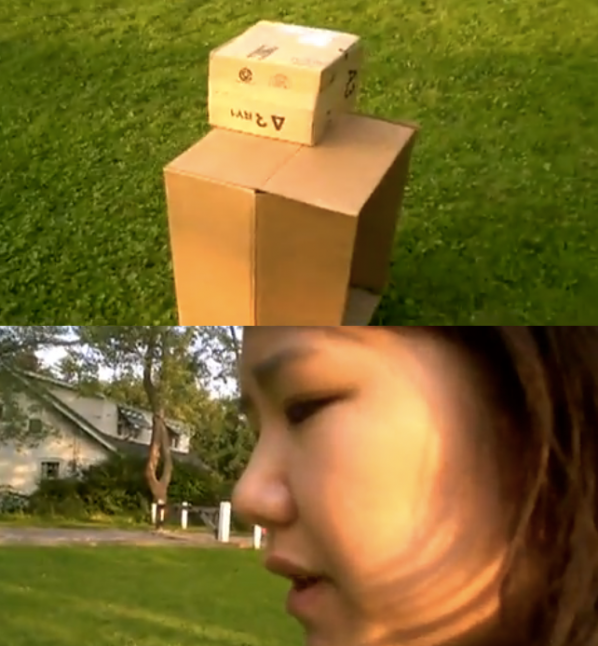
Jennifer Chan: Interpassivity is the instance of something cueing an audience to feel a certain way, such as canned laughter to stand in for humoured social reaction to jokes in a sitcom– even when it’s not funny. I titled it that because I felt like another art student trying to convince herself or the viewer what she made is art. I feel embarrassed about this self-aware but privileged complaining. A few people have found this work online and screened it, but I’m still mortified to watch it with them.
I made that video because I think a lot of contemporary art is sterile, mannered and removed from emotion. I wasn’t thinking of Donald Judd at that point but I could see the box standing in as a poor attempt at work, like his work. What I was working on (or seven years of art education) had little to do with what was happening in my life. (So to answer your question, yes, it is despair) Using my flipcam and talking over it was immediate for recording those ideas. It’s also a big trope of Canadian video art… a breathy voiceover conveys something serious and personal.
re: REALCORE. The title came about as a play on the idea of “real life”, or face-to-face life away from keyboard. Likewise, users would say “irl”(in real life), or “so real~” in Facebook comment threads to joke about the divide between online/offline contexts. The curator David Hanes felt the video was important to contextualize my use of sincerity and clichés, I was not being ironic in my intention. Arielle Gavin and Jaakko Pallasvuo thought it was questionably ironic and an emotive perspective on the Internet as a form of new sincerity.
I later found that someone wrote a paper by someone who coined “realcore” as a kind of amateur user-generated porn, which is a cool double-meaning. The “interpassivity” video was used to promote the show online but I showed my kitschy found footage videos on twisted pizza box plinths for the show. This was my fuck-you to geometric minimalism and boring white plinths, but I suppose it resulted in a different take of it…
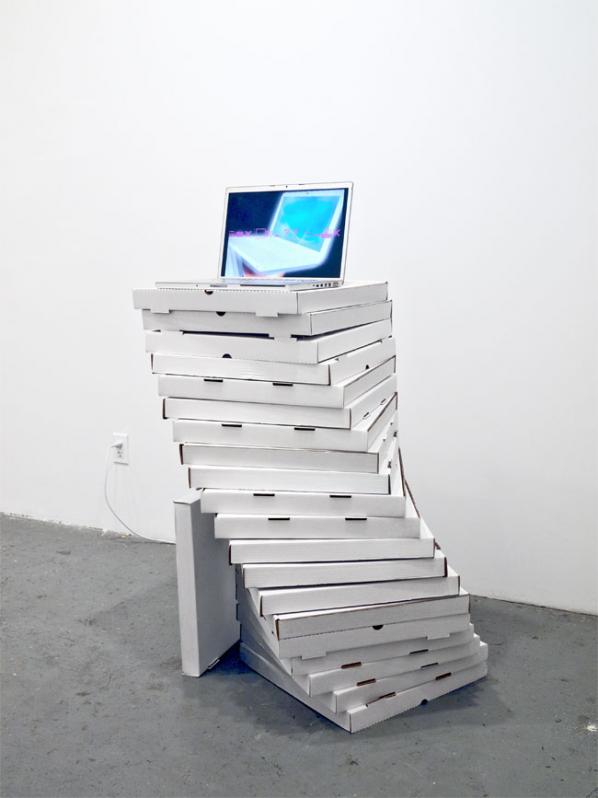
MG: In one of your recent videos “Grey Matter” when watching it felt like I was immediately pulled into a remixed world of teenage celebrity, products and brands, dripping in an orgasmic noise of techno-capitalism. Most of it is found footage, images, video and sound remixed into an edited compilation. Running through the video in between the high octane fuelled cuts and glitches, are messages to the Internet user who chances upon the video. These messages feel like they are from an individual voice but also of a multitude – caught up in a constant state of mediated folk hedonism.
What intentions lie behind this work as an artistic explorer of the entertainment culture you have remixed?
JC: Grey Matter is a first person account on feeling politically inactive online while having access to a wealth of information. I wanted to use remix in a confessional manner, so I combined obscure nostalgic media with embarrassing statements. The video begins with sped up footage of early 3D simulator ride called “Millennium Bug”. Y2K was the first technological “crisis” I recalled with clarity when I was growing up. The rest of the video includes cynical commentary on online spaces I’ve engaged with in the past year. (shopping on aliexpress.com and lurking people on OkCupid) “Little Prince” is compressed 25 times and sped up by 400%. I included old profile pics and some summary text from my OkCupid profile–I thought it was quite telling about how I wanted to be seen online and irl. I think it’s possible to feel mutually exclusive feelings at the same time, or maybe the experience of being active on different social networks produces a kind of schizophrenia. Collaging Internet pop culture is a way to appreciate it-as artifacts-in a complex light, and to be critical of it by acting out within its language.
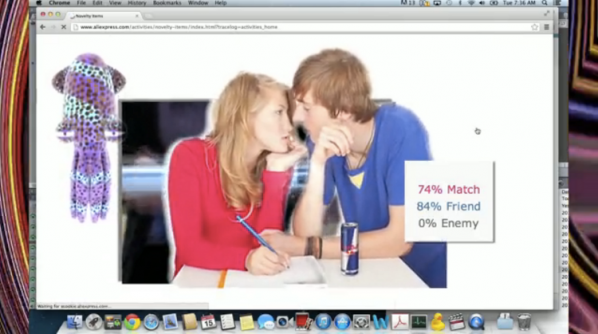
MG: What do you find fascinating about popular culture on the Internet?
JC: Anything minuscule has the potential to be popular amongst disparate users and they form vernaculars to talk about their interest in that. I find that desire relatable. That is what I think of as “community” online. It’s based on human interest and media fandom. Justin Bieber is made into something of a scapegoat for the first world’s shortcomings; people who like his image/music idolize him, and people who hate him are waiting for him to crack. Both are forms of fanaticism (one based on affinity; the other on hate-watching something.) Supercuts of Justin Bieber hairflips, object crushing fetishists, disease forums, long threads debating a detail…etc. I like the solipsism and intensity of all that.
MG: Can you share with us some of your critical insights and personal pleasures on this subject?
JC: Pop culture is paradoxical and audiences selectively enjoy it. (like teens dancing to hip hop with irreverence to its violent or sexist content.) Consuming and sampling pop allows people to indulge into its meanings, and through this there is a reconsideration of what “the masses” find important. Like the use of “users”, “masses” is what cultural studies calls everyone or everyone except-you. But every “user” has a specific relationship with interfaces and platforms, so they aren’t so homogenous.
Pop culture is also political. There was a time when more people voted for American Idol than the US elections, and if 10,000 people showed up to the 2012 cat video festival, entertainment is generally more seductive than current affairs–until there is a gatekeeping emergency (like mainstream media not covering the early days of Occupy). In terms of “internet pop culture”, perhaps traffic with social networking has overtaken porn and gambling online, but social news is also a kind of entertainment.

MG: Olia Lialina and Dragan Espenschied in their book Digital Folklore they celebrate everyday people’s use of personal computers with “glittering star backgrounds, photos of cute kittens and rainbow gradients”. They value the non-professionalism and amateur spirit that has come about from millions of people enjoying the Internet since it started. There is a difference now, the Internet masses have been shifted and prodded into large web 2.0 frameworks such as Facebook, and an abundance of personal web projects have been lost since.
And, like them do you find reassurance or a personal connection with the Internet Amateurs of the world?
JC: In context of new media art, it’s probably more accurate to think of amateurs as people who don’t self-identify as artists or technicians. What non-artists do with software and video appears facile, sincere, and intuitive. I make amateur-looking work to dialogue with that.. I like to say something dumb to say something serious. Something that’s made simplistically and filled with kitschy references can be packaged as critique that also appeals to non-art audiences.
I caught the tail end of the homepage-o-sphere/webring 1.0 period. Non-artists made personal websites out of a genuine interest in something. tumblr and pinterest is used in a same way today–to collect indiscriminately. Like 2.0 frameworks, the early internet also had free webpage hosting that users relied on (Geocities and Lycos). Personal website design isn’t over either; net artists still make them or bind together to create their own sites (like tightartists.com). I think I have an idea of what you mean though; it was less commercial and there weren’t as many distinct “most-visited” places online.
I made a lot of gothy dark art on DeviantArt before I knew about contemporary art, and my sensibility towards Photoshop was more romantic and impulsive without the baggage of art education. Maybe this “revival” cult of amateur-looking digital folklore happened because I/we exoticize that kind of amateur production. Web vernaculars have also become stylized and this aesthetic is shared with seapunks and filmmakers. Artists need to adapt to that.
MG: What do you feel is still alive and open for everyday online expression and play, in respect of what Lialina and Espenschied perceive as Digital Folklore?
JC: I think a lot of emerging artists have a greater awareness of obsolescence and upgrade culture than we give them credit for–while still complacent to the socialization structures on Facebook. Many seem more interested in navigating these networks to question their inner control mechanisms than overthrowing them or innovating new ones. It can be simple things like friending as many users as possible, looping webcam feeds, archiving and re-uploading banned content on different platforms, having an anonymous/alternate personas/using multiple accounts…etc. People like glitchr and Ian Aleksander Adams are always looking for ways to use a system against its intended functions in the same way jodi did all the cheat moves in max payne CHEATS ONLY. I admire glitch practices for that.
There’s also the possibility for re-appropriating anything to rebrand or critique particular communities. I think Angela Washko and Jaakko Pallasvuo are doing this in a compelling way that covers a large territory between art and Internet culture.
MG: So, what are you working on at the moment?
JC: <–for some reason this sounds less perverted than if I were an old guy doing this to teen girls but its really just as perverse–>
I’m observing what young adult/teen boys do on YouTube: bulking up, performing dares, talking about how to pick up a White/Asian girls etc. I’m also making a video about Asian guys (both diasporic, Asian American, and more specifically, Korean and Taiwanese men) and their interpretations of mediated masculinity. There is something disturbingly tantalizing in terms of how they have learned to look at the webcam as if they are boy band stars yet they are not fully grown men. A lot of this is informed by growing up in Hong Kong, and knowing that fashion and romance, is inspired by many “neighbouring” cultural media from Japan, Korea and Taiwan even though American/British influence is also prominent in the club scene.
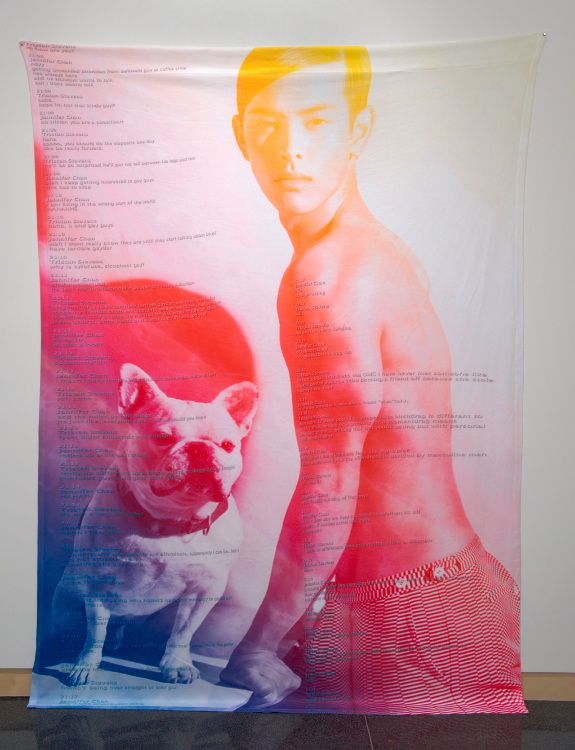
Here are two images from my late installation that will foreshadow this interest. It’s chat text over layered on modified fashion and makeup adverts targeted at Korean and Chinese men, and printed onto micro-fibred bedding. I feel like they’re treated as pleasant freak shows on tumblr but this imagery is a banal, idealized kind of masculinity in Asia. I think western facial features are really common amongst these popular images of Asian-ness, and most would tend to read it as aspiring to western culture, though the hyperfemme “doll” look or metro-masculinity has been a regional style since the 90s.
Chan’s work reflects an emerging condition described by Zizek as “interpassivity” in which our engagement with interactive experience has lost traction and is replaced with “its shadowy and much more uncanny supplement/double “interpassivity””[1], a “Fetish between structure and humanism”[ibid]. We are pulled into a paradox, where ‘interaction and passivity’ are joined together as spectacle of constant mediation. Millions have joined online centralized, megastructures such as Facebook, and this is not a black and white situation. Many are coerced from social and consumer pressures into the state of being seen as interacting. As the futuristic time machine streams onwards at high-speed, agency slouches into a spurious and distant dream. Others and the same are enjoying the flow for the sake of self expression within these scripted frameworks.
Chan’s work critiques, plays with, and exploits this networked, social intervention, as well as her viewers’ desires. Her imaginative palette revivifies questions about agency, passivity, sexuality, privacy, individuality, behaviour, networked consumption and its production. These remixed artworks have much material to work with, as the endless ether of everyday noise is uploaded and distributed through blogs and social networking sites; then returned into the ether as cut-ups where a transforming culture is engaged in its own mutation.
Its noise engages us whether we enjoy it or not, in the medium of “interpassivity”, and we all find ourselves caught within this spectacular enticement driven by the Netopticon. “On a holiday trip, it is quite common to feel a superego compulsion to enjoy, one “must have fun” — one feels guilty if one doesn’t enjoy it.”[ibid]
Jennifer Chan – http://www.jennifer-chan.com/
Heavy MetaVernacular video after the popularization of the internet
http://jennifer-chan.com/index.php?/curatorial/heavy-meta/
SELF-LOVE A non-consensual exhibition of emerging net art
http://jennifer-chan.com/index.php?/curatorial/self-love/
New Insularity Peer backpatting. A screening of works by friends and users whose works I admire.
http://jennifer-chan.com/newinsularity.html
Feeling VideoThe affective appeal of antisocial video
http://jennifer-chan.com/index.php?/curatorial/feeling-video/
Trivial Pursuits Distracting “new media art”
http://jennifer-chan.com/index.php?/curatorial/trivial-pursuits/
First off, some claims, some general, some particular. I’m going to use these to speak about the work under consideration and in turn call upon that work to support the claims. A kind of virtuous critical circle.
General: works of art are not messages but objects. They don’t say things nor ask questions, nor assert, nor investigate. Neither do they as objects have messages somehow encoded or embedded within them. To assert otherwise is a massive category error.
As objects they may of course be brought in evidence, copied, become conversation pieces, be described well, be described badly, be described perversely, be seen, be half seen, be missed, be lost, be found, be written about, point to things, be compared and many other things, some of which have not yet been imagined.
Further, artworks are fuzzily-bordered and not necessarily of a physical or temporal piece – the object is not simply the object (and ‘the object’ might not be physical but words, a concept, a sound recording, a protocol) but everything that accretes as a result of it – commentary, jokes, other artworks made in response. If mathematical terminology wasn’t so regularly and toe-curlingly abused in the arts, we might refer to them as manifolds, not necessarily connected.
Even the historical is not immune. There’s a reaching back in time where an established work is transformed retrospectively by homage – ‘Las Meninas’ an obvious case in point.
Also: the work of art is finite – it was born and it will, one day, cease to exist (and it will be forgotten, or there will be no-one to remember it). Everything changes, everything dies.
This implies, too, that although the individual author matters, as product of a unique formation and a unique set of locations in time and space, every artwork is socially authored.
Particular: Abraham’s work represents a new conjunction of technology, collaboration and performance as a generator of moving image. It has precursors (freely acknowledged, indeed celebrated) but it is qualitatively new. The moving image work comes in two flavours, fresh and preserved, both with their own particular and delicious savour. Abrahams conducts live performances on the internet. These performances occur singly, as pieces in themselves, or form part of the programme of events accompanying exhibitions. The moving image pieces in this show are all derivations of this kind of performative event. Except derivation has an air of the hierarchical and the types of piece form no hierarchy any more than fresh or smoked salmon do.
A final general claim: writing about art is not a science but itself an art. Sometimes the brush will be delicate and sometimes broad. There is no recipe or rules or template. One can be too delicate – sometimes confusion is good, particularly in the matter of the affective. Crude thinking sometimes gets us further, paralleling, not dissecting, the richnesses of work. There are some mysteries one should leave as such.
OK. Onwards and upwards…
Performative is currently a much used, some might say overused, word. One quite common usage is to suggest that a work contains visible or at least trackable traces of its own making, a kind of archaeological or sedimentary record, and that perhaps this might have been to varying degrees intentional.
Of course it’s arguable any work of art is performative in this way and that it’s quite hard to erase the trail behind you whether what you make is time based or photographic, sculpted or made with hand applied pigment of one sort or another. Continuous looking and thinking about art for any length of time, especially allied to making stuff oneself, whether dabbling or something more serious, hones an increasing sensitivity to these questions. And this matters; particularly when it comes to over-nice distinctions between close relatives such as the still and moving photographic image and esoteric arguments about how time is differently present or presented in each of these and in other further flung practices too. The new scholasticism feeds on ever finer such distinctions.
So it’s a relief to come across work, which is genuinely performative, enough so that even someone undrenched in theory can see it, can get it and can be delighted and exalted by it. Furthermore work that smells unmistakably of the human, that abuts the high and the low, the crude and subtle, that blurs boundaries, that borrows and echoes the work of others not with the pinched expression of someone with a theoretical framework but in a spirit of ‘why?’ and ‘let’s play’ – the two childish precursors of grown up science and art.
Annie Abrahams’ show at the Centre Régional d’Art Contemporain Languedoc-Roussillon in Sète is a graceful and elegant dog’s dinner of a show. Physically it’s odd, exiled to the upper floor (still a generous space) whilst Catherine Gfeller, someone altogether more easily glossed and hence exhausted (though not without merit) gets the more conventional downstairs galleries (and attracted the lion’s share of the press on the opening night.)
Said upper floor comes in two instalments – a lovely hangar type space, where a game of golf seems distinctly possible, with a kind of tail leading off it, a long thin corridor which fattens a little towards its farther end maybe 100 metres away.
The layout of the show utilises this peculiarity nicely. In the big room a very large two projection installation, Angry Women, spans one corner and takes up a considerable portion of the two adjacent walls.
In the far corner, diagonally opposite, a monitor, with two chairs and two sets of headphones, of which more later.
Leaving the larger space, two more monitor based pieces at junctions where it’s possible for an individual to sit and others to pass. Five chairs arranged in a circle with copies of two books of interviews on each (one with Abrahams, and one with a selection of other cultural figures) and highlighter pens. In the middle of the circle, a pile of blankets. A larger wall piece of rough and ready cardboard placards with texts (“mutuellement vulnérable”, “euphorie communicative”, many others) in various hands.
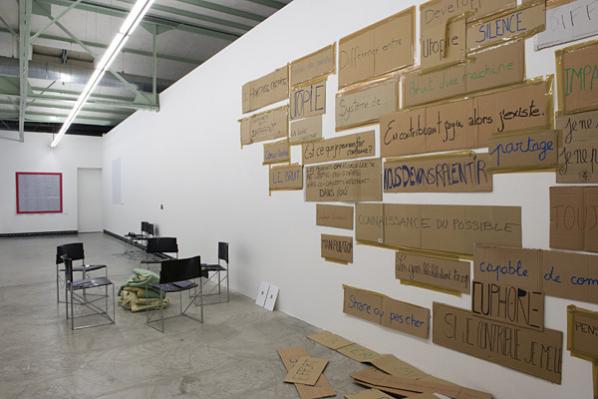
At the far end, a number of framed photo and images based pieces plus a work consisting of a single photograph and headphone delivered audio (it’s a snapshot – snapshot size, snapshot aesthetic – of husband and wife volunteer fire fighters. The audio is manipulated audio of texts on the subject of fear read by them. Let’s not try and place all this into any sort of context yet. Let’s set out our stall, enumerate, account, describe.)
A final deft touch is the symbolic linking of the two areas by a ribbon of text occupying the 15 or so centimetres above the floor, skirting board height, the topic of which appears to be mental illness (and all elegantly lettered except for one point where a letter had been omitted and is inserted with a caret symbol.)
Most of the pieces employ texts or performances – both gestural and textual – by others – often created according to some seed question or protocol. The texts often come from questions posed on the internet but sometimes from workshop or outreach type (type –this is to tentatively and provisionally locate the thing – it’s outreach Jim, but not as we know it) activity.
The performers in the moving image pieces are geographically dispersed but brought together at a single time by webcams and some custom software that Abrahams has used on a number of occasions where the web-cammed-in participants occupy a space in a rectangular grid (aficionados of seventies UK quiz shows such as Blankety Blank will get it immediately).
There’s a fragility, a delicacy, a tentative hold on existence, a testing of our belief, about these works that so many works of fine art – as opposed to design – have. The sense that what we have incorporates the idiosyncrasies, indeed the weaknesses of the support materials and media, into a final object (the same sense as when an artist wilfully uses something manifestly not intended for art, or allows mistakes to stand, or omits, or makes all too evident repairs; this is not new. Think pentimenti, or the hasty addition of an extra panel of canvas or paper to take account of expanding ambition or vision, or the aestheticized unevenness of Japanese tea-ware.) This sense of object-hood rather than message or statement is key. An objecthood which in retrospect could not have been other, but equally could not have been proposed, foreseen, except in its protocols of playfulness.
The pixellation, dropout, glitching, concomitant upon the pushing of the current state of the network to its limits in the multi participant pieces (and this reminds one of how flicker and roll and a general fuzziness become now part of the Acconci piece Abrahams draws upon in her Theme Song After Acconci – which reasons of space preclude too much detail about here – suffice it to say Abrahams honours, compresses, feminizes, satirises and intensifies the original. If Acconci could have had access to a “better” technology, one where the speed was constant, where no flicker or roll appeared, would he have then felt it served his purpose better? Did what he saw even look fuzzy or worn to him? Probably yes, compared with the film standards of the day, as does Abraham’s work compared with high end digital video [and even the current, rather good, quality of You Tube].)
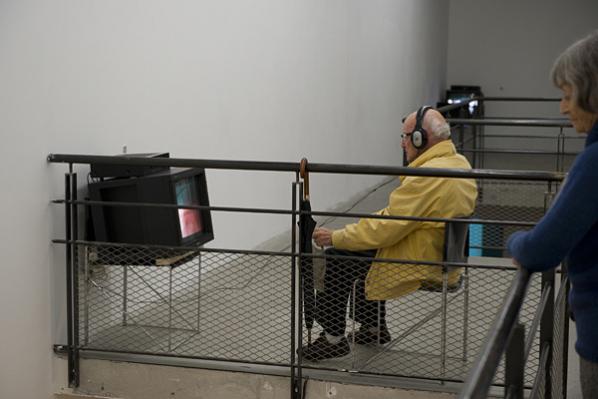
To offer participants a protocol is paradoxically both to assert and to cede control, to know and to not know how things will turn out (an analogy is the use of chance in the works of Polish composer Witold Lutosławski, where the mechanisms make the generality of the sound, its broad texture, predictable but any particular instance impossible to predict or even fully imagine [but all, please note, a matter of degree because the finer the grain, the greater the level of magnification, the more we can find such uncertainty in anything unfolding over time – it’s a question of our norms – what is the difference between the Stockhausen piano pieces where the performer can choose the order of segments and a Mozart sonata where the tempo may be quite widely varied? – in principle, none])
The piece Pourquoi avons-nous des difficultés à ouvrir un ordinateur et en changer le disque dur? plays on a single monitor with the screen divided into two areas. In each we see, sometimes with difficulty and ambiguously, parts of a computer, screws, connections and hands.
We hear two voices, one that of Abrahams and the other her co-performer, discussant, what have you, Eliza Fantozzi, speaking in French. In the version at Sète there are English subtitles which even for non English speakers provide a kind of functionality, meaning, in that the words tend to be positioned on a line from left to right according to who is speaking. When both speak suggestive gaps appear, though these cannot be read definitively).
The subtitles are in a strange (for a native English speaker) near-English (the title, for example, is translated as “Why do we have difficulties to open a computer and change its hard disk?”).
This is, it must be said, cute, amusing and engaging and it underscores the altogether naughty childlike quality of the entire interchange. The characters (for I think one should mistrust the assumption, however tempting, that we have here unmediated access to the actual participants) are playful – amused and amusing. At the same time they ruthlessly anatomise the roots of their difficulties with technology (but the performativity avoids being on–message in any sense and makes for something strange, complex and even uncomfortable. At one point Fantozzi complains of the lack of colour variety inside the machine and starts painting the components with nail varnish to “create a much merrier circuit” – Je crée un circuit beaucoup plus gai).
Later Abrahams lays into a ribbon connector with a pair of scissors and then starts apparently fringing it with regular cuts half way across … There is an association of the decorative, the playful and a rejection of the serious which is somewhat too close to many gender stereotypes to be entirely comfortable. (The piece was originally performed on international women’s day 2011) And yet, and yet – the end result is complex, for there is a steeliness to the play and a self respect and assertiveness. Perhaps (I don’t know. I don’t think there is a definitive answer. I don’t think close reading or theory can bring us it either) it is the very truthfulness, the richness of the incorporation of the world as it is and not as we might like it to be from which this springs.
Before we get to the physically largest and most imposing presence in the show we’ll look at its neighbour, comprising two chairs, a monitor and two sets of headphones.
Double Blind (Love) is a record of a 264 minute telematic performance by Annie Abrahams and the US artist Curt Cloninger which took place on November the 29th 2009. Annie Abrahams was in the Living Room (Espace de création contemporaine) Montpellier, France and Cloninger in the Black Mountain College Museum and Arts Center, Asheville, North Carolina, US.
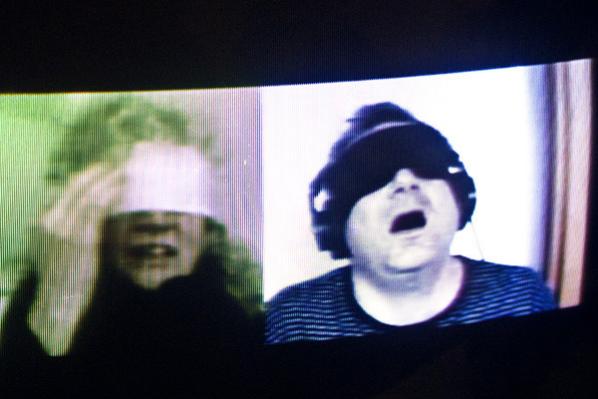
Both wore blindfolds for the entire duration of the performance, which was a joint telematic musical (and I use the word advisedly; though Abrahams describes Cloninger as a musician she appears to reject the description for herself. I think she is mistaken) performance taking the form of an improvisation, largely vocal but with some keyboard input from Cloninger, around a short musical cell from the track Until the End of the World by U2. The section in question has a repetition of the word “love” for its sole lyrical content and occurs just over midway through the song. It would perhaps ordinarily be described as a chorus but in fact appears only once in the song (although it continues as a backing vocal throughout the next verse), one of the first of many tiny idiosyncrasies on our pathway, peculiarities which add cumulative spice and interest to the project. I’d always found U2 banal and full of bombast but going to the song, under the circumstances of researching this piece, with necessarily open eyes and ears was a small epiphany, one of a number occasioned by a systematic engagement with Abraham’s work.
It’s worth noting that much of the structure of this piece came originally from Cloninger. In the previous year he had performed a number of pieces under the title “pop mantra” where in a live situation he repeated a similar pop music cell for a period of hours (“usually blindfolded”).
Cloninger had also video documented these performances though at this point this is documentation and lives no independent life of its own.
Let’s take a look at these proto ‘Double Blinds’. There is as yet no suggestion of interchange, of development. Although this is clearly a more obvious option with two performers, conscious development is not impossible in a solo performance. It does however appear to be consciously excluded. In an echo of the process or systems driven works of the seventies, Cloninger sets something in motion and allows it to unfold. He attempts to repeat the phrase many times. Presumably his arms start to ache and his voice to tire. This trial of endurance becomes a principal motor of the pieces. What does this evoke? For me, and you might share this, there are the dance marathons of the twenties, the notion of sport, especially individual sport, of pitting oneself against oneself; there is ritual repetition – Sufi whirling, or that carrying out of repetitive, gruelling and apparently pointless tasks sanctified in some Buddhist traditions; the pilgrimage; there is a kind of practical prayer through ritual, suffering or self-abnegation.
The motoric unwinding and associated characteristics obtain in Double Blind, too. What is new, what comes from Abrahams, is the telematic – the fact of separation by an ocean and the fact of collaboration. Indeed there is an inbuilt sharper contradiction as the collaboration separated by so much physical distance is of the peculiar intimacy that attends musical partnership, improvisatory or not. (A couple of years before Abrahams had performed a telematic kiss for three hours with the US artist Mark River.)
Despite Abraham’s denial the finished performance falls entirely within the established parameters of the musical. Precedents such as the work of Meredith Monk could be cited for Abraham’s compelling vocalisations – song, whisper, shout, scream, cry of pleasure, cry of pain – whose musico-dramatic logic and sensitivity to her performing partner, this listener at least, finds totally satisfying. It’s a touching partnership, with both performers bringing a fierce commitment to the task in hand but also each bearing different gifts – Cloninger, a formed musical sensibility supported by conventional skills and Abrahams a kind of discovery/invention of improvisation (indeed of music) ab ovo.
Thousands of years in 4 and half hours.
There is a formal challenge and satisfaction too, common to both Abraham’s and Cloninger’s concerns – how much transcendence can be mined, discovered, invented, from the small, the insignificant? Can it be exhausted before we are exhausted and what does the transfiguration brought about by the attempt suggest about us as human beings?
Two performers. Two chairs for two spectators only. Likewise, two sets of headphones.
Grace.
Opposite, stretching luxuriantly out, is the exhibition’s jewel in the crown – Angry Women, created by Abrahams and twenty two other women of many nationalities, speaking about anger; acting out, demonstrating, reflecting, on anger, on webcams from their different individual locations and in their native tongues, with the images being sent to the 3X4 grid, in a format that Abrahams has made her own. Because of the limits of even current streaming technology it was necessary to conduct two separate performances (separated by an interval of a couple of months). The length of each performance was determined by a protocol where a minute’s silence by all participants signalled the end. This resulted in pieces of differing lengths which lack of synchronisation adds another layer of fragile grace to the final projections, projected large on adjacent walls around the corner joining them with sound from the left images fed to the right speaker and vice versa.
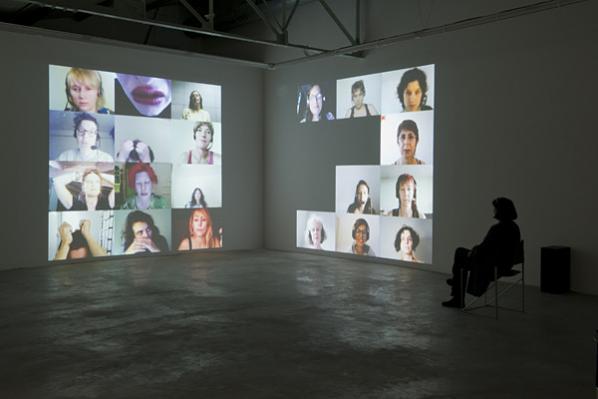
The effect is visceral – we face what feels like a wave of humanity, not so much in numbers, although 23 is impressive, but in the infinite malleability of the face, hands and of gesture and expression and of how these things can occupy the frame. Sometimes that frame will resemble a Giacometti portrait, with the subject appearing to recede into what seems to be endlessly deep space. At others red lips or an open mouth, sensual and terrifying by turns, occupy the whole of the space – and furthermore each cell is constantly in flux (because these are living, breathing unpredictable human beings). There is something both of portraiture and of the dance at work, and a species of found poetry too, which the moving image work has in common with the collaborative texts at the other end of the exhibition. The combination of iron control, planning, foresight (the grid, the protocols) with a letting go and a trust elsewhere – the phased lengths, the blank space for the person who didn’t turn up, the performative possibilities – makes for something of great richness.
Additionally it’s clear that those of the performers who have previous experience are consciously playing with and against their fellows – gestures are mirrored, sounds echoed, the fiction of looking elsewhere (to the side, or above) in the grid is impressively deployed.
The angry women turn out to be at one and the same time very particular –unique – women and women in general too; the women in general turn out to be human beings in general (and general en masse because each so particular) and the human beings in general turn out to live in this, one, our, very particular, world – that mysterious, frightening and wonderful place.
In keeping with the cheering on of lack of clarity, of mess, of crudity I’ve espoused so far in this piece (and will continue so to do, here and elsewhere) I want to say we need to take the exhibition (and the world) as a whole. Offering us the video and the still image pieces and audio means we cannot but think of them together (we can choose to artificially isolate pieces but we cannot undo our knowledge of that whole). So to the extent that I have selected topics here I have done violence to Abraham’s art, which has no message, is not confined to any one medium, collaborates in multiple ways, borrows, steals (and gives) and presents us with a set of marvellous and mysterious objects which afford us a spectrum of entirely new pathways to the world, to seeing it, talking and thinking about it, ourselves, after we have gone to the bar or got on the train north to Paris and thence homewards, happy and somehow a little changed.
—-
Training for a Better World – Annie Abrahams
Centre Régional d’Art Contemporain Languedoc-Roussillon, Sète, France
28/10/2011 to 01/01/2012
Sat 19 – Sun 20 January 2013: One Minute Volume 1-2
Sat 26 – Sun 27 January 2013: One Minute Volume 3-4
Sat 02 – Sun 03 February 2013: One Minute Volume 5-6
Contact: info@furtherfield.org
In partnership with 20-21 Visual Arts Centre, Furtherfield Gallery is pleased to host One Minute Volumes 1-6 curated by the film-maker Kerry Baldry over three consecutive weekends in January and February 2013. The programme will also be shown at 20-21 later in 2013.
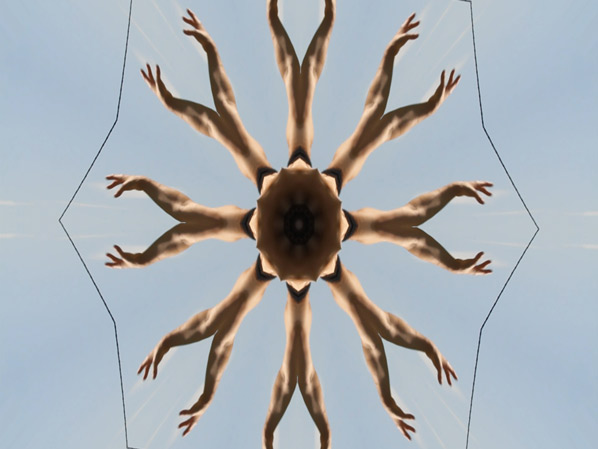
One Minute Volumes 1-6 are an eclectic mix of artists moving image constrained to the time limit of one minute and include over 80 artists at varying stages of their careers.
The artists involved range from established figures, such as Guy Sherwin and Catherine Elwes, to comparative newcomers through a multinational roster of those in between; and the methods deployed and content treated of are hugely diverse, a master class in the very short form film.
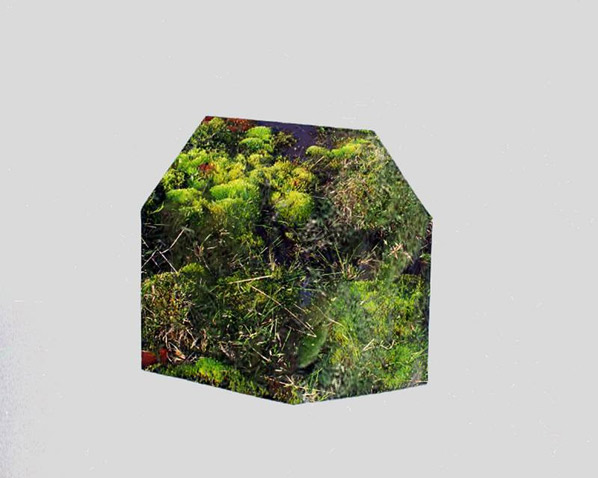
Gabrielle Schwartz writes in a recent review in Varsity, a Cambridge University publication:
‘There was no way of knowing what is going to come next; only that (while it might be beautiful, it might be funny, it might be incredibly weird) either way, it would be finished in a minute’s time – and so you might as well wait and see. This element of expectation as well as the consistently thought-provoking and entertaining quality propelled me through the volume, never once resulting in boredom’.
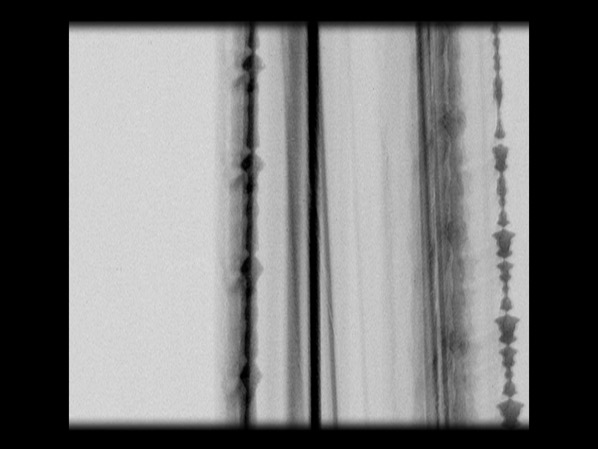
FACT in Liverpool, Artprojx Space – London, Directors Lounge – Berlin, London Underground Film Sessions – Horse Hospital, London. National Museum of Contemporary Art, in Bucharest, Plymouth Arts Centre, S1 Artspace – Sheffield, The Hull Short International Film Festival, Castlefield Gallery – Manchester, Peloton Gallery – Australia
Chris Meigh-Andrews, Kerry Baldry, Steven Ball, Kelvin Brown, Rose Butler, Daniela Butsch, Samantha Clark, Callum Cooper, Michael Cousin, Chris Paul Daniels, Gordon Dawson, Claudia Di Gangi, Fil Ieropoulos and Lilly Zinan Ding, Ron Diorio, Annabel Dover, Catherine Elwes, Clint Enns, Andy Fear, Unconscious Films, The Gluts, Dave Griffiths, Leister/Harris, Steve Hawley, Nick Herbert, Tony Hill, Virginia Hilyard, Elizabeth Hobbs, Riccardo Iacono, Hilary Jack, Tina Keane, David Kefford, Deklan Kilfeather, Kate Jessop, Nick Jordan & Jacob Cartwright, Esther Johnson, Helen Judge, Hollington & Kyprianou, Bob Levene, Barry Lewis, Lynn Loo, Paulo Menezes, Katherine Meynell, Louisa Minkin, Claire Morales, Kayla Parker and Stuart Moore, Jonathan Moss, Simon Payne, Alex Pearl, Gary Peploe, Martin Pickles, Stuart Pound, Laure Prouvost, Anahita Razmi, Emily Richardson, Nicki Rolls, Barbara Rosenthal, Jennifer Ross, Edwin Rostron, Matthew Rowe, Eva Rudlinger, Sam Renseiw and Philip Sanderson, Alex Schady, Janine Schneider, Margie Schnibbe, My Name Is Scot, Erica Scourti, Guy Sherwin, James Snazell, Tansy Spinks, Marty St.James, Priya Sundram, Michael Szpakowski, Richard Tuohy, Zhel (Zeljko Vukicevic), Phillip Warnell, Liam Wells, Mark Wigan, Michael Woody, Eleni Xintaras, Juan Zamora.
http://oneminuteartistfilms.blogspot.co.uk/
Produced by Furtherfield and 20-21 Visual Arts Centre.
Kerry BaldryKerry Baldry is an artist/filmmaker who works in a range of media including film and video. She is a Fine Art Graduate from Middlesex University who went on to study film and video at Central St. Martins. Her first commissioned film was to make a film for BBC2’s One Minute Television which was broadcast on The Late Show – a joint collaboration between BBC2 and Arts Council England.
Over the last 6 years, aside from producing her own work, she has been curating, promoting and distributing a self initiated, unfunded project titled One Minute, One Minute Volume 6 being the latest in the edition. One Minute Volumes 1-6 are an eclectic mix of artists moving image constrained to the time limit of one minute and includes over 80 artists at varying stages of their careers.
Furtherfield Gallery
McKenzie Pavilion, Finsbury Park
London N4 2NQ
T: +44 (0)20 8802 2827
E: info@furtherfield.org
Furtherfield Gallery is supported by Haringey Council and Arts Council England.
12 Remixes, by Michael Szpakowski
From August 2011 to July 2012, the video artist and musician Michael Szpakowski entered a remix competition every month, and compiled his remixes (some of them with accompanying videos) on his website. “I’m 54 years old,” he explained at the beginning of the project, “and although I’m musically reasonably deft I know little about the culture in which I’m attempting to intervene. I know none of the specialised vocabulary, can’t distinguish genres and although I understand what is being said, just about, I don’t speak the language in which posts or comments on this kind of work are framed.” The project, in other words, was a deliberate step outside his “comfort zone”.
The results are often startling. It’s worth comparing the remixes with the original tracks from which they derive, because it provides some insight into Szpakowski’s working methods, and makes you realise the extent of some of the transformations he has achieved.
One of the most striking examples is the remix of “Sandwiches” by the Detroit Grand Pubahs. The original track is a grotesquely overstated hyper-lecherous rap. A synthesised-drum-and-bass arrangement underpins a chipmunk-style speeded-up vocal, warbling lyrics of such obvious symbolism that they hardly qualify as suggestive: “I know you wanna do it/You know I wanna do it too/Out here on the danceflo’/We can make sandwiches…/You can be the bun/And I’ll be the burger, girl…/Make your thighs like butter: easily spread…” The effect is quirky, irritating and compulsive; tongue-in-cheek, deliberately outrageous, blatantly sexist and borderline pervy all at the same time.
Szpakowski’s remix has an entirely different feel. The vocals have been slowed right down from warbly chipmunk to entombed Darth Vader; correspondingly, the bassline has slowed too, from a prefabricated booty-shaker to something subterranean and slightly menacing; and in the space above there are echoey keyboard-notes floating and pulsing like luminous jellyfish. The effect of the lyrics is no longer leeringly voracious, but mournful, obsessive and introspective. There is an instrumental coda with a vaguely Scottish Highlands flavour to it. The feel of the track has changed completely, and so have its texture and geometry. We find ourselves in a darker, much larger space.
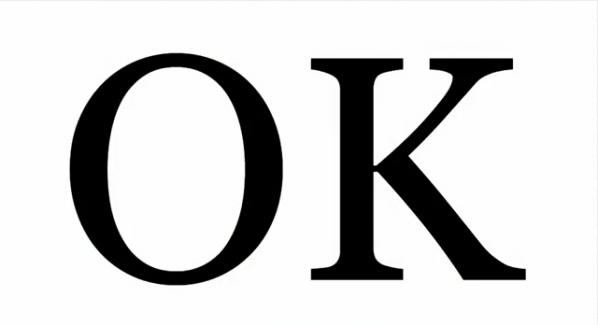
Another good example is “OK good stand clear”, based on “110%” by Laura Vane and the Vipertones. The original song is efficient, well-assembled funk/soul, complete with a punchy horn section and a sassy female lead vocal. It’s slick, sharp and professional, but hard-working rather than inspired. Szpakowski’s remix dispenses with almost everything except the rhythm section, which is slowed down slightly to give it more depth and a thumping creaky quality like an elephant in new walking-boots. To this he adds a sampled American voice saying “OK? Good” and “Stand clear of the closing doors!”, and a hammering piano-figure. Again the effect is to open the track out, to give it a more three-dimensional feel, and also to make it much less derivative, much less obviously the product of a particular genre.
In almost every instance Szpakowski’s remixes have a more resonant and spacious feel than the originals; the sounds are dirtier, fuzzier, more textured; and the rhythms are more complex. These changes may not always be entirely to his advantage. As he admits himself, “I don’t dance (or haven’t for twenty years or so), which actually makes a big difference in how one experiences popular music…” Certainly there is one track – a remix of “Paradisco” by Charlotte Gainsbourg and Beck – where Szpakowski’s version has a spiky, angular, echoey jazz feel, but loses out to the original in terms of finger-clicking compulsiveness. It’s true that his remix puts a stronger focus on Gainsbourg’s voice and lyrics than does the original; but whereas Gainsbourg and Beck’s version stays within the disco format and gives it an iconoclastic indie makeover, Szpakowski’s remix takes us beyond that format altogether, and comments on it from the outside.

In some of the tracks there is a move from the USA to Europe in terms of feel. One example is the remix of “What happens in Vegas” by Chuckie ft. Gregor Salto – a histrionic slab of USA club music. Szpakowki’s version (“Shit happens in Vegas”) has a distinctly Kraftwerk-esque, European-techno slant. Also, because the remixes are often crackly, fizzy and hissy, they tend to feel “older” than the originals. At times we seem to be listening to badly-tuned radios in the pre-digital era, or to vinyl LPs smothered in dirt and played through a fluff-laden needle. But this “distressed finish” effect is in keeping with a broader sense that Szpakowki’s remixing technique involves a kind of deconstruction or breaking-apart of the tracks on which he is working. They become less smooth and shiny, less self-contained. The original tracks are often tightly-focussed in terms of their musical styles, with a narrow range of subject-matter, and often with manipulative designs on the audience – wanting to make them feel like dancing, wanting to make them feel sexed-up, or trying to tug at their heart-strings (“Try to Stay Awake” by Frank Friend, “Trojans” by Atlas Genius and “Jigsaw” by Mimi Page are all relationship-based heartstring-tuggers). The remixes, on the other hand, aren’t looking for such straightforward reactions. Their subject-matter is less easy to pin down, and their ingredients bespeak a mixing-together of disparate materials, different cultures, and even different eras.
Non-musical ingredients are one noteworthy feature. In “OK good stand clear”, the voice saying “Stand clear of the closing doors!” comes, as Szpakowki explains, from “New York subway recorded announcements… grabbed, I think, from YouTube”. He is also fond of introducing a voice intoning random numbers – this occurs in several of the tracks. Usually the voice has a foreign accent, and sometimes the numbers are spoken in a foreign language. These number-sequences, says Szpakowski, come from “the so called ‘numbers stations’ which are believed to have been used by various intelligence agencies… they’re available at the internet archive“.
On “I’m getting a cat” the words come from mashed-up Tweets which have been run through a voice-to-text synthesiser. “I am that I am” borrows its vocal from the painter and sound poet Brion Gysin – a voice-sample which, until it begins to distort, sounds rather like a 1950s announcement on the BBC. “Speaking in Tongues” reverses the vocal on a hectoring soul track by Colonel Red called “Rain a Fall”, so that it ends up sounding as if it’s in some unspecified European or possibly Middle Eastern language. And “Sugar Plum Fairy on the Dancefloor” introduces the chiming melody from Tchaikovsky’s Sugar Plum Fairy into a rap called “Disco Technic” by Stan Smith, to surprisingly good effect. There is a genre-busting transgression of boundaries, a throwing-together of cultures, a jumbling-up of eras, and a deliberate use of incongruous material.
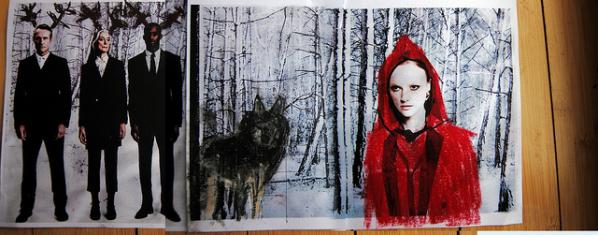
The videos Szpakowski has produced to accompany some of these tracks show similar traits. Again his admission that he doesn’t dance is relevant here, because the starting-point for many music videos – a very tight and emphatic synchronisation of visual effects with the beat of the track – is not a particularly dominant feature in his work. The one which succeeds best in this respect is the video for “OK good stand clear”, which projects text versions of the words onto the screen in big letters precisely as we hear them. There is also a lovely moment in the video for “I’m getting a cat” where, in a bit of old black-and-white footage, some youngsters sitting on chairs on a stage start to sway from side to side, apparently in time to the music.
But synchronisation to the beat isn’t Szpakowski’s priority. “I’m getting a cat” provides a good example of the kind of effect he achieves instead. The synthesised vocal for the track first announces that it’s getting a cat, then starts to ask absurd questions about cats and cat-care – “Does your cat try to style your hair?”; “What is your funniest and yet painful cat story?” – which are gradually infiltrated, first by other subject-matter – “Become a big brand on Facebook!” – then by symbols – “Poundsign poundsign poundsign” – and sequences of numbers. What starts off as funny, ironic and nostalgic develops or breaks down into a kind of digital fragmentation, and eventually into wordlessness. The end of the track is a wistful instrumental coda, embellished with piano and strings. And the video follows much the same path. It starts with old footage from the 1960s White House, in which President Lyndon B Johnson seems to be announcing his intention to get a cat to his slightly-bemused aides. Then there are some outtakes from what seems to be an instructional video in which a troubled youngster is being given helpful advice (presumably cat-care advice) by a reassuring and helpful older man. By the end of the track – the coda – we are watching teenagers playing music, drinking coffee and dancing. Again, humour and irony have been replaced by something more wistful and hard-to-define.
“Found” materials, often quite disparate materials spliced together by digital means, are just as important to the videos as they are to the remixes: they feature archive footage of the Whitehouse; shots of groovy teenagers from the Fifties or Sixties; Japanese Noh theatre; imagery based on Little Red Riding-Hood; square-dancing American kids; old claymation footage of teeth wearing boxing gloves; big black lettering; jumbles of coloured pixels; and images of Las Vegas captured from Google Maps, reconstituted into a long sun-baked backwards drive from the middle of town into the desert. Like the musical tracks they accompany, these videos cull their materials from many disparate places; they are full of little jolts of incongruity, slightly-bizarre juxtapositions; they lead us not only inwards towards the music but outwards towards different cultures and different eras; and they also call our attention to the digital medium itself, the Web on which all these materials are available, and the computer software which slices and splices them.

Perhaps most remix artists are more influenced by the work of their immediate peers than by art theory, art history, or inspiration drawn from other cultures. Not so with Szpakowski. As mentioned before, one of these remixes (“I am that I am”) uses a vocal track from Brion Gysin; and the words “OK good”, from “OK good stand clear”, are sampled from a recorded talk by William Burroughs. Burroughs and Gysin were the first proponents of cut-up and fold-up techniques in literature: Gysin was also an experimental painter and sound artist. This link with the two of them hints at a connection between Szpakowki’s remix style and modernist or post-modernist art. Remix culture itself is closely related to mash-ups, which in turn (whether remix artists are aware of it or not) can trace their ancestry not only to cut-ups and fold-ups but to the collages, bricolage, decalcomania and other mixed-media, mixed-genre experiments of the Modernists: experiments which reflected not only an urge on the part of Modernist artists to break free from received genres and formal conventions, but a feeling that the modern mind did not belong to a single era, a single unified body of belief or a single point of view – instead it contained many disparate perspectives, and ideas or images from many different eras and cultures, all thrown together into a jumble. For the modernists, this jumble was itself both one of the joys and one of the symptoms of modernity.
For modernist and post-modernist artists, formal perfection is often a secondary consideration, compared with the excitement of putting things together in new ways, seeing things from new angles. T S Eliot (in “Tradition and the Individual Talent”) described the mind of the artist as a “medium…in which special, or very varied, feelings are at liberty to enter into new combinations”. He made the same point in “The Metaphysical Poets”: the artist, he argues, “is constantly amalagamating disparate experience”; and modern art is bound to be more complicated than the art of earlier centuries, because modern life itself has become more complicated: “Our civilization comprehends great variety and complexity, and this variety and complexity… must produce various and complex results.” It was also argued, by various theorists, that modern artists found it increasingly difficult to belong wholeheartedly to a particular tradition, or to stick to a particular working method or lexicon of forms, because mass reproduction had made so many different traditions and examples, from so many different eras and cultures, available to them. If these observations were true at the beginning of the twentieth century, they are most certainly true now, at the beginning of the twenty-first, when life is characterised not just by “variety and complexity”, but by information-overload, and when the work of other artists, other eras and other traditions is available not only in museums, libraries, books and prints, but online at the click of a mouse or the blink of a Google query-screen. So one way of understanding Szpakowski’s remixes – his particular take on what a remix ought to be like – is to look at them in the light of modernist, post-modernist and digital-modernist aesthetics.
Another neo-modernist aspect of these remixes is their reluctance to woo the audience. There are moments when the arrangements are slightly unsympathetic to the listener. One example of this is “I’m getting a cat”, where the voice-over stops asking absurd questions about cat-care and starts coming out with fragmentary nonsense about Facebook, number-sequences, and “poundsign poundsign poundsign” instead. The “poundsign poundsign poundsign” sequence, in particular, goes on to a point where a lot of listeners might find themselves wishing it would stop. Similarly, on “I am that I am”, the voice-over, which starts with a sequence of variations on the theme of identity –
I AM THAT I AM
AM I THAT I AM
I THAT AM I AM
THAT I AM I AM
AM THAT I I AM
– soon gets speeded-up and distorted into an incomprehensible babble, and this babble is so loud and frenetic that it’s quite hard to hear the music. Again, some listeners may find themselves wishing that the voice-over would stop.
As already mentioned, the vocal track in “I am that I am” is based on an original piece by Brion Gysin, and Szpakowski has actually cut it down in order to re-use it – so although Szpakowski’s track may seem a little bit tough on the audience, it’s actually quite a bit less demanding than Gysin’s original. But the link with Gysin provides a clue to the aesthetics which are apparent throughout the whole “12 Remixes” project. “I am that I am”, as a text, is based on the idea of reordering a five-word line into all its possible variations, as can be seen from the extract above. As such, it has a mathematical quality. It resembles “ordinary” poetry in the same way that a peal of bells resembles “ordinary” music, and its structure and length are determined, not by any particular ideas about what may sound good to an audience, or what may provoke a certain emotional effect, but by the need to run through all the possible variations of a certain sequence in a certain order.
As a sound-poem the piece progresses in a similar way: Gysin takes his sequence of statements, and gradually adds echo to them and speeds them up until they become a frenzied babbling noise. In other words he performs a set of mechanical distortions on them, and increases or redoubles those distortions until they have reached a logical conclusion. Again, he is not particularly thinking about what will grip, entertain or move his audience: his attention is fixed on the materials, the medium and the process. This is not to say that “I am that I am” does not have any affect. It is delivered in the ringing tones of a self-important orator, and when the first layer of echo is added we imagine that the speaker might be addressing a rally in a great hall, like Citizen Kane, Mussolini or Hitler. But the self-assertion of the words is then turned into nonsense as the layers of distortion pile up. We feel firstly that great leaders and orators and being mocked, and then that identity itself is being called into question. But we also feel, as listeners, that these reactions may belong to us at least as much as to the piece itself: it has not been designed primarily with the purpose of producing them, and if we failed to experience them the piece would still have a purpose and meaning of its own beyond them, as a peal of bells has its own purpose and meaning whether we enjoy the sound of it or not.
This concern with sequence and process, with breaking things down into their constituent elements and then reorganising those elements according to mathematical rules, can again be related to the experiments of modernism – to the modernists’ determination to question and rearrange the materials and media from which works of art are made – but as the example of the peal of bells indicates, it can also be linked to much older forms of art; and at the same time it has a particular relevance for artists who are working with computers and code. Five words being reorganised into every possible sequence will produce a flicker of recognition in anyone who has every attempted code-poetry. It’s the kind of experiment which sits very naturally in the digital environment and the new media art genre.

Szpakowski’s remixes cannot be described as mathematical sequences or coded music, but they certainly do show evidence of a Gysin-like interest in variations and logical progressions. This may make them seem a bit unsympathetic in places, but it also gives them a certain air of toughness and detachment. As already mentioned, if they are compared with the original tracks on which they are based, one difference to emerge is that they don’t seem to have such obvious designs on their audience. But it’s also true that they don’t tend to follow such obvious paths in terms of musical development. If we look at “In Paradiscos”, for example, the original track has a very strong feeling of moving up a gear when it comes to the chorus, whereas Szpakowski’s remix doesn’t follow the same pattern. Another example is “the moon is inside the snow”, a remix of “Blindsided” by Luke Leighfield and Jose Vanders (which is itself a cover of an original track by Bon Iver). In Leighfield and Vanders’ version, there is a definite sense of drama and progression, as the female vocal is joined by piano and violin, and then by a male voice singing in harmony. By the end of the song, we feel that we have been taken on an emotional journey. It has a narrative arc. Szpakowski, on the other hand, dispenses with the male harmony altogether, and also with large sections of the song’s lyrics. He cuts up and rearranges snippets of the female vocal to create quite a different impression – more of a Haiku than a romantic poem – and he alternates the original vocal with a second female voice talking in Japanese. The end result is just as beautiful as the track on which it is based, but in a quite different way. It’s more austere and contemplative, less narrative and dramatic. It seems to be less about recounting a personal experience, and more about organising disparate elements into an aesthetically satisfying pattern.
Modernism, cut-up techniques, digital experimentation – perhaps these are big perspectives from which to view what is essentially a fairly modest project. Szpakowski didn’t set out on this series with any particularly grandiose ambitions: he set himself the task of producing one remix a month for a year because he thought it would be something interesting to do: it would build on his strengths as a musician and technophile, but it would also set him a series of new challenges. As it turns out, he has risen to those challenges to great effect and produced something really special – a collection which shows variety of tone and pace, wit and inventiveness, along with unity of design and a distinctive “voice”. Whether it’s a digital-modernist take on remix culture or not, anybody who is interested in experimental music could do a lot worse than put their headphones on and give it a try. It certainly repays close attention.
Sam Renseiw and Philip Sanderson’s Lumière & Son project is a near perfect and altogether exhilarating sequence of moving image lyric poetry (though lyric here does not exclude humour or the grotesque) and a demonstration of how seriality and fragment – an unfolding over time, the diaristic – has quietly become one of the fundamental modes brought stage centre by the network (so much more than the rather dull ‘interactive’ which has so quickly become the standby of the monetised digital). Impossible to watch one of these pieces without the desire to watch just one more.
The set (which lives online but has been shown offline in whole and part) and its component pieces, moreover, are studies in various interesting things: the liberating effects of constraint and collaboration and what those both demand and imply; also of randomness, or perhaps better, the loose, the dashed off, differing degrees of accuracy in such collaboration (also the apparently dashed off, the apparently loose [also the apparently synchronised or ordered]).
To start with, a little history. In 2007 two young members of the digerati, Andreas Haugstrup Pedersen and Brittany Shoot, invented a form and threw down a gauntlet. The form, in fairness, was not exactly new – over 100 years old, actually – but its re-contextualisation within the digital realm and more particularly on the network was, without exaggeration, a stroke of genius[1]. It involved taking precisely the constraints affecting the films of the cinema pioneers, the Lumière brothers, and applying these to contemporary online video work. Films or videos of exactly one minute, fixed camera, no sound, no zoom, no edits. Such videos dubbed, naturally, ‘Lumières’. There was clear recent precedent in the constraints of the Dogme movement of Von Trier and others but the project also drew on the various little-bit-art-little-bit-geek, young, playful cultures which abutted and intersected the more formal area which we called, for a while, ‘net-art’, and which thrived on a sparky and often competitive and showy overcoming of the early net’s limitations of file size and bandwidth – projects like 5k.org, 10secondfilm.com spring to mind.
Additionally, because the start of modernism still does not really seem all that far away, early film was a natural reference point for many wrangling the early internet as art tool and channel both.
We responded viscerally to the sheer, almost willed-into-being, expressivity of the ad hoc devices and solutions of early film and this fitted snugly with the bodges we ourselves were employing. It gave us confidence, too, that our ducking and diving too could be expressive but also it confirmed a certain tendency to lo-fi-ness there in the zeitgeist. (I speculate – a lo-fi-ness which helped to define and declare art – useless, beautiful and human – as against the slickness of corporate design, communication and advertising… This has persisted remarkably – note the thriving on-going cult of the animated gif)
That was the form. The challenge – make some. Embrace that 100+ year old limitation and do something engaging with it. Push the form as far as it will go.
Pedersen and Shoot set up a web site where all contributions would be aggregated and indexed (in retrospect, somewhat unfortunately, by links rather than copies held on their server – much work of historical significance has already vanished. Shoot and Pedersen themselves have moved on and the site has a Marie Celeste feel). In addition to the site itself, there was a Lumière manifesto which, personally, I found a little narrowly focussed. Shoot and Pedersen seemed to invoke a near ethical dimension to the return to first principles and in their own moving image practice confined themselves to work (much of it very good) entirely within this discipline. It was clear from the huge response of other artists and film-makers though that the form clearly answered a diverse set of pressing needs. For some it was a cleansing activity, for some a sketchbook, for others a spur to invention and for others still, a challenge in the sense of “How can I observe the spirit of the rules whilst actually driving a coach and horses through them?”
Although the Lumière made next to no impression on the ‘official’ world of art video (one speculates – cynically, perhaps – too democratic and available to anyone with a cheap camera, too ontologically opposed to the expensive grandeur of high concept, too hands-dirty in a world where artists aspire to hire videographers and editors to realise their art; in short, too lacking in the conspicuous consumption that validates much contemporary work), it was enthusiastically taken up by a mixed bag of videobloggers and artists excited by the idea of video specifically made for the net.
An immediate adopter and one of the most enthusiastic and prolific makers of Lumières was the Danish architect, educator and thinker, Thomas Wiesner, who operates in online video as Sam Renseiw and maintains a quirky and engaging site called Spacetwo: Patalab. Renseiw (as he prefers to be known in a video context) is a maker of numerous very singular small video works, which evince his keen interest in space and movement within spaces. (He teaches not only architecture but also a course for dancers involving approaches to conceptualising movement in space). I’m not sure Renseiw completely understands how original his work is. It is characterised by a joy in careful, quizzical looking (and a spontaneity in finding or being gifted subjects for such looking, assisted enormously by the continual development of more portable and discreet video cameras). It is, in terms of the formal art world deeply unfashionable. Personal and diaristic, it eschews the grand concept and extravagant and expensive execution and is all the better for this.
Renseiw has a profound sensitivity to space and to how people and objects move along variously restricted and open trajectories but he is mindful too of what the ‘actors’ in these found scenarios, set out to do and in fact achieve as human beings. The gap between aim and reality provides fertile ground for Renseiw’s dry and humane sense of humour, which is never far distant.
Significantly his prolific Lumière making (337 at the time of writing) sits side by side with longer (though still lapidary) works with music, editing and the other things the Lumière eschews.
Renseiw’s Lumières are characterised by a number of quite distinctive things. Something that unites them all is a quite extraordinarily heightened sensitivity to both colour and composition, which formal feature hits us forcefully in the moments even before we begin to decode any content or action. Formally striking too is the way in which a number of the pieces are composed so to as to allow for action in the near, middle and far distance, sometimes in different sectors of the frame, sometimes simultaneously in a kind of layered visual counterpoint and sometimes spread out temporally. My imputed intentionality here is somewhat problematic, though Renseiw confirmed to me that he shoots much more material than he uses and that he will select a particular minutes worth of material from longer sequences so on two counts there is a rudimentary (though nominally forbidden) editing process occurring. A quick comparison with Lumières by other film-makers will however confirm that Rensiew’s singular vision distinguishes each of his pieces from the off.
Other signatures are extremely low, oblique or occluded camera positions, into the fields of which parts of human bodies mysteriously intrude. This sounds clinical. Curiously it is the opposite. Redeeming it is a genial humour which allows the part to stand for the whole – we perforce imagine the entire human being whilst smiling at the V-effekt with which we are presented – for example a pas de deux for a pair of woman’s black leather boots (on the ends of beyond-the- frame legs) and the four paws of a black dog – randomness, clumsiness, near misses, narrow escapes and – we just know because we are human – purposeful activity. Human life, in short.
Another defining stamp is a musician’s sensitivity to rhythm and tempo – rhythm as manifested both as near metronomic regularity – someone’s gait, traffic flow, a hammer, for example, with either disruptions – slowings down, speedings up, pauses, stutterings – to that regular pattern, or polyrhythms created by other simultaneous independent near regularities and variations therefrom.
There are three loose categories into which Renseiw’s Lumière work could be said to fall (of course they’re by no means entirely mutually exclusive) – we’ll call them the loop-able, the documentary and the performative. The loop-ables are kin to the still photograph, are often of natural phenomena or repetitive but irregular human engendered activity where one could imagine the minute’s imaging infinitely, hypnotically extended – the flashing light patterns in Belisha Code for example. The documentary tag applies where the topic itself might be assumed to have some independent interest, for example the workers transporting away in a sling Copenhagen’s Little Mermaid for a trip to Shanghai’s 2010 expo in Speaking Voice or Michelle Obama’s motorcade in Rite of Passage. In what I’ve called the performative, richest of all in my view, an amazing amount of stuff happens. And everyday stuff happening and rendered vital by keen eye, framing and selection rather than something we might have known to look out for, is key. The differently distanced layers referred to earlier partition the frame physically or the piece temporally and unexpected things happen against and within them. We participate in these dynamically as viewers – we view this strange jigsaw world and complete it mentally; sketch a world beyond which is not simply our lived world but that world somehow leavened with Renseiw’s odd and warm sensibility.
I’ve written pretty glowingly about these Lumières – constrained, silent but surprisingly un-austere and you could well think that to add sound, music or both and several layers of these to boot might be over-egging it all somewhat. So one would think, but I have complimentary things yet to say about skill, tact, panache, flair and sensitivity and they are heading the way of Philip Sanderson, Renseiw’s musical/sound collaborator in the extended Lumière and Son project.
Renseiw’s Lumières are, I hope I’ve established, rich, dense, multi-layered but remarkably uncluttered works. A number of these pieces approach as closely as possibly the condition of music whilst remaining wholly without sound. It might seem superfluous or an act of hubris to add sound to them, the consequence of which could be to render leaden, stiff and fixed what is light, playful, complex and turns on a sixpence.
With the exception of a couple of near misses Philip Sanderson’s sound and music additions triumphantly avoid this trap and indeed deepen those rich and quicksilver qualities.
It’s important to note that what Sanderson contributes is all found or appropriated material – it’s possible he’s added original material in, I don’t know, but it’s not a significant chunk if he has – he certainly reworks much of it intensively, usually in the form of a mix of several layers of sound, some musical, some textual. (And we should note that Sanderson’s wit and deftness is literary as well as musical).
The deployment of sound gains enormously from Sanderson’s huge and eclectic range of knowledge, reference and enthusiasms. There’s a cooking metaphor in here – mixing the ingredients, finding just the right, perhaps almost imperceptibly present flavourings, knowing the qualities of things and how to combine them well…
Elsewhere I have asserted that the key feature of the most successful short form video work is a combination of intense poetic compression with a huge range of suggestion. I called this opening-out – a universe from a speck of dust. An ability to evoke the range of connectedness of many disparate things by well-chosen images, sounds, texts, whatever can pertain to moving image. Certainly Renseiw’s work has this in spades. Sanderson’s sound opens-out the movies still further. It adds, almost literally, an extra dimension, as if enabling new angles of view. It provides paths, bridges, vistas, tunnels, maps, balloons, telescopes, and sonar.
The guiding methodological principle seems to be a species of metonymy and one moreover which suggests an, in practice entirely non-existent, explanatory or illustrative dimension. The flashing beacons in Belisha Code are accompanied by a recording of a numbers station where one’s immediate impulse is to construct entirely absent meaning in the correspondence of the binary on-off of the four beacons and the German numbers from zero to nine heard on the soundtrack. Let’s be clear that this is not a criticism – a rigorous correspondence would be leaden – closed-in – but what we do have is a rich package of suggestion and affect. The correspondence that does exist is formal and temporal, between the flashes of the beacons and the articulation of the words and where the same sort of rickety polyrhythms that we’ve observed within the original Lumières themselves ensue.
Although comparison of some of Sanderson’s sources with their use in the pieces evidences, on occasion, some quite detailed cutting, mending and buffing-up there is an inescapable sense in his deployment of sound of the somewhat aristocratic tradition of the modestly dashed off. It’s partly his clearly extensive knowledge of his sources and his evident skill with a huge variety of genres but it’s also to do with a certain ambiguity in how the sounds are placed – not four square upon, but athwart the images, the sound often only fading or vanishing well after we’re into Renseiw’s end titles. Sometimes the sound is clearly not cut to shape in the way one might at first expect – an introduction, for example proper only to the original sound itself and not to any clear visual motivation might be left standing. The imperfections, noise, oddities and glitches contained within each block of appropriated sound intensify this sense of informality as does the slightly culinary air referred to previously. On the other hand, often enough to matter, the sound directly lines up in a spine tingling way with a particular action. It’s a master class in expressive ambiguity.
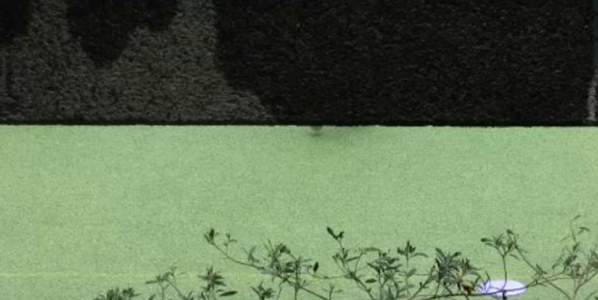
Renseiw – physical poetry, the occlusion, constraint. The careful choice of footage (variety and kind of motion within a narrowish range). Humanism: we don’t see faces, we don’t hear voices, we are amused but we recognise ourselves, youth and age &c.
Sanderson: The music found but could have been composed. The artfulness of placing it just thus. We will never know whether the way it ends with the action, the running off, taking place just after the repose of the final minor chord was deliberated or found. For me this placement implies a universe beyond the letterbox. It has a commonality with the treatment of time in many photographs and paintings – this is an instant, a fragment, but there was a before and an after.
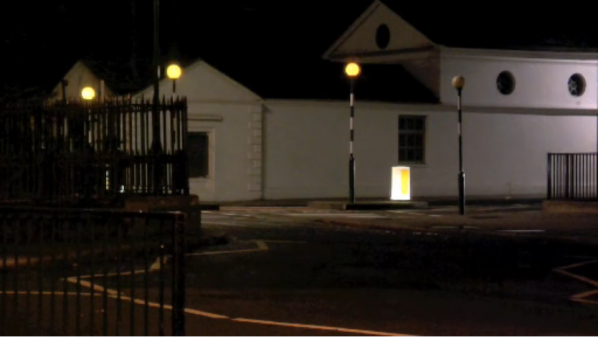
Note that there are four beacons. The sound (a numbers station, one can almost track the archaeology of impulse!) draws on the numbers 0-9, in German. It’s worth noting there is no obvious mathematical mapping between the pattern of the beacons and the numbers but the character in sound of the numbers is close to that of the beacons in light. Suggestion, metonymy.
This forces our attention very strongly on that area of the screen, with the concomitant effect that when we force our attention away it is as if our eyes have been suddenly opened. There is a world out there.
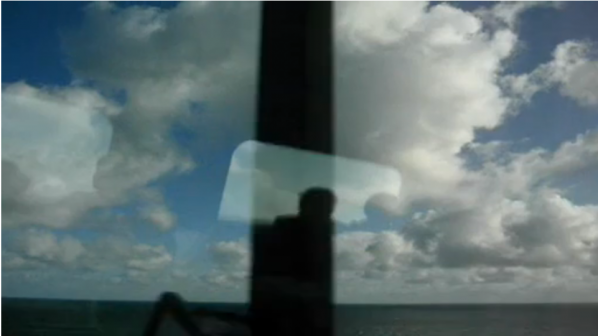
There is a hint of the transcendent in the title – how is this realized? Unless we know Denmark it takes a few moments to realize we are on a train rather than a boat or plane – we are clued into this by the close objects we clearly pass at speed and the reflection of passengers and seating in the windows. One speculates that the sound track is comprised of two elements – one the rhythmic and metallic pulse which somehow rhymes with the passing object (a kind of pseudo-diegesis) and the second an (Open University?) lecture on relativity.
Here, not exactly metonymy but something more fragile, delicate chains of suggestion and subtle resonance. No argument (to see an argument in any of this would be to commit a category error) but a complex and suggestive …um…thing. One should also note that this piece (in both its silent and extended versions) is extremely beautiful.
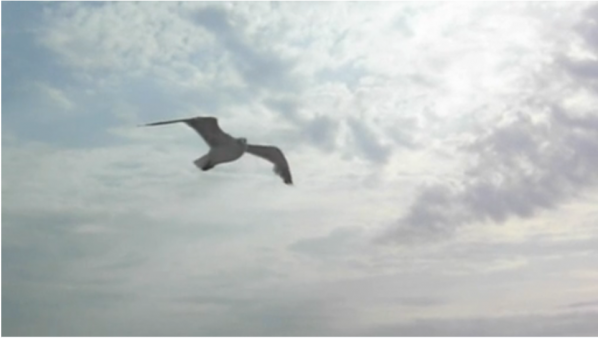
Let’s talk about the sensibility and taste of the makers. Renseiw offers something simple, a kind of tour de force – we perceive it as such although given the fixed camera constraint any virtuosity belongs to the seagull.
A banal seasoning of music would involve simply the seven note modal motif which hails, I’m almost certain, from American popular song of the 70s big country type – Wichita Linesman, you know the sort of thing. (I checked with Sanderson –it’s Bobby Goldsboro’s Summer The First Time) By itself it would be too perfect, too parallel to the floating bird (it seems to give way to a crashing wave sound in its looped form; interestingly the Goldsboro video I found on YouTube begins with a shot of gliding seagulls). With too much parallelism nothing extra arises but Sanderson spices the mixture by the addition of dialogue from what sounds like an American film of the forties or early fifties. It disrupts the idyll but only so as to make us more aware of it. There is a kind of musical V-effekt here (which could have been so badly handled and so isn’t). This is its ‘meaning’ – these things! Here, now!
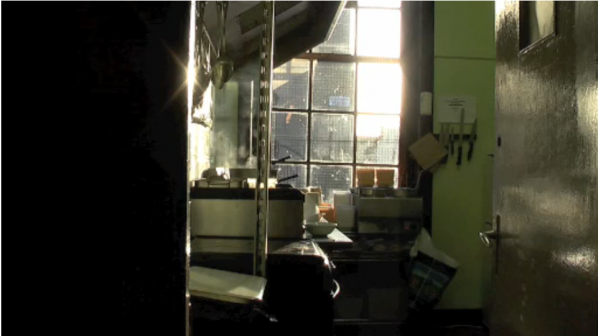
There is something of the dance about this. The music beautifully picks up both the nervous, sudden gestures of the cook but also suggests the process of cooking itself. The music has a funk component. One might say that it cooks.
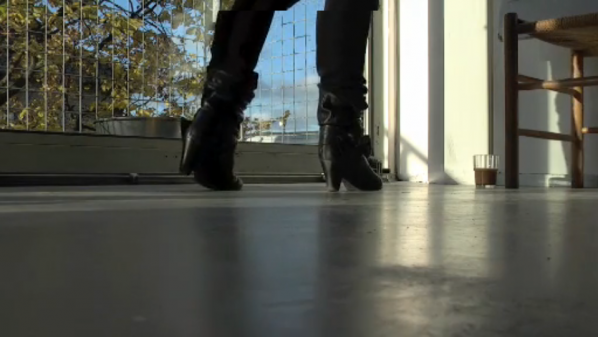
Visually – the low angle, the fragmented view of the body, the person here and not here. The focus on that person which permits and invites its opposite, in particular the framing of the sky and trees. The rhyme between the black-booted two legs of the woman and the black four legs of the dog. Their pas de deux. The music here subordinate, properly so. Ambient sounds, on the one hand, with odd vocal snatches on top. The strangeness doesn’t demand our attention because we are so focused on the visual.

Until the last moments we simply hear a fitting (slightly arch) accompaniment to the skating – we surmise that it is intended to pastiche the kind of accompaniments used in professional skating. At the last moment we realize this is exactly what it is, as the commentator’s voice breaks through. There is also a ‘skate’, ‘friction’ or ‘traveling’ noise which exactly underpins the final move we see, just before the humour of the juxtaposed text, which continues after the movie has gone to black, strikes us: “Delightful, skating of the highest quality” delivered in classic plummy BBC tones…

A hugely rich piece: visually there are a number of layers – the far left street background where distant people and vehicles process. The game of Petanque: – the actual participants (although glimpsed corporeally only twice: fleetingly at the very end and as one set of typical Renseiw-y legs) and the balls themselves (and the metonymic link between these and the planets). Thirdly, the large shadows. (And the apparent size of each of these layers allows for very clear visual interaction). Sound – the ‘light’, jokey, playful music. The University Challenge soundtrack, here unusually clearly cut up – questions – astronomy; replies – painters. A risk for Sanderson, but one that works.

A little detective work indicates the level of detailed truffling about by Sanderson – part of the sound, the text, is grabbed from a YouTube video about French patisseries in London and cut up considerably – in particularly yielding the repeated incantation “cream cakes, tarts, macarons” the latter word in a considerably overheated French accent following the sloaney first three, to deeply comic effect. Comic maybe but, repeated, as in a dream; this mood is reinforced by a rather beautiful waltz time solo piano loop of the opening line of The Associates’ Party Fears Too. Here’s another piece where the visuals, here also dreamy and wistful, set in a looking glass Copenhagen (and the disjuncture between the London-location heavy narrative and the visuals is simply ignored, taken for granted, part of the deal), support quite a complex sound assemblage. Utterly haunting and quite difficult to say exactly why.
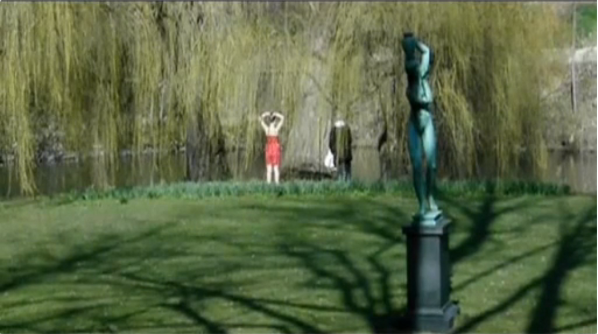
If one didn’t know it wasn’t one would surely assume this was carefully planned, and our knowledge it was not adds to our pleasure in it. Visually the rhyme between the woman and the near foreground statue is perfect – at one point she seems to mirror it exactly. Maybe she knows the area well and there is some unconscious mental echoing…we’ll never know. The other sharp visual pleasure is the smallness of the area of focussed distant activity, which again feels like a sort of directorial chutzpah, except, except…
Sanderson’s contribution is razor-sharp – the pseudo dialogue hits the mark precisely but doesn’t outstay it’s welcome – or at least there’s other stuff going on to detain us, not least the way the model’s preliminary warm-up shimmy becomes a perfect piece of minimal dance when set against the music.
Right of Passage/Speaking Voice
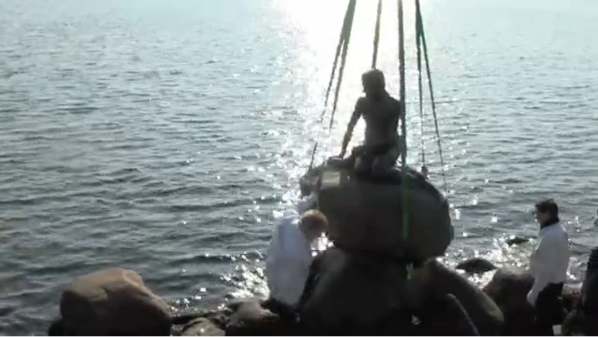
I wonder if when the content has it’s own ‘documentary’ interest, when the filming becomes a case of “Look at this remarkable thing not because of its intrinsic interest but because it happened”, the final result is somehow less engaging?
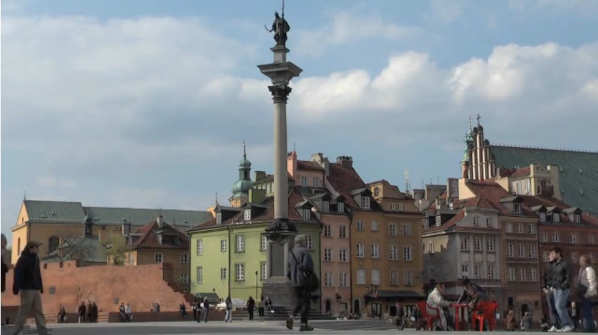
Again a dance related piece – the regular beat of the calling of the numbers one to eight sets up an aural grid against with which the implicit rhythms of the movement in, out and across frame interact in a sophisticated but subtle polyrhythm. Part two of the sound, with actual step instructions, ups the tension and the effect (especially the late entering ‘spinning’ man). Note how often in these pieces the sound fades out slightly later than the visuals, over Renseiw’s titles, thus emphasising its separate existence in an independent channel or dimension.
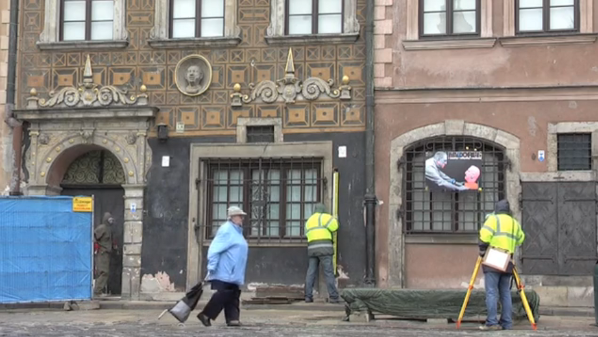
Beautiful found synthesis. Funny. Funny and truthful and touching.
The moving image is packed with incident at both different spatial levels and at different points in the piece. The Portsmouth Sinfonia version of Dance of the Sugar Plum Fairy underpins like a grid, as with Square Dance but in a more complex way, the visual rhythms of the film. Enough coincidence of rhythm to feel planned, enough ‘pull outwards’ to feel open… Again humour… Why does the Portsmouth Sinfonia track, in particular, work so well – atmosphere? the conjuring of a sort of raggedy clockwork ? – can we imagine in its place a more conventional rendering of the Tchaikovsky? Yes, but…
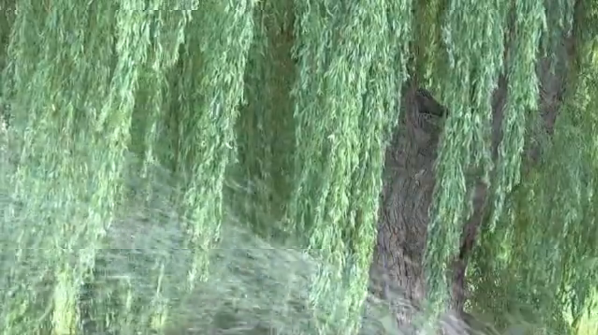
Prime example of Sanderson mind set – metonymy, suggestion – the trees are hair, the water appears exactly on cue (worked? Hmm – the audio appears to be cut to make the word ‘rinsing’ and the water jet coincide)
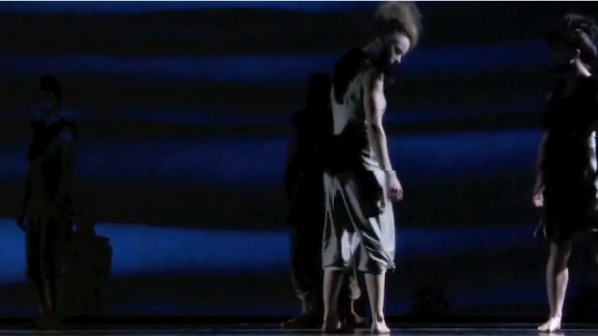
A one liner, but, given its place in the sequence, none the worse for it.
Brass band/Dancers.
*The pieces loosely divide into ones where either sound or vision predominate and some where they have equal roles.
* Not only does dance appear a couple of times explicitly as a subject but the spirit of dance pervades the project.
*The question of the success of individual pieces and of the sequence – a piece that seems less effective in isolation can well form an effective point of relaxation or reflection in the sequence as a whole…
*There are three pieces which, if one ‘re-removed’ the sound, would not strictly be Lumières – Check Out Art Fairs (speeded up), A Beauty Overblown (slowed down) & Sucked In (reversed). Sanderson performed the first two operations for reasons he felt the sound he used demanded. (To which one can only say: yes, this is right, a constraint is there for the sake of art, not art to be constrained.) Sucked In remains a mystery.
*The titles matter (note the re-titling of the composite works). They provide yet another dimension and illumination too.
*The prevailing tone is light, warm and playful. The darker side of life is largely absent, at least explicitly (though there are trails we could pick up to find it). Humour is everywhere. Only a philistine or fool would judge the work as a consequence to be less ambitious, significant or universal.
There’s a splendid exhibition currently on at Manchester’s Cornerhouse. Entitled Subversion, it presents a selection of artworks, a good number of which are moving image pieces, from various artists who are united by a strong connection to the Arabic speaking world. We’re already in loaded territory, for all sorts of obvious reasons. Those reasons could give rise to a long discussion which I’m not going to approach directly here, instead simply quoting a programmatic statement from Glaswegian Egyptian-Turkish writer Omar Kholeif, the show’s curator:
‘Like many of the artists I was looking at, I felt that collectively curators and writers associated with the politically unstable Arab world were being asked to step up and perform to an identity that the world wanted us to play. With Subversion my aim was to do just the opposite. I worked with artists who referenced this very language but who wanted to dissent, poke fun, critique and re-define themselves as artists of the imagination, and not of any specific social or political condition.’
And, in case you’re wondering, he succeeds richly in this aim and, I think, more.
If you can get to Manchester with at least a couple of hours to spare before 5th June your life will be enriched thereby.
I’ve already written a short piece on the show, with a couple of video clips, on DVblog and I’ll be writing a longer review, including consideration of some of the thornier question alluded to above, for MIRAJ 4, out in June 2013.
What I’d like to do here is to look in some detail at one particular piece from the show, a short video by Khaled Hafez. I don’t mean to suggest that it is somehow best in show although I do love it – the show is too diverse for that kind of simple-mindedness. I do think a careful examination of it will yield support for Kholeif’s position. What we have here is a complex work of art, which bears repeated viewing, which doesn’t bend or break but thrives under that hard scrutiny and which, although inevitably stamped with the experiences, background, the moment in time, the physical location of its creator – what isn’t! – is universal (Problematic term! Of course we can’t know what 100 years will make of it but we can assert its current universality and adduce evidence that it is a work which promises to be of some long-term interest too.)
Hafez is probably better known as a painter of striking mash-ups of ancient Egyptian gods, comic book heroes, bodybuilders and models set against richly textured, feverishly beautiful and largely non-perspectival landscapes of the imagination. His paintings are characterised not only by this content (and of course what we lose in a run down of content is the aftermath of the act of painting, facture’s narrative, the play of line, geometry and colour. I’ve seen none of his pieces ‘in the paint’ but I’d bet money they’re good enough to eat.)
Furthermore, series, numbers, line-ups, multiples and queues of those Gods, comic book figures, bodybuilders and hybrids thereof seem to be important to him (and I don’t think I’m wrong in perceiving an echo of hieroglyphs and their implied grid and of pre-Arabic Egyptian art too).
There’s a strong sense of directionality and of motion arising from these lines and groupings and even if one knew none of the background it wouldn’t be surprising to learn of Hafez’s deep interest in moving image.
OK – to the piece itself. Let’s stay zoomed-out for a while and point out first that it was made in 2009, two years prior to the revolution which brought down Hosni Mubarak, exemplifying the ‘storm petrel’ effect whereby artists, who can often be infuriatingly ditzy as politicos, nonetheless, in virtue of their trade – their looking, their seeing, their empathy, empathy often of a strangely disinterested variety except for the can-I-make-art-from-it question, which question perhaps even makes their antennae the sharper, their sensitivity to society’s emotional weather, their readiness to make apparently random or intuitive connections – can be uncannily prescient about impending social change. Artists often ‘get it’ before the key actors begin to have the confidence to move.
So, you need to know that the piece contains so much reference to social conflict that, at first sight, to the outsider at least, it could have been made in the last year.
We start in darkness. Titles: “Anubis productions presents”. A number of soundtracks sewn together in a kind of faux short wave radio polyphony which resolves to a solo piano playing something doomily romantic which I don’t recognise (on subsequent listening it appears to be of a piece with the up-tempo stuff that follows, so I assume it’s especially composed). Over this we hear an extract from the resignation speech given by General Gamal Abdel Nasser in the immediate aftermath of the defeat in the six day war against Israel in June 1967. (He resigned for a day, coming back to office surfing a wave of popular support and grief and then ruling until his death in 1970).
I presume that to quote Nasser is a potent gesture in Egypt. I assume, despite any criticisms anyone might make of him he carries a ‘father of the nation’ type weight and that an allegorical comparison between him and Mubarak would come naturally – here is a flawed but somehow heroic figure, indubitably at the least a genuine anti-imperialist – offering his resignation, but, now, in stark contrast, his pale epigone, his inheritor as dictator but not as hero, clings grimly on by force and brutality and mired in sleaze.
The audio continues and we see more titles:
“The A77A Project (On Presidents and Superheroes)”
Hmm – presidents. In the plural.
Also: you don’t strictly need to know this, but it was gleefully explained to me by the artist that A77A is Egyptian blogger ‘slang’ in that it represents Arabic characters difficult to transliterate directly to Roman for the Arabic word for ‘Fuck’. Of which more soon.
The next thing we see is a detail of the lower centre of a painting by Hafez from the previous year, “Outside Temples”. We focus in on three figures seen in profile. They are almost identical except that whereas the two outer ones have the jackal heads of Anubis the central one wears… a Batman mask. They stand in profile, in body builder pose, right arms raised above and in front of the head forming a sinuous S curve to mirroring left arms behind the lower back.
We zoom into these figures as music changes to a metronomically regular disco drum and cymbal rhythm and the two rightmost figures ‘detach’ themselves from their background and walk forward out of frame to the right.
This detaching happens five times – series in time as well as space.
Three sets only of the figures then parade past us with the arms that had been set in the raised arm pose pumping up and down (crudely animated by pivoting at the shoulder, a similar device setting the legs in motion) in what I surmise is an offensive gesture. It is certainly charged with a raw and vulgar vigour. At this point the figures march against a plain white field – slowing the piece down reveals stray blocks of pixels generated in the animation process. This lack of polish, the retention of rougher edges, feels like a Brechtian distancing. It certainly helped to sharpen my attention as well as endowing the piece with a kind of elephantine grace.
We move to a landscape, I’m guessing a poorer or outlying area of Cairo, with a building site before us. Two of the figures continue their rightwards motion across the frame. They loom large against the background and even allowing for distance, dwarf the human figures behind them. Interestingly the background imagery appears to have been shot from a vehicle moving across the frame to the left, which further cranks up the energy level.
We cut to a 3D software generated mannequin walking in the same direction in a similar landscape. The two painted figures catch up and merge with it – by the somewhat clunky use of a split screen – giving birth to a single Anubis headed mannequin who is our protagonist for the rest of the piece.
The figure continues into a landscape dominated by a still of the Sphinx of Giza, ( Abū al Hūl, in Arabic, translating into English as The Terrifying One) which, in a move straight from Terry Gilliam, picks up the next words of the Nasser speech, ‘mouthing’ with a detached and hinged lower jaw . In the background, the ‘sky’ – in fact simply the background where the image has been cut out in Photoshop – cycles through various colours from a fierce red through multiple greys to black. As you might have surmised realism is not the key term here… except…except …there is a kind of higher realism going on… A pastiche of the stuttering effect so overused in popular music in the early days of sampling is applied to the ends of words in the speech – and here, in Nasser’s Arabic translated as ‘I decided to step down’, the bloggers’ A77A appears, repeated and repeated, a splendidly childish and satisfying equivalent to shouting ‘Fuck! Fuck! Fuck! Fuck! Fuck! Fuck! Fuck! Fuck!’
From now to the end every background image is a still and our Anubis – visitor from another realm, mostly an observer, bemused God in a world gone insane, who intervenes only once and then as a kind of trickster, stepping backwards to change a banner in English reading “Presidential Elections” to “Presidential Erections” ( and then the Arabic banner too – Hafez told me that, strangely, a small change will accomplish precsely the same transformation in both languages) but who pauses politely to allow a photographer to snap five women with cheesy shutter noise and all – processes inexorably rightwards through a number of frames of varying character: some, surreal collage: a man on a bike with a wheelbarrow on his head; some whose strangeness arises from a sophisticated deployment of the warped perspective arising from the lo-fi animation technique – another man-on-bike whose movement at an apparent 70 degrees ‘through’ the frame emphatically underlines the constructed nature of what we are watching followed by a subtle but delicious section where the background image is smaller than full frame size and Anubis steps decorously up into and then down out of it; some, more serious – confrontations between demonstrators and riot police, with the arm-pivot device once again deployed to enable a middle aged women make our putative vulgar gesture repeatedly to the cops.
Anubis finally vanishes into what I take to be a polling booth.
This is such a rich work. It is both enormously local and particular and at the same time hugely general. It is full of ‘content’ but at the same time driven by smart, knowing and dextrously deployed formal devices, which reside not in the background but near to the surface and greatly add to the pleasures of the piece, which presents weighty and serious matters, but does so with great geniality, a geniality and humanity I for one wish to firmly identify with the awakening oppressed as they genially, but definitively and unsentimentally, sweep aside and settle accounts with their former oppressors.
—–
This review is a collaboration between Furtherfield and DVBlog.
Watch the film on the DVBlog website

Contact: info@furtherfield.org
DOWNLOAD FULL PRESS RELEASE HERE
See images from the opening of Invisible Forces on Flickr.
Scroll down for the video of the exhibition.
An exhibition about why contemporary life is so difficult for so many
Invisible Forces features the work of artist-visionaries: Kimathi Donkor, Laura Oldfield Ford, IOCOSE, Dave Miller, Edward Picot, and YoHa with additional game events, talks and workshops with Class Wargames, The Hexists, Olga P Massanet and Thomas Cade Aston.
Our social, economic and cultural institutions are being dismantled. Control over the provision of social care, urban and rural development, and education is being ceded to the market facilitated by unseen technological and bureaucratic systems.
Undeterred, the artists in this exhibition meet the challenges that ensue with clear eyes, spontaneity, experimentation and a sense of adventure. This selection of installations, digital video, net art, painting and drawings deal with conspiracy, money, politics and hidden signals.
As part of Invisible Airs, YoHa (Graham Harwood & Matsuko Yokokoji) attempted to read 20,000 comma separated lines of Bristol City Council’s apparently open-data. After which they understood that power reveals itself through multiple layers of boredom. They constructed four pneumatic contraptions which reveal the relations contained within the fields and the people affected. A video made by Alistair Oldham documents their art project Invisible Airs, Database, Expenditure & Power. Invisible Airs was commissioned by The University of the West of England’s Digital Cultures Research Centre (DCRC) in collaboration with the Bristol City Council’s B Open data project.

This is shown alongside Data Entry, a video that investigates how databases operate on us and through us by looking at the work of midwives and women in labour. “Databases move through us, allowing new forms of power to emerge… [they] order, compare, sort and create new views of the information they contain. New perspectives amplify, speed-up and restructure particular forms of power as they supersede others.”
Edward Picot is an artist and writer who also works as an administrator in the UK health service. His seriously funny soap-gone-wrong, Dr Hairy In…, chronicles the trials, tribulations and cogitations of an ordinary (but slightly hirsute) general practitioner – with hilarious results!* Dr Hairy’s struggles with NHS bureaucracy are brought to life in a series of satirical video shorts, featuring puppetry performances given by a child’s doll and screened in a doctor’s waiting room, as an installation. “It was like watching Team America set in the NHS” says Ian Hislop (broadcaster, editor of Private Eye and NHS patient).
Kimathi Donkor‘s Toussaint Louverture at Bedourete is a history painting made with oils on canvas that depicts an icon of anti-slavery struggles who, in his lifetime, was smeared as a reprehensible war lord. Created to mark 200 years since the independence of Haiti, the image shows the leader of the Haitian 1791-1804 revolution in a pose reminiscent of the Jacques Louis David’s Napoleon Crossing the Alps, surrounded by inspired revolutionaries in a battle that led to the creation of Haiti as the first slave free nation in history. In a short film by Ilze Black, Dr Richard Barbrook and Fabian Tompsett of Class Wargames interview Donkor about the work.
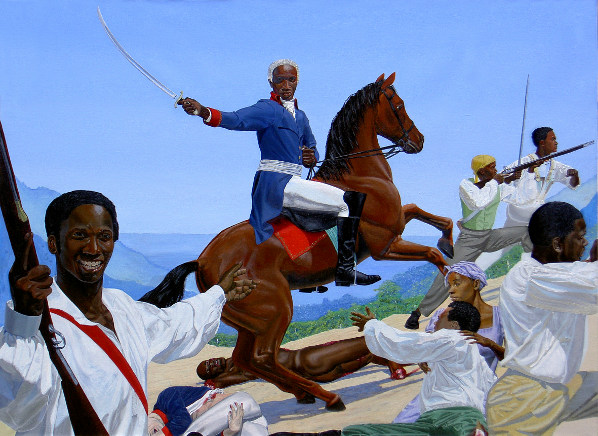
Laura Oldfield Ford‘s recent drawings are the result of walks (or ‘Drifts) through deserted urban spaces in the part of East London being prepared for the 2012 Games. They depict layers of failed utopias of the past and present and imagined futures. Known for her poetic and politically tuned ink drawings produced in print and online in her zine Savage Messiah, Oldfield Ford documents her psychogeographic explorations, in text and image, of the city as a site of social conflict, melancholy and political resistance.

Net artist Dave Miller presents two agitprop posters and a pamphlet of images reproduced from his interactive, multi-layered, online narrative bankers_bonuses. Miller worked with software he created himself to combine hand drawn illustrations with images gathered from Internet searches, and provocative (sometimes preposterous) statements made by powerful people about the ethical questions arising from the economic crisis.
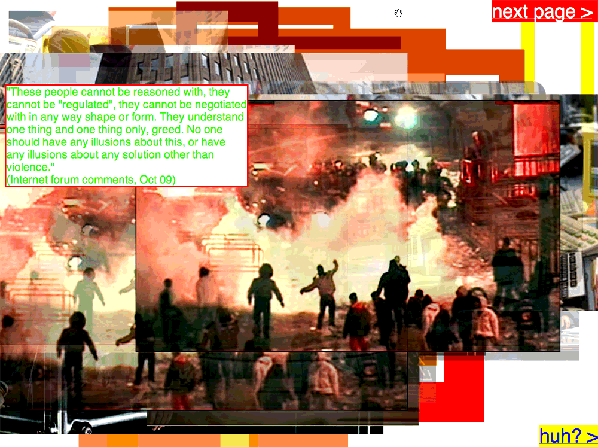
Italian artist group IOCOSE has created A Crowded Apocalypse, a net art project that exploits crowd sourcing tools in order to simulate a global conspiracy. The “crowd” assembles its own conspiracy and then protests against its protagonists and effects. A Crowded Apocalypse is commissioned by AND Festival and Furtherfield.
As we scan our cultures for maps, role-models, possible ways of living in today’s world, we often encounter images of society that are created by its hidden, controlling forces. By naming, revealing, tracking, playing, making, subverting and transforming tools, circumstances and figures that give rise to current crises we enlarge the debate and extend our freedoms. And the artists in this exhibition offer examples of just some of the ways in which this might be done.
* Important note. Dr Hairy In… is NOT a critique of socialised medicine and so we include a disclaimer: “The creators of this piece would like to point out that they all work in the National Health Service and are completely devoted to it.”
Free public play, games, making and discussion run alongside the exhibition.
Led by Dave Miller, The Hexists, Class Wargames, Olga P Massanet and Thomas Cade Aston. See HERE for details.
Rachel Baker (The Hexists)
Rachel Baker is a network artist who collaborated on the influential irational.org. Her art practice explores techniques used in contemporary marketing to gather and distribute data for the purposes of manipulation and propaganda. Networks of all kinds are “sites” for Baker’s public and private distributed art practice, including radio combined with Internet (Net.radio), mobile phones and SMS messaging, and rail networks.
Kayle Brandon (The Hexists)
Kayle Brandon is a inter-disciplinary Artist/researcher, whose work is sited within the public, social realm. She predominantly works in collaborative and collective fields; a working method which informs much of her ethos around the making of art. Her main areas of interest are in the relationships between the natural and urban worlds and Human/Non-human relations. She investigates this field via physical intelligence, provocative intervention, observation, self-guided exploration and collective experiences.
Class Wargames
Class Wargames is an avant-garde movement of artists, activists, and theoreticians engaged in the production of works of ludic subversion in the bureaucratic society of controlled consumption.
The members of Class Wargames are Dr. Richard Barbrook, author and senior lecturer in the Department of Politics & IR at the University of Westminster; Rod Dickinson, artist and lecturer at University of the West of England; Alex Veness, artist and co-founder of Class Wargames;Ilze Black, media artist and producer; Fabian Tompsett, initiator of London Psychogeographical Association and author; Mark Copplestone, author and figure designer; Lucy Blake, Software developer; Stefan Lutschinger, lecturer, artist and researcher; and Elena Vorontsova, World Radio Network and journalist.
Kimathi Donkor
Kimathi Donkor lives and works in London. He attained his B.A. at Goldsmiths and an M.A. at Camberwell College of Art, both in Fine Art. In 2011 he received the Derek Hill Award painting scholarship for the British School at Rome; and, in 2010, his paintings were exhibited in the 29th São Paulo Biennial, Brazil.
IOCOSE
IOCOSE has been working in Italy and Europe since 2006. It organises actions in order to subvert ideologies, practices and processes of identification and production of meanings. It uses pranks and hoaxes as tactical means, as joyful and sound tools. IOCOSE thinks about the streets, Internet and word of mouth as a battlefield. Tactics such as mimesis and trickery are used to lead and delude the audience into a semantic pitfall.
Dave Miller
Dave Miller is a South London based artist and currently a Research Fellow in Augmented Reality at the University of Bedfordshire. Through his art practice Dave draws out the invisible forces that make life difficult. His work is about caring and being angry, as an artist. His art enables him to express feelings about the world, to attempt to explain things in a meaningful, yet subjective way, and make complexed information accessible. Recurrent themes in his work are: human stories, injustices, contentious issues and campaigning. Recently he’s been very bothered by the financial crisis.
Laura Oldfield Ford
Laura Oldfield Ford lives and works in London. She studied at the Slade School of Art and completed her MA Painting at the Royal College of Art. She has exhibited extensively including Rokeby and Hales galleries in London, Savage Messiah takes over Late at Tate Britain, The Arnolfini, Bristol , De Appel Amsterdam and the Goethe Institute, New York. She has also recently been commissioned by Art Review. She is currently working on new projects for the Shenzhen Sculpture Biennial in China, the 2012 Gwangju Biennial and the show ‘Desire Paths’ at the Caja Madrid in Barcelona. A compilation of her zine ‘Savage Messiah’, which documents her psychogeographic drifts through London, is available on Verso books.
Edward Picot
Edward Picot was born in 1958. He lives in Kent with his dog, wife and daughter, not necessarily in that order. He earns his living as a Practice Manager in a doctor’s surgery, and in his spare time he does creative things – usually at the low-tech end of the new media spectrum. He started the Dr Hairy series – humorous short puppet-videos about a fictional doctor, closely based on his own experiences of working in the NHS – in 2010.
YoHa
Graham Harwood and Matsuko Yokokoji (YoHa – English translation ‘aftermath’) have lived and worked together since 1994.
YoHa’s graphic vision, technical tinkering, has powered several celebrated collaborations establishing an international reputation for pioneering critical arts projects.
Harwood and Yokokoji’s co founded the artists group Mongrel (1996-2007) and established the MediaShed a free media lab (2005-2008). In 2008 they joined Richard Wright to produce Tantalum Memorial shown in 9 countries and 15 cities over 4 years. In 2010 YoHa produced Coal Fired Computers before embarking on a series of works about the lived logics of database machinery including Invisible Airs, Data Entry in 2011 and Endless War in 2012.
Furtherfield Gallery
McKenzie Pavilion, Finsbury Park
London N4 2NQ
T: +44 (0)20 8802 2827
E: info@furtherfield.org
Furtherfield Gallery is supported by Haringey Council and Arts Council England
Dave Miller’s bankers_bonuses is supported by KAY MOUNTING.
The legend says it was when the Japanese game developer Toru Iwatani took a slice of his pizza that the yellow game character Pac-Man appeared before him. In Pac-Man, we find a restless character hunting around in life’s mazes constantly seeking for pills to satisfy his insatiable desire. Meanwhile the ghosts of anxiety are tracking him down. What many players don’t realize are that the game also contains an unanswered philosophical-existential question. Where is actually Pac-Man for the short period of time when he escapes into the left or right end of the maze and after a short time pop up on the other side of the maze?
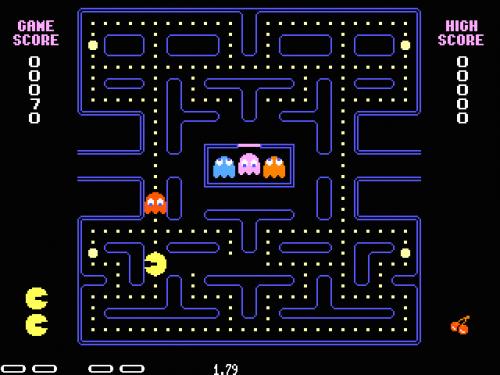
In Martina Kellner’s work “Pac-Man Time Out”, which was showed at the exhibition A MAZE in Berlin 2009, Kellner had created short video clips that investigated what Pac-Man actually did in the short time he was away from the monitor. In one clip, we find him at the airport queue with Ms. Pac-Man ready to board. Perhaps they are planning to take a holiday away from the busy videogame environment? One thing is for sure, Pac-Man does no appear in contemporary art as much as his colleagues from other classic games as Space Invader, Pong and Super Mario.
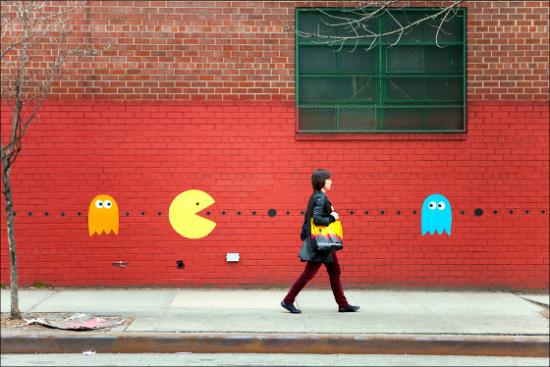
Like many 8-bit characters Pac-Man is well represented in street art and design. For example the American street artist Katie Sokoler staged a real Pac-Man game in her quarters. But it is quite unusual with installations, machinima or Art Games in which Pac-Man has the lead role. This is a bit odd considering how famous Pac-Man is among the general public. The French artist François Escuillie has even created a paleontological reconstruction of Pac-Man’s skull and the Swedish artist Johan Lofgren has in his new colour series “Confessions of a Color-Eater” taken with the colour “Ms. Pac -Man-yellow “, but despite this there are few interactive artworks based on Pac-Man.
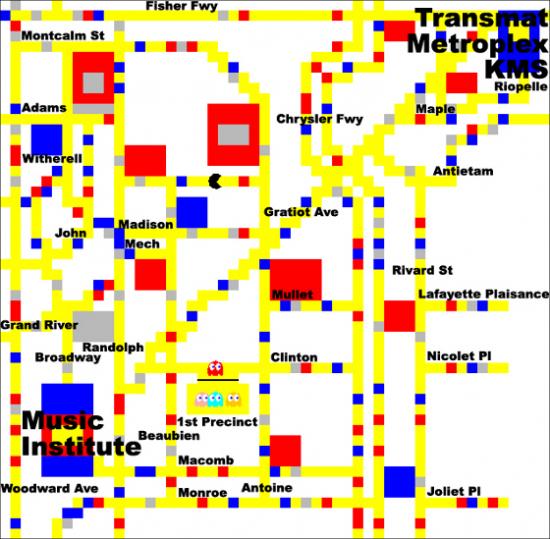
Two exceptions are in any case worth highlighting: the “Pac-Mondrian” and “Eggregore”. “Pac-Mondrian” was created in its first version in 2002 by the Canadian artist group, Price Budgets Boys and is described as a mix of Piet Mondrian, Pac-Man and Boggie Woggie music. The board consists of Piet Mondrian’s painting “Broadway Boogie Woogie” (1942-43), which in its turn is inspired by Manhattan’s street grid and boogie woogie music. The videogame works with the same principle as a normal Pac-Man game except that the maze is a painting by Piet Mondrian. Price Budget Boys have also created three sequels: “Detroit Techno” (2005), “Tokyo Techno” (2006) and “Toronto Techno” (2006). The labyrinths in the new versions are created by stylized street grid from each city, executed in the style of Piet Mondrian. And in the name of equality, you play as Ms.Pac-Man in these versions. For those who have followed previous articles in this series, will recognize that there is a similarity between “Pac-Mondrian” and the Danish artist Andre Vistis works “PONGdrian v1.0”, in which Vistis combined the videogame PONG with Mondrian’s paintings.
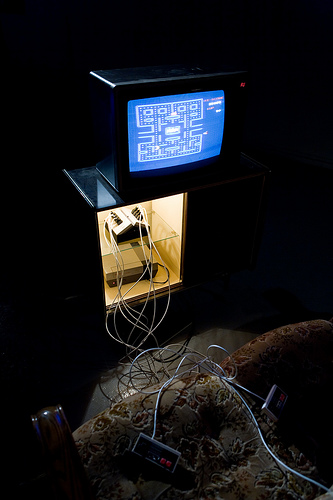
Antonin Fourneau & Manuel Braun’s work “Eggregore” is a social video game in which eight players, each with its own control will try to collaborate and steer Pac-Man through the maze. It may sound like an old teamwork workshop with a twist. Eight wills and strategies must collaborate to succeed with the mission. “Eggregore” is a Greek word which is associated with occultism and means a collective mind. The question that Fourneau and Braun is asking is: Can multiple individual game strategies together create a stronger and better collective player or will it just be chaos when the different games strategies are pulling in different directions? In the video game world, there are many examples of online worlds like World of Warcraft, where player successfully work together in clans or guilds in order to achieve higher goals in the game. It has even become an asset in your CV to show that you have played World of Warcraft and that you can lead and work together with other players to achieve different goals. Pac-Man, however, seems to be a rather greedy individualist who only thinks of himself in the video game world. And perhaps it is this self-absorption with himself taht prevents the game from breaking through as a major theme in contemporary Game Art?
Pac-Mondrian:
http://www.pbfb.ca/pac-mondrian/
Eggregore:
http://liftconference.com/eggregor8
Videogame appropriation in contemporary art: Pong. Part 1 by Mathias Jansson.
Videogame appropriation in contemporary art: Tetris. Part 2 by Mathias Jansson.
Videogame appropriation in contemporary art: Space Invaders. Part 3 by Mathias Jansson
Between July 27th and August 29th, 2010, the eleventh edition of the FILE festival is taking place in Sao Paulo (Brazil), at several locations along the popular Paulista Avenue. After a decade of existence, this veteran festival, which spreads over several cities in Brazil (including Rio de Janeiro and Porto Alegre) as well as other international locations, has introduced for the first time its own award: the FILE PRIX LUX. With a total amount of approximately 120,000 euros, distributed in three categories, the prize is unprecedented in the continent and has received, on this first edition, 1,235 registrations from 44 countries.
Yet this award is not the only remarkable aspect of this year’s festival, which stands out for being particularly accessible to the general public. On the one hand, the exhibitions, performances and workshops as well as the symposium have no entrance fees, and therefore there have been many visitors, most of all young people who line up every day to experience the interactive installations at the FIESP-Ruth Cardoso Cultural Centre. On the other hand, the festival organizers, Ricardo Barreto and Paula Perissinotto, have developed this year a project that takes digital art to the Paulista Avenue by placing several interactive artworks at different locations in the public space. Finally, even the FILE PRIX LUX has been open to the interaction with the public by introducing a popular vote category and an online voting system which was accessible between May and June. This openness sets a good example of how media art festivals can engage the general public to approach this somewhat ignored form of art.
In general terms, the award categories at media art festivals have been subject to change as the creative uses of technology evolved during the last decades. The FILE PRIX LUX has the advantage of being created at a time in which it can be relatively safe to set up a few broad categories that cover most of the forms of combining art and technology. Only three categories have been established: Interactive Art (which usually refers to objects and installations that respond to inputs from the viewer/s), Digital Language (related to the festival’s title and which embraces any artwork that deals with language, narrative, code or text in a generative or interactive manner) and Electronic Sonority (the category assigned to any artwork in which the production or manipulation of sound is a key element). These three categories prove to be comprehensive, as shown by the diversity of the projects distinguished with a prize or an honorary mention: immersive interactive installations, musical performances, urban interventions, bioart pieces, a collectively created machinima movie and even an iPhone app are among this year’s FILE PRIX LUX awardees.
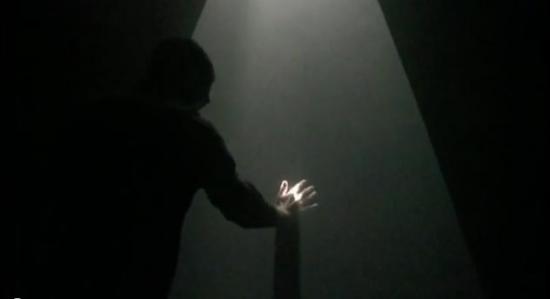
In the Interactive Art category, the winners are Ernesto Klar for Relational Lights (1st prize) and Kurt Henschläger for Zee (2nd prize). Both present immersive environments in which light and space are key elements, although the interaction is totally different. Klar’s work invites the viewer to interact with two projected geometric drawings inspired by the work of Lygia Clark. In a hazy dark room, the viewer sees two T-shaped projections of white light on the ground, which form a three-dimensional space which reacts to the visitor’s presence. The interaction is playful and really beautiful in its simplicity, whilst also limited in time: after a few minutes, the projections suddenly stop reacting to the user’s movements and reconfigure themselves in a new shape. This abrupt interruption is consciously introduced by the artist in order to remind the viewer that the artwork has a life of its own. In contrast, Henschläger’s Zee takes place mostly in the mind of an audience exposed to an overdose of audiovisual stimuli in a foggy room. Continuing the experience of his acclaimed performance FEED, this time the artist allows the viewer to walk around the space and have a more meditative sensory experience.
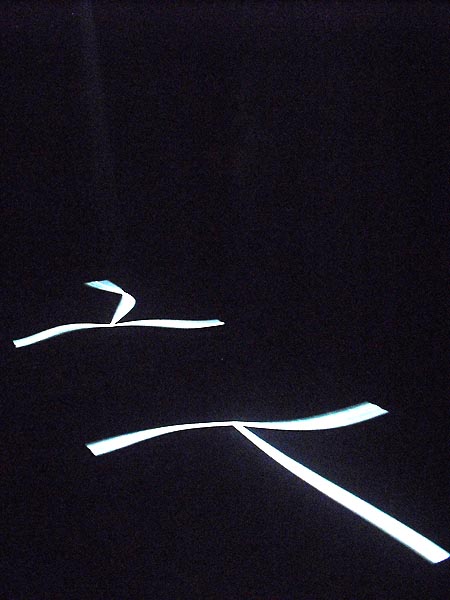
The Electronic Sonority category has brought together several outstanding works, among which Jaime E. Oliver’s Silent Percussion Project and TERMINALBEACH’s Heartchamber Orchestra have been distinguished with the 1st and 2nd prize, respectively. In both projects the human body is incorporated in a novel form in the creation of music, the sound being produced, moreover, not simply by direct inputs but by complex interactions in a constant flow of data. Oliver’s instruments convert the shapes created by the performer’s hands into streams of data that generate, in turn, different sounds. These sounds are not always the same, as could be the case in a traditional instrument, but are changed by the variables established in previous interactions. Thus, Oliver does not simply create a new form of interacting with an instrument but rather a new form of creating music. In a similar way, the [i]Heartchamber Orchestra[/i] project developed by TERMINALBEACH (Erich Berger and Peter Votava) explores a form of creating music based on a feedback loop in which the performers are writing and following the score at the same time. As the artists state, in their project “the music literally comes from the heart”: a network of 12 independent sensors record the heartbeats of the musicians in an orchestra and sends the data to a software that generates a musical score in real time. The musicians play the score as it is displayed on the laptops in front of them, while their heartbeats set the notes in a continuous cycle in which music and performer constantly influence each other.
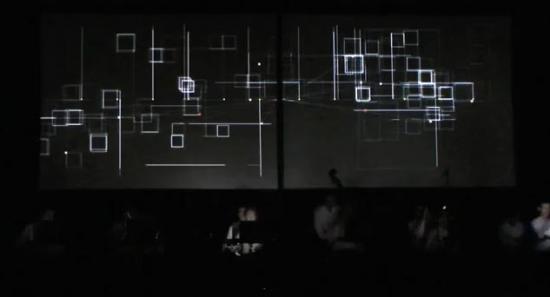
Digital Language is certainly the broadest category of this FILE PRIX LUX, its awardees being quite dissimilar in the formats they use and the objectives of their respective projects. The organizers define this category as including “all research and experiments in the ambit of the multiple disciplines that use digital media”, and the winners exemplify how diverse these disciplines can be. The 1st prize winner, Tardigotchi by the artists collective SWAMP (Douglas Easterly, Matt Kenyon and Tiago Rorke) is a bioart project that sets a critical comparison between artificial and real life. A nicely designed, steam punk-inspired device hosts, on the one hand, a tardigrade, a microorganism measuring half a millimeter in length, along with a robot arm that injects a substance that feeds the creature and a heating lamp that provides warmth. On the other hand, a digital display shows the virtual avatar of this tardigrade, with which the user can interact. Humorously referencing the popular Tamagotchi toy, the artists create a link between the avatar and the real creature: when the user presses the button to feed the avatar, the device inserts real food in the environment of the tardigrade; when an email is sent to the digital creature, a heating lamp gives warmth to the microorganism. Thus, interacting with the virtual pet has consequences in a real living being. This brings our attention into what we can consider alive and how we emotionally attach to artificial creatures while at the same time we undervalue the existence of other living beings. On a different approach, the 2nd prize winner, Hi! A Real Human Interface, by the collective Multitouch Barcelona (Dani Armengol, Roger Pujol, Xavier Vilar and Pol Pla), proposes a more human relationship with technology. A video presents the concept developed by this interaction design group of a different GUI in which a real person is displayed as impersonating the computer. Common interface elements are replaced by handmade physical objects which remind the aesthetics of a video by Michel Gondry. The result is a playful form of interaction in which simple operations such as checking email or upgrading the operating system are shown as actions carried on with real objects by a person inside a box. The proposal is engaging and certainly sets a departure from the old desktop concept, yet it remains unsure to what extend this type of interaction can be applied in a real operating system.
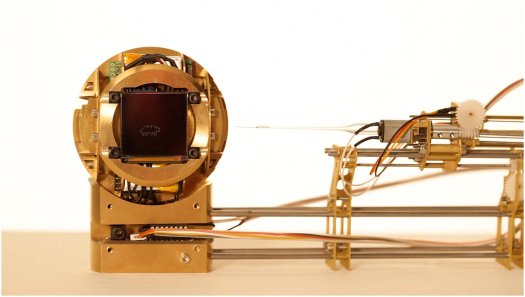
The works that obtained a Vesper statuette (symbol of the FILE PRIX LUX award) along with the also outstanding Honorary Mentions are exhibited at the FIESP-Ruth Cardoso Cultural Centre in a group show that also includes FILE Media Art, a selection of more than 70 works that can be accessed on several computers, as well as a selection of videogames and machinima films. The exhibition is thus richer in content than it would seem at first sight, as the space is divided in numerous sections that conceal several installations which demand (as usual) almost total obscurity. The artworks are well presented, although at times the sound from one installation invades the others, and there are no wall labels that inform the viewer about the concept of the piece or the way to interact with it. The latter, much-discussed issue is quite important, since the info-trainers cannot explain the artworks to every visitor, and quite often this entails that some people may not interact with the pieces or worse, start smashing buttons or interfering projections blindly in the hope of modifying them. Despite this fact, the exhibition has proven to be very successful during the first week of the festival, with a steady flow of visitors who showed a profound interest in the artworks.

A part of the exhibition is devoted to the FILE MACHINIMA section, curated by Fernanda Alburquerque, who selected over 40 works. Among these is the award winner in the Popular Vote category, War of Internet Addiction, by Corndog and the Oil Tiger Machinima Team from China, a 64-minute movie collectively created by players in the MMORPG War of Warcraft. More than mere entertainment, this film has been created as a form of protest against the Chinese authorities’ attempt to control the access and commercial benefits derived from the WoW game, which is extremely popular in the country. The film has had 10 million views since January 2010 and despite being available only in Chinese, it has been the favorite work of those who participated in the online voting system of the FILE PRIX LUX. Besides this feature film, other short films explore the possibilities of building narratives in virtual environments such as Second Life and videogames such as Half Life 2, Eve Online or Shadow of the Colossus.
In addition to the main exhibition, the FIESP Cultural Centre hosts a series of performances and screenings. Under the title Hypersonica, the festival presented a series of digital music performances, among which where the two winners of the FILE PRIX LUX in the Electronic Sonority category. FILE DOCUMENTA, curated by Eric Marke, offers in its 5th edition a selection of “rare and new” documentary films, among which Andreas Johnsen’s Good Copy Bad Copy, an interesting exploration of the conflicts between remix artists and copyright owners, or Robert Baca’s Welcome to Macintosh, which records the first years of the history of Apple Computers.
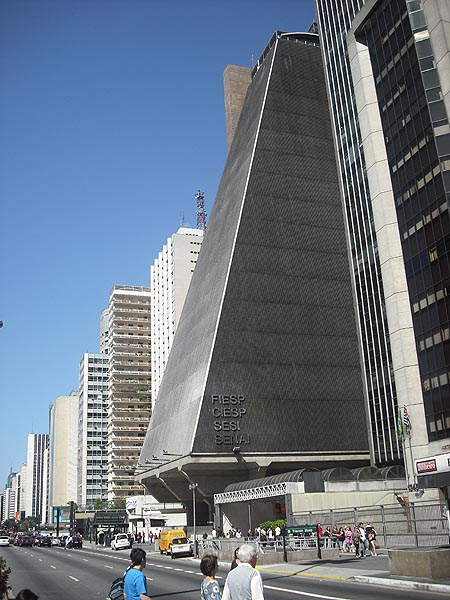
The symposium, hosted by the Instituto Cervantes in Sao Paulo, gathered several experts and artists who presented their explorations in the theory and practice of media art. Among the most interesting contributions were the presentation of Prof. Espen Aarseth on the aesthetics of ludo-narrative software, and the colloquy of South American digital art, in which Raquel Renno (Brazil), Jorge Hernandez, Ricardo Vega (Chile) and Vicky Messi (Argentina) discussed the current developments in the media art scene in the South Cone.
Alongside the FILE PRIX LUX, the most outstanding feature of the present edition of the festival is FILE PAI (Paulista Avenida Interactiva), which takes several interactive artworks to the public spaces in the Paulista Avenue. Interactive art offers the possibility of bringing art to the public space in a more efficient and dynamic form than what is usually known as “public art”. As Ricardo Barreto states: “the public environment is not something empty, aseptic and dead, as is the old white cube; on the contrary, it is an environment teeming with life, with multiple interests and multiple behaviors”. Interactive art integrates itself into this environment and is much more apt to relate to a public that is now willing to take an active role. The organizers of the FILE festival have distributed twelve interactive artworks along the Paulista Avenue, at subway stations, inside shopping malls, and even in a bus. The selected artworks include, among others, videogames such as Patrick Smith’s Windosill or the celebrated games of That Game Company, Flower and Flow; VR/Urban’s SMSlingshot, an urban intervention project that allows users to write a message in a custom-made slingshot that incorporates a screen and a keyboard and then send the message to a wall, where it is displayed as a virtual graffiti; Karolina Sobecka’s Sniff, an interactive projection in which a virtual dog reacts to the presence of passersby; the installations of Rejane Cantoni and Leonardo Crescenti Piso and Infinito ao Cubo, which attracted a large number of people, and the sound piece Omnibusonia Paulista by Vanderlei Lucentini, which is played in a bus as it moves along the avenue, interacting with several points in the itinerary and thus generating a new set of sounds in every trip. These works reveal the possibilities of integrating interactive art in the public space, to the point that, as Ricardo Barreto indicates, “the new paradigm of public art will be the interactive city”. The busy Paulista Avenue is certainly a good location for the creation of an emerging, interactive city.
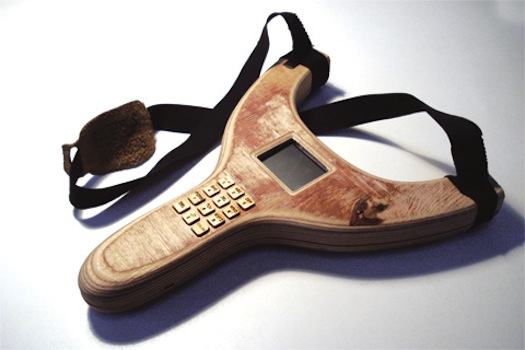
In this 11th edition, the FILE festival has achieved a state of maturity. The FILE PRIX LUX, FILE PAI and an estimated 25,000 visitors to date support its claim of being the largest festival of its kind in Latin America, and a steady event that places Brazil in the map of the international digital art scene. In a tightly interconnected world, each region is a node: there isn’t a center and a periphery anymore, there are no colonies. FILE exemplifies how a region can become a powerful node in this network by promoting the most recent developments in art and technology, avoiding obsolete distinctions between North and South and becoming a point of development for the future stages of our digital culture.
Above image taken by Scott Beale, Laughing Squid.
Marc Da Costa interviews the ever dynamic Johannes Grenzfurthner, founder of monochrom. This is the first of three interviews, where he talks about the project ‘Soviet Unterzoegersdorf’; the fake history of the “last existing appanage republic of the USSR”. Created to discuss topics such as the theoretical problems of historiography, the concept of the “socialist utopia” and the political struggles of postwar Europe. In March 2009 Monochrom presented ‘Soviet Unterzoegersdorf: Sector II’. The game features special guest appearances of Cory Doctorow, Bruce Sterling, Jello Biafra, Jason Scott, Bre Pettis and MC Frontalot.
Since 1993, the Monochrom members have devoted themselves to the grey zones where systems intersect: the art (market), politics, economics, pop, gaiety, vanity, good clean fanaticism, crisis, language, culture, self-content, identity, utopia, mania and despair. The technique underlying Monochrom’s work is that of being and working in the fields of Pop/avant-garde, theory/reflection, interventionism/politics, gaiety/lust/tragedy, (self-)configuration/mystification. The project Monochrom pushes into and beyond these fields is, ‘networking’ events, people, possibilities, material, impetus and identities.” (Zdenka Badovinac, Moderna Galerija Ljubljana)
Grenzfurthner has collaborated with groups such as ubermorgen, Billboard Liberation Front, Esel and Mego (label). Grenzfurthner writes for various online/print magazines and radio stations (e.g. ORF, Telepolis, Boing Boing). Grenzfurthner has served on a number of art juries (e.g. Steirischer Herbst, Graz). He holds a professorship for art theory and art practice at the University of Applied Sciences, Graz, Austria and is a lecturer at University of Arts and Industrial Design in Linz, Austria.
Recurring topics in Johannes Grenzfurthner’s artistic and textual work are: contemporary art, activism, performance, humour, philosophy, sex, communism, postmodernism, media theory, cultural studies, popular culture studies, science fiction, and the debate about copyright.
The ‘Soviet Unterzoegersdorf’, a game created by monochrom, is described as being at once the “last existing appendage republic of the USSR” and located inside the Republic of Austria. Could you speak a bit about the project and its background?
From a conceptual background we have to state that we have been occupied with the construction, analysis and reflection of alternative worlds for quite a long time. A lot of our projects are treating this field partly as a discussion with concepts deriving from popular culture, science and philosophy, and partly as a direct reference to science fiction and fantasy fan culture. We first created the fake history of the “last existing appendage republic of the USSR” in 2001 — ten years after the ‘mighty Soviet Union’ went into this nation-state-splitting-up-process and new countries emerged like Firefox pop-ups that you can’t manage to click away.
We wanted to discuss topics such as the problems of historiography, the concept of “utopia” and “socialist utopia” and the political struggles of postwar Europe in a playful, grotesque way. You have to bear in mind that the real village of Unterzoegersdorf was part of the Post WWII Soviet zone from 1945 until the foundation of the ‘neutral’ Republic of Austria in 1955. Reactionary Austrians talk about 1955 as the ‘real liberation’… and I have to mention that that’s rather typical: cheering when Hitler arrives and being proud members of the Third Reich, afterwards proclaiming that Austria was the first victim of Nazi Germany and complaining about the allied occupation forces — especially the Soviet.
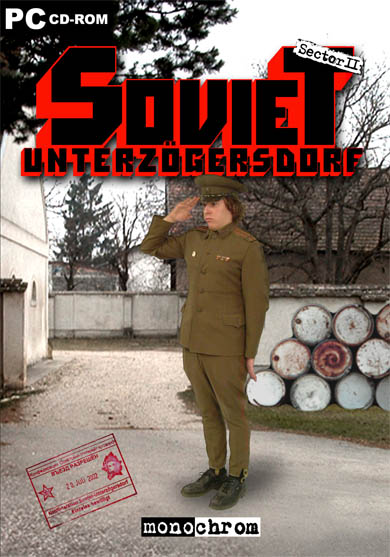
We transformed the theoretical concept into an improvisational theatre/performance/live action role-playing game that lasted two days. That means we really organized bus tours to Unterzoegersdorf — a small village that really exists — and acted the setting; beginning with the harsh EU Schengen border control. Later, in 2004, we started to think about a possible sequel to the performance. We thought that the cultural format of the “adventure game” provided the perfect media platform to communicate and improve the idea.
We started to work in February 2004 and presented ‘Sector 1’ — the first part of the trilogy — in the form of an exhibition in Graz/Austria in August 2005. We released ‘Sector 2’ in 2009, featuring guest stars as Cory Doctorow, Jello Biafra or Bruce Sterling. As the game series uses a 3rd person perspective with photo backgrounds and pictures of real actors as sprites, it took us quite a while to digitize and image process all of the material. This technique was actually first used by Sierra On-Line during the early and mid-1990s — but we are quite proud that we managed to get the feeling of discovering an old computer game that never existed on your old 500 MB hard drive. One aspect of the game is playing with memories and the future of the past. The future is a kind of carrot, the sort tied just in front of the cartoon donkey’s nose so it goes to work, goes off to war, learns Javascript and knows which bits to laugh at in Woody Allen’s Sleeper. You can imagine.
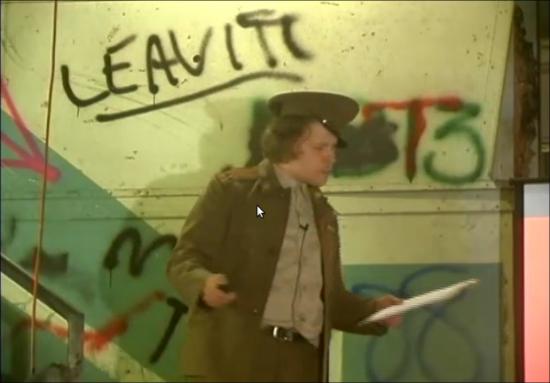
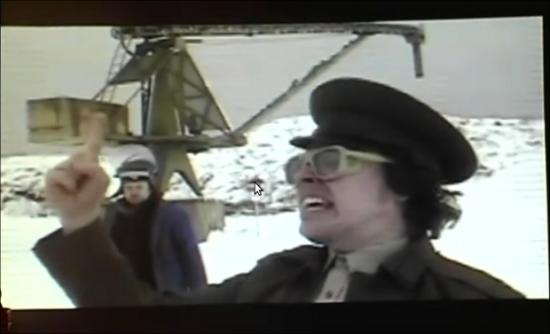
At a HOPE conference a few years back I was interested to hear you talk about the framing of the project as somehow deeply connected with a certain understanding of historiography that you and the other members of monochrom share. Could you elaborate on this a bit?
Debates triggered by postmodern culture have directed our attention towards questions of representation and the relevance of “history” and stories — i.e. The challenging proclamation of a post-histoire, the realization of the impossibility of a meta-narrative of history; the clash between reality and sign systems, the difference between fact and fiction, the impossibility of neutral contemplation or witnessing as well as the positioning of subjective awareness within such representations, etc. All these forms of representation have been playing a central part in the development of national, ethnic and tribal identities since WWII. And (as a by-product of military technology) computer game development is hardly aware of these discourses.
We wanted to combine (retro)gaming and (retro)politics and (crypto)humor to delve into this ongoing discourse. We wanted to harvest the wonderful aesthetic and historic qualities of adventure gaming. It is a commemoration and resurrection, and one more reminder that contemporary gaming (in its radical business-driven state-of-the-artness) should not dare to forget the (un)dead media of the past — or they will haunt them.
If you compare the status of the adventure game in the context of the economic growth of the computer game industry you could state that it is gone. Less than 1% of all computer games written are adventure games. Adventure games are nearly extinct… but only nearly. If media and media applications make it past their Golden Vaporware stage, they usually expand like giant fungi and then shrink back to some protective niche. They just all jostle around seeking a more perfect app.
For many people in the Soviet Unterzoegersdorf team, adventure games are part of their media socialization. For the computer industry it is one of the most successful gaming formats of the past. And for the feminist movement it is proof that a woman — I’m talking about Sierra On-Line’s Roberta Williams — was able to shape the form of a whole industry totally dominated by men.
Computer games are embedded in the cultural framework of technological developments. In the study of technological development and creativity, focusing attention on the failure, the error, the breakdown, the malfunction means opening the black box of technology. Studies have convincingly demonstrated that the widespread inability to understand technological artifacts as fabricated entities, as social and cultural phenomena, derives from the fact that in retrospect only those technologies that prove functional for a culture and can be integrated into everyday life are “left over.” However, the perception of what is functional, successful and useful is itself the product of social and cultural–and last but not least–political and economic processes. Selection processes and abandoned products and product forms are usually not discussed. According to Langdon Winner, there is a sense in which all technical activity contains an inherent tendency toward forgetfulness. Quote: “Is it not the point of all invention, technique, apparatus, and organization to have something and have it over with? (…) Technology, then allows us to ignore our own works. It is license to forget.”
Could you also perhaps talk about the choice of selecting the genre of an adventure game as the incarnation of this downtrodden republic. At the risk of being literal minded, is there any sense in which the existence of ‘Soviet Unterzoegersdorf’ as a kind of place that comes alive through players’ interactions with a program downloaded from the internet has anything to say to how you imagine being able to engage/critique/disrupt the idea of the nation-state?
We are postmodern leftists. A little bit melancholic… but you can count on us. We love to play with layers of consciousness and layers of layers of consciousness. On first view our project could be interpreted as a mock-up of the Soviet Union and the communist state structures that really existed. But, why on Earth do we need so many references to 1980s and 1990s metal music? Or Marvin Minsky? Or Negri? Or Austrian post-WWII history? Or geek adumbrations? Mocking the Soviet State would be much easier. In fact it’s about the wonderful clash between reality and sign systems, the impossibility of neutral contemplation or witnessing as well as the positioning of subjective awareness within such representations. The traditional humanists tend to see the whole philosophic aesthetic postmodern line of thought — from Judith Butler to Lyotard and Derrida — from the wrong angle. Okay, you can’t explain Sun Ra to a Green Day fan now, when he’s laying in the corner, piss-drunk and crooning “Anarchy”. But we think that the (radical) nature of postmodernism is often simply not grasped because people just copy it down into the conservative pattern of thinking which has been indoctrinated into us since the Enlightenment. Of course, on the other hand, it functions as a virus, and there’s nothing wrong with that.
Contemporary art — the field we are usually working in because there’s money — is mostly concerned with systems or systematic concepts. In the context of their work, artists adapt models of individual art-specific or economic or political systems like in a laboratory, to reveal the true nature of these systems by deconstructing them. So would it be fair to say that by their chameleon-like adaptation they are attempting to generate a similar system? Well… the corporate change in the art market has aged somewhat in the meantime and looks almost as old as the ‘New Economy’. Now even the last snotty brat has realized that all the hogwash about the creative industries, sponsoring, fund-raising, the whole load of bullshit about the beautiful new art enterprises, was not much more than the awful veneer on the stupid, crass fanfare of neo-liberal liberation teleology. What is the truth behind the shifting spheres of activity between computer graphics, web design and the rest of all those frequency-orientated nerd pursuits? A lonely business with other lonely people at their terminals. And in the meantime the other part of the corporate identity has incidentally wasted whole countries like Argentina or Iceland. That’s the real truth of the matter.
Read Part 2 of this Interview
http://www.furtherfield.org/features/interviews/interview-johannes-grenzfurthner-monochrom-part-2
Read Part 3 of this Interview
http://www.furtherfield.org/features/interviews/interview-johannes-grenzfurthner-monochrom-part-3
Seven years ago, or about two years before the invention of youtube, the editors of Tank Magazine saw the possibility of an internet platform dedicated to video art. Their response was tank.tv, an Internet site that is part moving image archive, part online gallery, and part cutting edge video art exhibition.
After a quick and painless registration, tank visitors can wander by artist through a catalogue of some of the best short films of recent time, including works by Ken Jacobs, Pipilotti Rist, Vito Acconci, Hans Ulrich Obrist, Guy Maddin, Jeremy Deller, and Saskia Olde Wolbers. This archive alone is enough to make tank.tv a cultural treasure. But about eight times a year, tank also puts up shows organized by theme, and here films by emerging artists like Claire Hope and David Blandy are featured alongside more established filmmakers and more recognizable names.
“The sole focus is on the work,” explains curator and creative director Laure Prouvost, who has been with the site since its beginning. Prouvost describes tank.tv as a completely open endeavor, one that supports experimentation by accepting submissions and curatorial proposals throughout the year: “We have worked to make tank.tv a collaborative platform over time and we’re still looking for ways to open our programme as much as possible.”
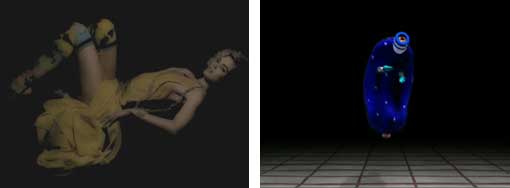
After running a series of solo shows in 2009, tank decided to finish the decade with the group show Open End. About twelve films were selected from the submissions tank.tv received throughout the year. Works by emerging artists received special attention. They include Just a Quiet Peaceful Dance by Dean Kissick, a rapid, flash cut montage that cascades in one smooth glide over its upbeat house track, and the dreamy, slightly disturbing 3D animation Your Uncertain Spirit by Jonathan Monaghan.
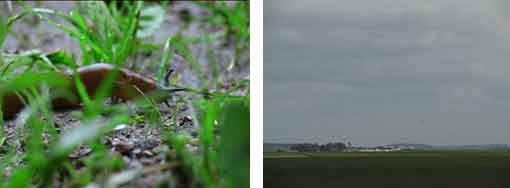
Each of these films were beautifully made and conceived, allowing a special kind of online engagement. In the lyrically photographed Momentary Seizures, Katja Aglert gives us an allegory of war and genocide through the life of a garden snail. Filmmaker Andrew Cross uses a single shot of the landscape as a meditation on time in his film Across. In Pulcera, Nicholas O’Brien uses a series of long takes to explore the relationship between image, gesture, and memory. Filmmaker Michael Fortune exploits the conventions of the reality television and the non-fiction form to make visible the relationship between custom, ritual, and community in We Invented Halloween.
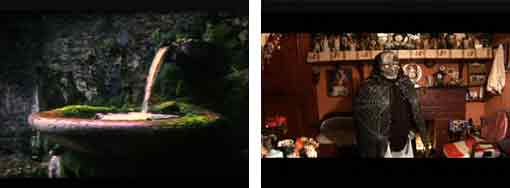
Not quite essay, but something more like the spirit of anti-narrative informs other films in Open End. Among these is Jon Purnell’s CackULike, which documents men in white linen invading the mass transit system, and Steven Eastwood’s self-reflexive and ironic examination of filmmaking in Seminar in Film and Sound.

Screengrabs: CackULike by Jon Purnell (left) and Seminar in Film and Sound by Steven Eastwood (right)
By deconstructing the war film genre, Matthew Johnstone manages a few genuinely harrowing moments in Modern Warfare, a film which combines aerial photography of a bombing run with routine and no-so-routine audio tracks depicting military training sessions. In Inadvertent Prose, filmmaker Mark Shorey distills noir down to its single essential moment of threat and violence.
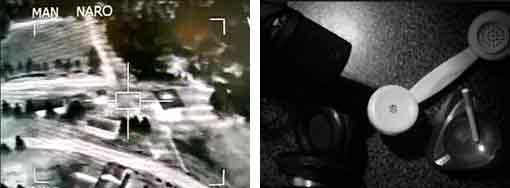
Animators are also represented. There’s the completely silly and kooky Conveyor-Iphone by Oliver Michaels, which just gets funnier and funnier as it runs its six minutes – really it is just wonderfully preposterous. Simon Woolham’s The Pile creates a mysterious and idiosyncratic relationship between an odd group of objects or states and their related sounds. In The Sausage Party #2, #D animator Michael van den Abeele pairs the evolution of a wire grid that slowly increases in complexity with the sound of a desolate, blowing wind.
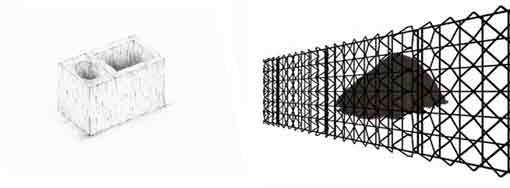
About twenty thousand visitors from sixty countries will see Open End. This is obviously good news for the filmmakers who show work here and audience reach is one of the main benefits of their being online. But tank curator Laure Prouvost sees additional benefits in internet exhibition: “Websites such as ours or UBU or LUX offer direct and fast access to work that would otherwise be very hard to view. It’s a fantastic way to get an introduction to an artist’s work. For us curating online gives us a lot of freedom – we have low overhead costs and can react very quickly.”
While the Internet will never replace the cinema or the gallery, Prouvost does point out its use as an extension of those spaces. As the quality of delivery improves, Prouvost believes the web will be used more and more as an introductory space for serious video art. If you watch films, a copy of Fresh Moves, the first DVD compilation from tank.tv can be ordered through tank.tv’s website.
If you make films, Tank is also accepting submissions for The Whole World, an upcoming show by curator Ian White. Prouvost explains The Whole World as a show about the idea of lists: “Both a formal device and a political strategy, film and video that deploys a list as part of its structure often does so with political intent: to subvert hierarchies, to undermine rationalism or to reveal contradiction. In contemporary culture the pop chart’s Top 10 has been replaced by an ever-expanding craze for “Top 100s” of everything from Hollywood genres to celebrity gaffes. The Whole World attempts to wrestle back the initiative. As part of the show we continue to accept submissions of list-centric videos so that The Whole World continues to grow over time.”
“Mapping CCTV around Whitehall”, 2008, is, as its name implies, a performance of mapping Closed Circuit Television (CCTV) security cameras around the UK’s parliament in London and a video record of that performance by Ambient.tv’s Manu Luksch.
Starting with a HAL 9000-like image of a CCTV lens, the video of “Mapping CCTV In Whitehall” has a glitchy techno aesthetic of sound and images with a post-MTV-Style Guide reportage feel. The first half consists of a recording of the police stop-and-search interviewing Luksch under anti-terrorism legislation, with a map of the area superimposed. The second half consists of CCTV views of the range of Camera number 40 being taped out, and of the people caught within those bounds. Words flash on the screen to identify the subjects of CCTV (….Artists! Sexy Arses!). This redeployment of the language of mass media visual persuasion opens up what we see rather than closing it down, making it a very effective encapsulation of the project’s ideas and aesthetics.
(One tiny criticism is that the video ends with a Creative Commons logo but doesn’t specify the licence. Artists, please at least give the licence URL, and do choose the copyleft BY-SA licence if you can…)
Wandering around to locate CCTV cameras may seem like a cosy techno-fetishist performance, a post-cyberpunk flaneur’s stroll around the streets of London with a pencil, an A-Z, and a tri-field meter. But the creeping authoritarianism of still-Thatcherite Britain makes it an act of protest against a specific law and a reversal of the assumptions of our seemingly unstoppable surveillance culture.
The Serious and Organized Crime and Police Act of 2005 criminalized political expression within an exclusion zone for a kilometre around Parliament Square. It is an indicator of the authoritarianism and assumption of privilege that has come to define political culture in the UK. It is too easy to become cynical in the face of such brazenly opportunistic ideology. If art can help to defamiliarise this in a playful and aesthetically rewarding way then it can help to undo that cynicism, and even more to go beyond it.
The assumption that the State needs to know where you are at all times, just in case you are a terrorist or a paedophile, but that you must not know the workings of the State, just in case you are a terrorist or a paedophile, is at odds with the idea of an open society. The area of London that Luksch has mapped is the SOCPA exclusion zone. A map of CCTV cameras is clearly useful to terrorists, and a map of the CCTV cameras near Parliament is clearly an act of dissent against the political consensus that constitutes domestic extremism. The police who interview Luksch touch on these ideas.
A political elite that is fearful both of and for its polity has retreated into managerial, authoritarian, paternalistic risk-management. That polity is conceived of, post-cold-war, not even economically, more nihilistically. This produces the very loss of freedom that it claims to protect against. The paradigm of government has become the watchful parent who is seen to be good by their watchful neighbours because they prevent their child ever straying into danger. But it is impossible to protect the population against all risk and this knowledge leads to impotent fearfulness. “Something must be done” and so security theatre, the spectacle of impossible systems and behaviours designed to reduce the perception of risk to zero, is used to reassure. Although whether the populace or the politicians are meant to be reassured it is hard to tell.
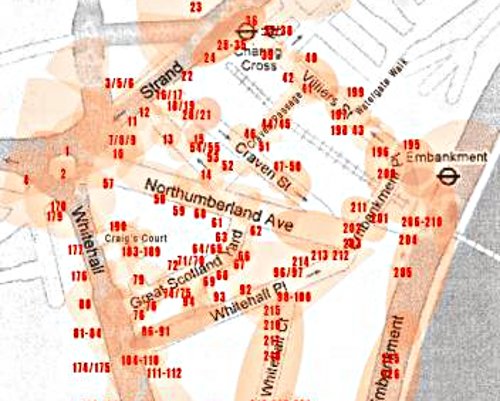
CCTV is part of that reassurance, of the spectacle of security theatre. The UK has the highest density of Closed Circuit Television Cameras (CCTV) in the world. The average Briton is (allegedly) captured on CCTV 300 times a day and there are more cameras in the supposedly open society of the UK than in notionally communist China. Not per head, in total. The area that “Mapping CCTV around Whitehall” focusses on is ground zero for this tendency.
CCTV doesn’t solve crime, it is used to spy on legal protest and it has been placed in school classrooms and pubs.
CCTV recordings are subject to the Data Protection Act, and from 2002-2008 Manu Luksch used personal data requests under the act to obtain the CCTV recordings of her going about her business that she used to make the film “Faceless”. The videos usually had other people’s faces blotted out to protect their privacy, which gave the resulting film its science fiction plot of people starting to lose their faces. But as Luksch was making “Faceless”, the responses to her personal data requests became rarer as the authorities adjusted the balance of power back in favour of themselves.
In 2008, Luksch returned to the subject of CCTV with “Mapping CCTV around Whitehall”, this time mapping out the CCTV cameras themselves within a particular area of London over two days. On the first day she located hundreds of CCTV cameras, on the second she measured the range of the wireless broadcasts of one of them. Part performance, part land art, this has a number of artistic precedents, from the 1960s conceptual artworks that consisted of magnetic fields or patterns of heat, to Situationists strategies for recontextualising the city by navigating it using the wrong map.
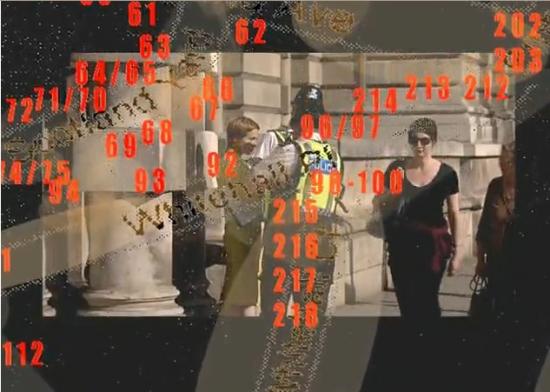
Mapping unseen electromagnetic forms was a strategy of some Conceptual Art, whether Art & Language’s landscape art infrared photograph of buried hotwires under a field or gallery-based magnetic and radio-proximity devices. Contemporary artists have used RFID tags Intangible form is irresistible for post-Duchampian attempts to keep the philosophy of art about aesthetics, and for conceptualism it is a way of keeping the artwork open. But the range of a CCTV camera is both definite and, if you have access to the camera, visual. The unseen form of the limits of its observation and the transmission of what it sees tie form to power quite directly.
In “Mapping CCTV around Whitehall” these forms and their composition are part of the landscape of the city. The city is obviously an artificial environment. In contrast, nothing might seem more natural than a painting of the landscape of the countryside. But landscape painting are depictions of valuable property for the landed gentry who commissioned them. They show and by showing make real the products of the ideology of the ruling class using aesthetics. They extend the domain of taste, a novel and socio-economically exclusionary concept, to the presentation of nature as property. They are as artificial, as culturally determined and laden, as cityscapes.
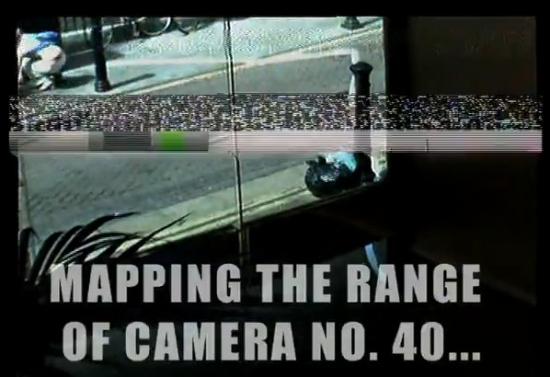
The successor to landscape painting is the “land art” of the 1960s and 1970s with its photographs of walks, mud and stones. Viewed cynically, the ‘land art’ of the 1970s is less about one man’s journey through nature than it is about cheap transport and expensive large-format cameras. It is a predecessor of the logistics art of Relationalism. The Romanticism that it shares with landscape painting is for its audience, not its commissioners. As with much art, those are two separate constituencies.
Art creates visual order and visual form for the unseen ideological order and form of the ruling class. Religious icons, jet-age land art and neoliberal Relationalism all serve this function. Critical art also depicts this ideological order, ideological form, aesthetically but to make it strange and criticise its production or content rather than to promote and naturalise it.
The Situationists treated Natopolitan 1950s Paris as a landscape to be made strange through art in order to critique the ideologies that sought to capture its population. Wandering its streets using the wrong maps was a way of challenging the authority embedded in its layout by the old regime and the new order that sought to impose its own new way of looking at things. Creating rather than using a map again re-arranges an equation, not just the equation of ‘derive’ but of the mass-media mass-politics spectacle that the Situationists were so opposed to. CCTV cameras may not seem like generators of spectacle, but their footage is used to sensationalise media reports of crime and terrorism, and their presence and visibility enforces the message that we are all part of an observed spectacle.
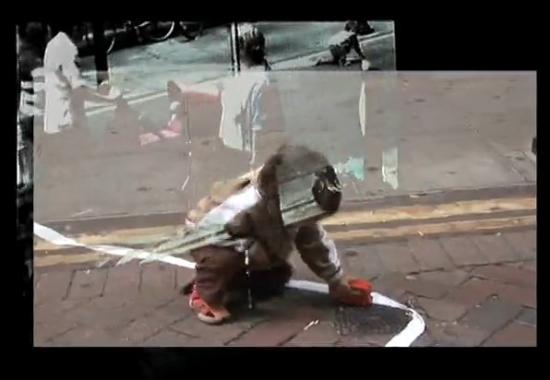
Radical land art sounds oxymoronic. But the aesthetics projected onto a landscape can be used as links to the ideology flattered by those aesthetics. And re-arranging the terms of land art can critique that ideology, or at least expose it to critique. “Mapping CCTV around Whitehall” re-arranges the equation of land art to make art of travelling to cameras in order to map the landscape they observe. This is a kind of critical, urban, reverse land art.
George Orwell’s vision of a mediatised totalitarian society from his novel “1984” is often used as a reference point for Britain’s surveillance culture. But this can obscure as much as it illuminates. Bringing out the true, novel, problems with CCTV surveillance as the default solution to the ruling class’s perception of society’s ills is an urgent and difficult task. As CCTV is a matter of the production and control of images, it is an area that art can usefully comment on. “Mapping CCTV around Whitehall” uses the status of art to represent the dark heart of surveillance ideology. Look upon its works…
http://ambienttv.net/content/?q=mappingcctv
Public screenings include ‘Films by Manu Luksch’ at Cinema2, Centre Pompidou (2009)
Betting on Shorts (2009)
http://ambienttv.net/content/www.bettingonshorts.com
NHK Japan (Japanese National Television, 2008), LIFT (2008)
Watch the video (160 sec, mp4) online at low-res.org
http://lo-res.org/~manu/MAPPINGCCTV.mp4
Or on Vimeo
http://www.vimeo.com/3802118
Featured image: A group of Australian media artists known as Horse Bazaar produce Digital Fringe at the festival
Every year as part of the Melbourne Fringe Festival (September 23rd – October 11th), a group of Australian media artists known as Horse Bazaar produces Digital Fringe. This is a nonstop digital playlist of short form video, sound, and images, some of it made by artists, some of it not, uploaded to the Digital Fringe website from around the world. Once individual entries are catalogued, the work is assembled into feeds and DVDs, and then streamed or delivered to a network of public and private locations. As expected, the festival’s general stream is sent to museums and galleries but, in an effort to commandeer every available space, Horse Bazaar also sends Digital Fringe to bars, cafes, public squares, libraries, restaurants, and pretty much any other location that will allow them in. You can see the festival online, along with an interactive map of this year’s screen locations, at the Digital Fringe website, http://digitalfringe.com.au.
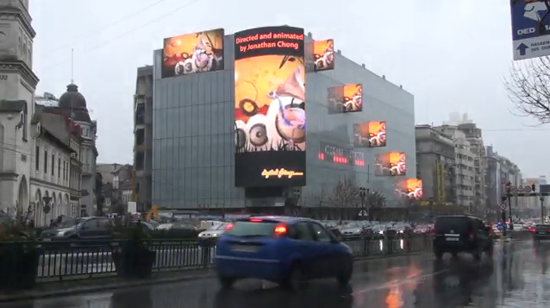
According to festival co-producer Simeon Moran, an estimated half-million people saw this year’s festival which was broadcast on about 250 screens. Most of these showings were in Australia, but there were also screenings in Africa, Europe, Asia, the US, and the UK. To project at locations where there is no existing equipment, on a street or in a public building, Horse Bazaar gathers donated screens from schools, community groups, and private supporters. To project across key buildings or monuments, Horse Bazaar calls in its mobile unit, also known as the MPU. Other than that, the festival can be, and is, about anything. There’s no jury. Submissions are not restricted to a theme. There’s just a global call for work followed by a global response.
As a result, one of the most enjoyable aspects of Digital Fringe is the range of sensibilities it manages to present. Emerging artists especially stand out. Among the more lyrical of this year’s entries is Waveform (2009), by the Amsterdam based French photographer Federico Campanale. Using video shot in Finland, Campanale lays an ambient track of digital pops and clicks against a perfect, languid, 360 degree pan of a line of trees reflected in a lake at dusk. The harsh, guttural rasp of the soundtrack set against the blue infinity of the horizon forms a direct commentary on environment and endurance, and on nature’s coexistence with the manmade.
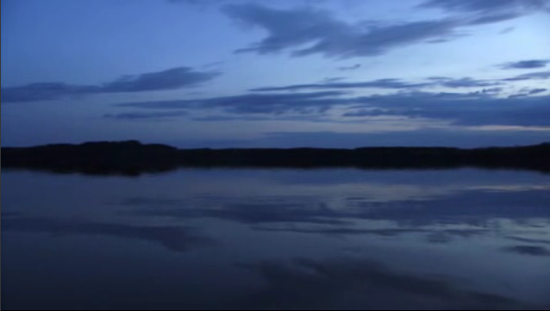
There is the moody, existential narrative The Man in His Tower (2009) from Tone Gellein of Oslo. In this video, one of those tough guy movie characters walks down the street while suffering jump cuts and odd camera angles. He ends up swinging from lampposts in a cinematic expression of an existential state of mind. Other films may be less accomplished, but are equally philosophical. For example, filmmaker Joe Tusley sent in Spud & Amp in the Barra, Part 2 (2009), a no-frills documentary about a few minutes of fishing in the Apsley Straight, Bathurst Island, NT. Maybe it’s a personal reaction, but it’s hard not to think about the big picture as, on camera, Spud reels in a huge, silver barramundi, then slits its throat.
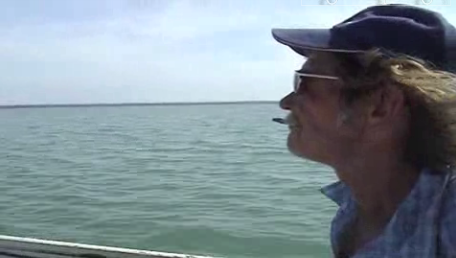
Digital Fringe also streams sound pieces, music videos, machinima, and performance films. There is a good amount of 3D modeling and animation. Colliderscope artist Zennor Alexander and musician Fiona Soe Paing submitted Thayn Tyha Hai (2009) from New Zealand. In this work, the sun and moon follow each other across a wispy, ethereal sky that lies somewhere between dreaming and waking. If you prefer something more scientific, there is the stop-motion simulation Every Second Equals Forty Million Years (2009) by animator Gregory Crocetti of Melbourne. In just under two minutes, Crocetti uses children’s blocks to build the Tree of Life from the beginning of time to just a little while ago.
There is software art such as Turkish programmer Tahir Un’s screensaver project Concepts and Images (2007). Ãœn chooses words ending with the suffix ‘ism’ as the query strings for an internet image search. After collecting images for 90 minutes, a software program fixes a random sampling of that data set into a collage.
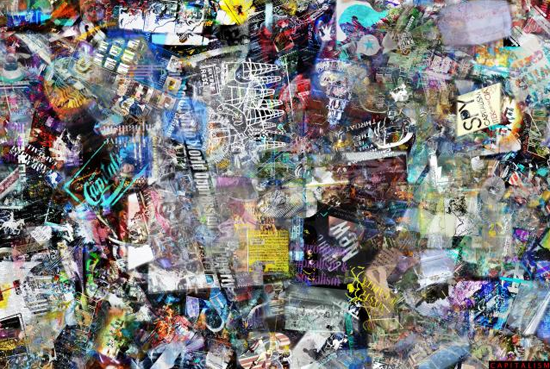
Another interesting aspect of Digital Fringe is its continued support of open source computing and shared culture. Artists uploading work to the Fringe website keep all rights to their projects and are able to license their work in a number of different ways. These include the traditional ‘all rights reserved’ copyright, the Creative Commons ‘some rights reserved’ license, and the completely unrestricted category of ‘public domain’. Creative Commons says that about 75 percent of the festival’s participants choose the CC license, which secures rights of ownership while allowing for mash-ups and remixes. This shows that many emerging artists are willing to distribute under non-traditional copyright provided there are a still few small protections.
Ultimately, Digital Fringe, is a festival that intends to include everyone, play everywhere, and show it all from the dreamscape of the perfect virtual environment to the underlit reality of the amateur video guy. Aside from its inspiring generosity, we get a lot of interesting experiments, the unmediated juxtaposition of the professional and the amateur, and a kind of yearly almanac of what up and coming digital media makers seem to have on their minds.
—
Link: Digital Fringe Trailer.